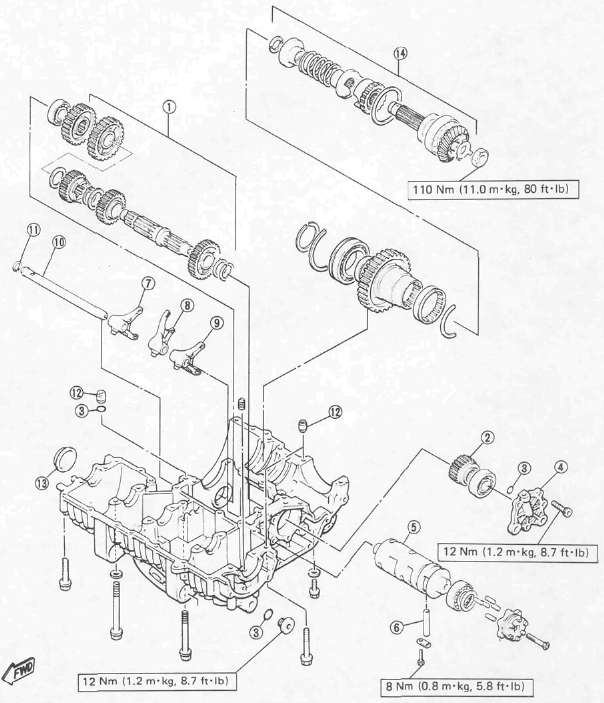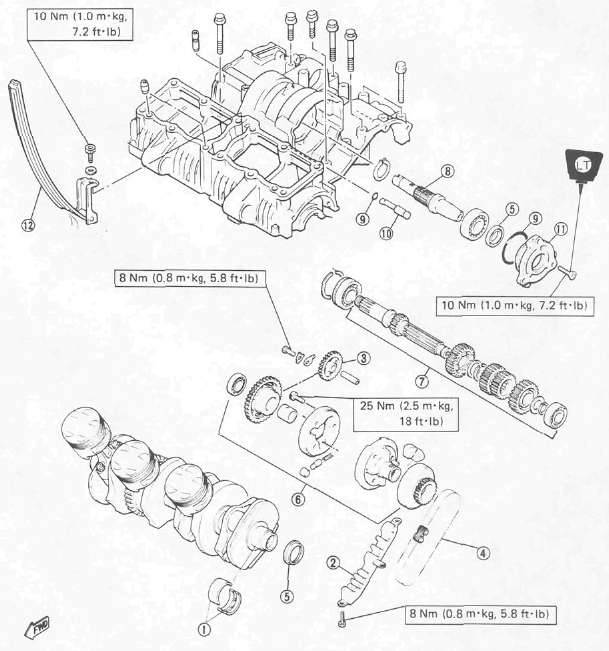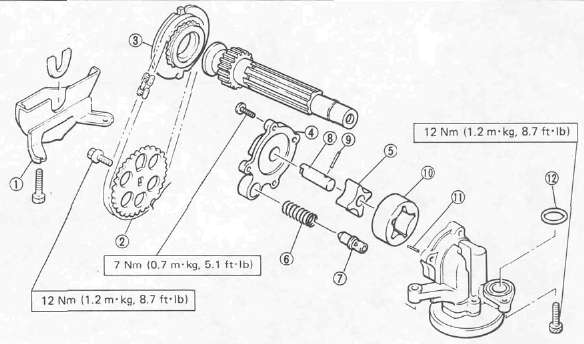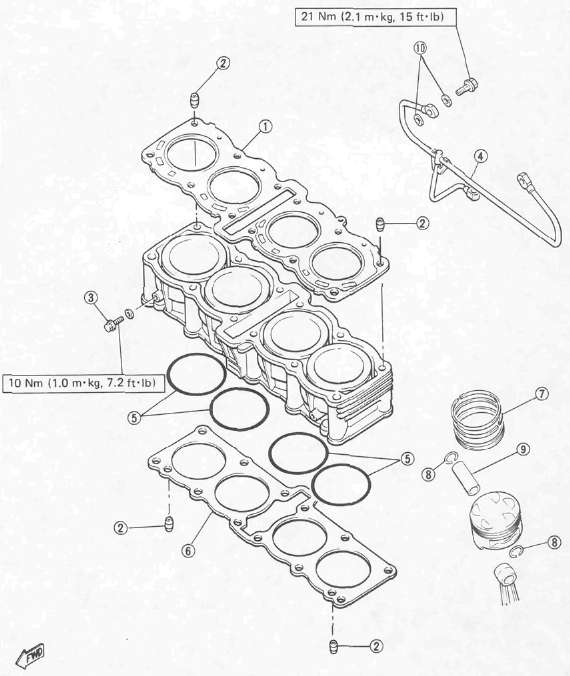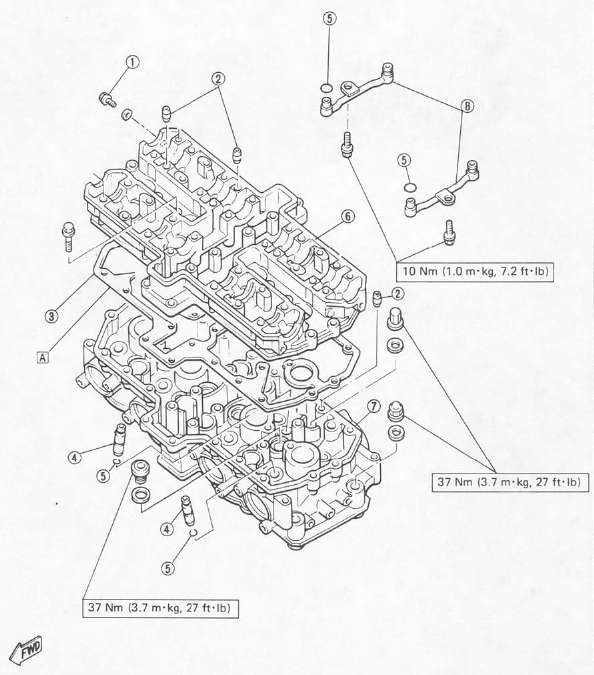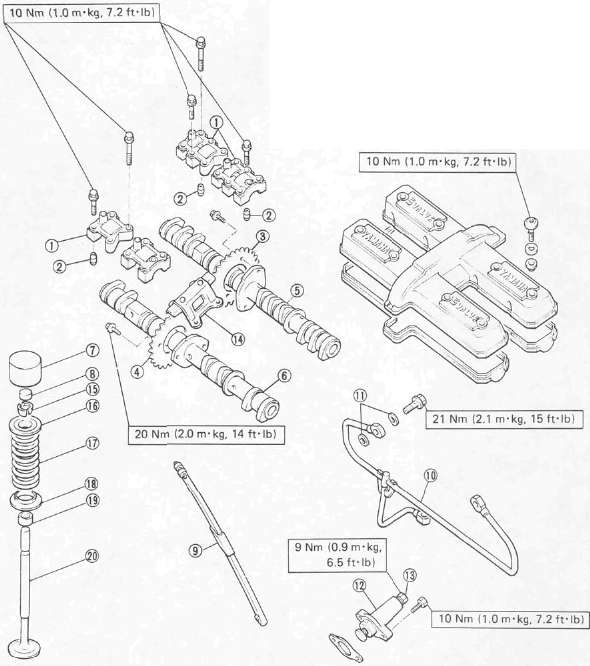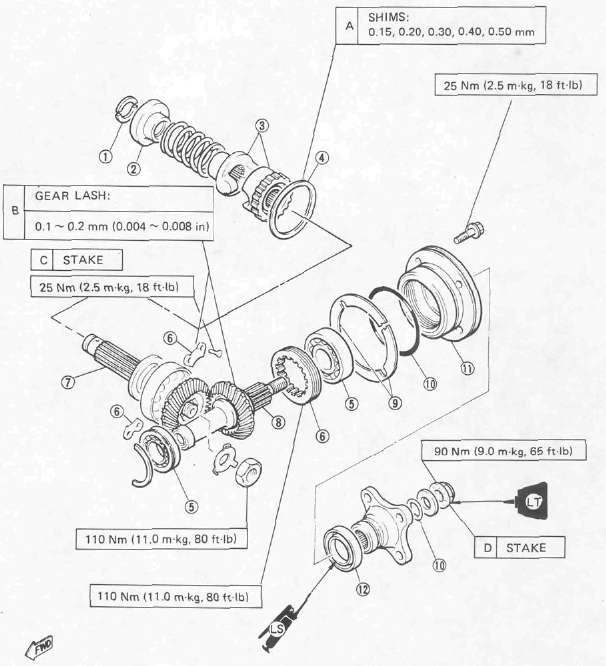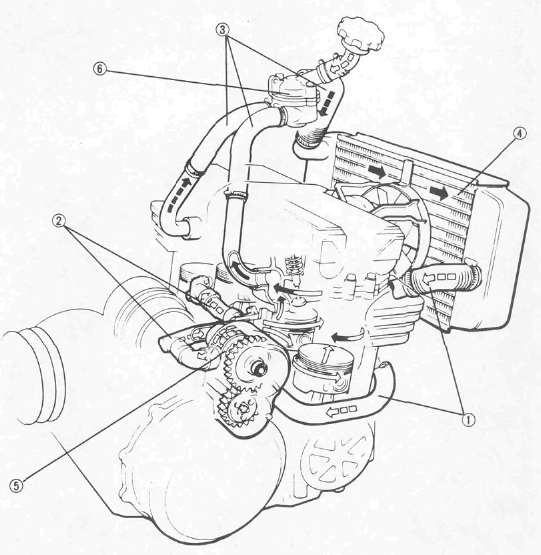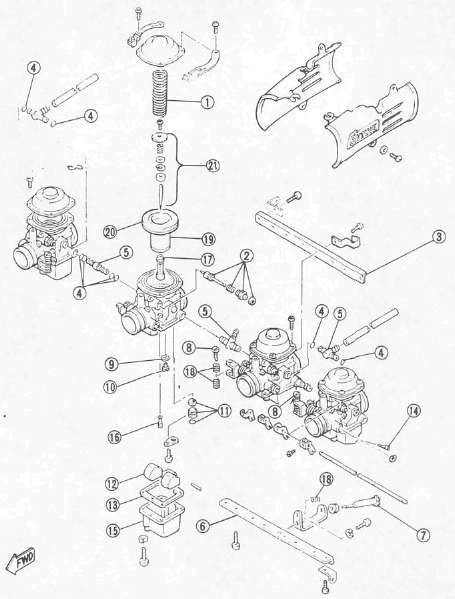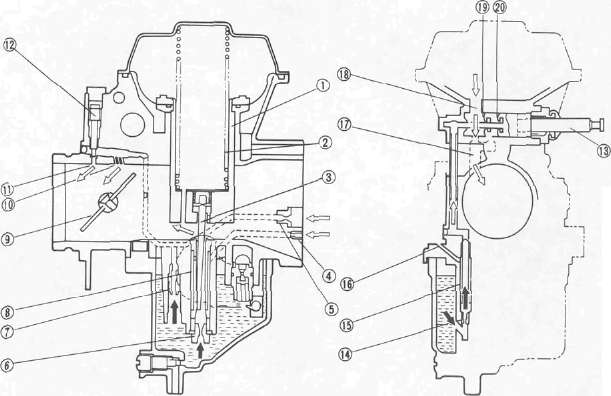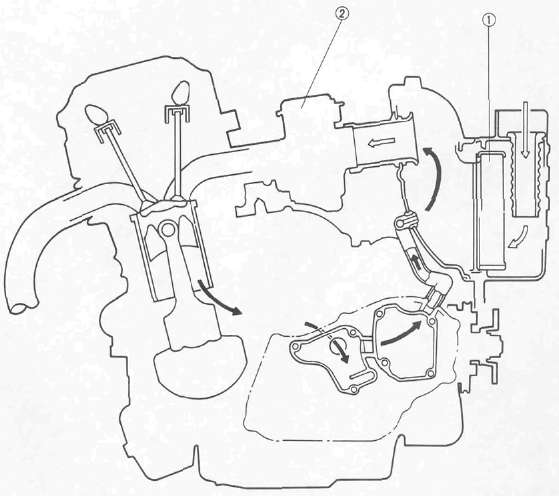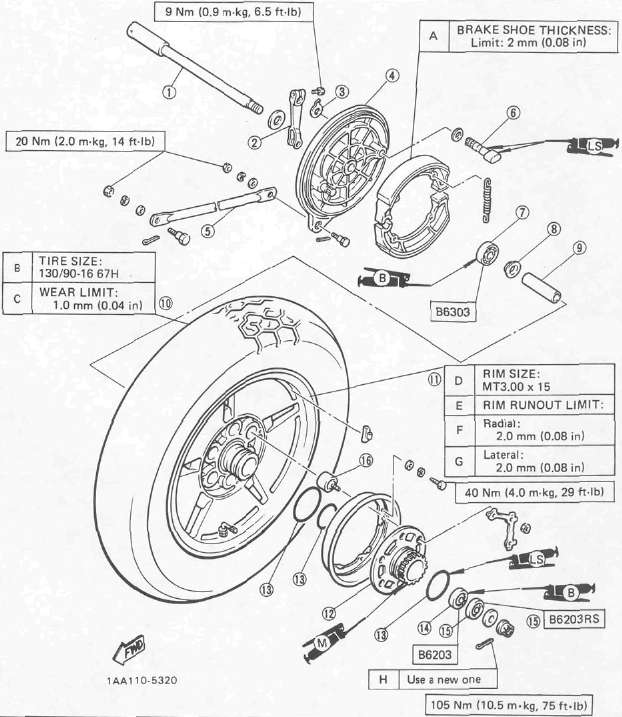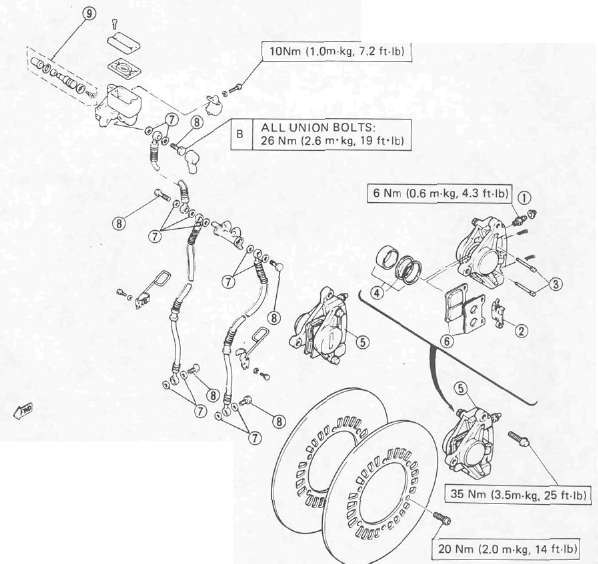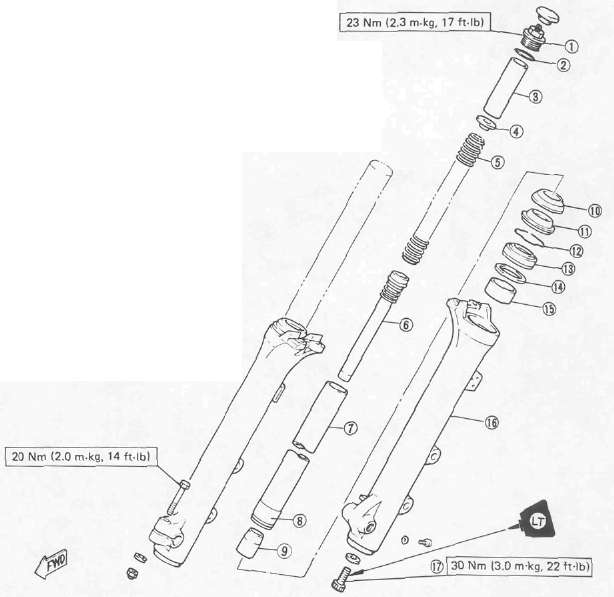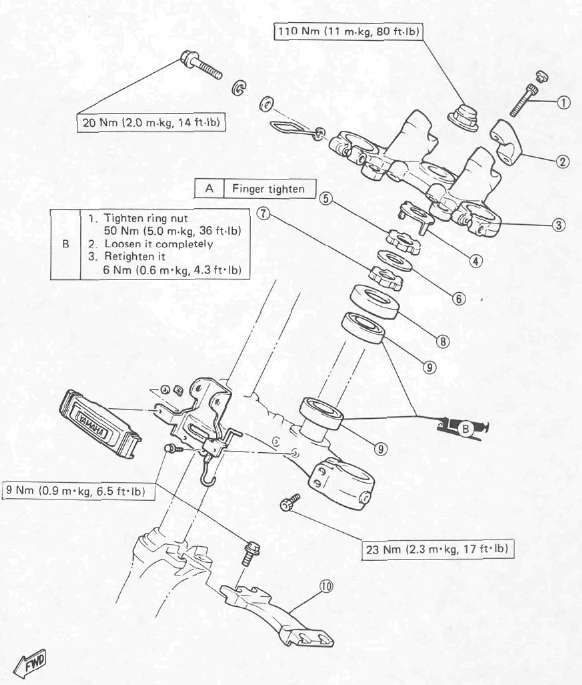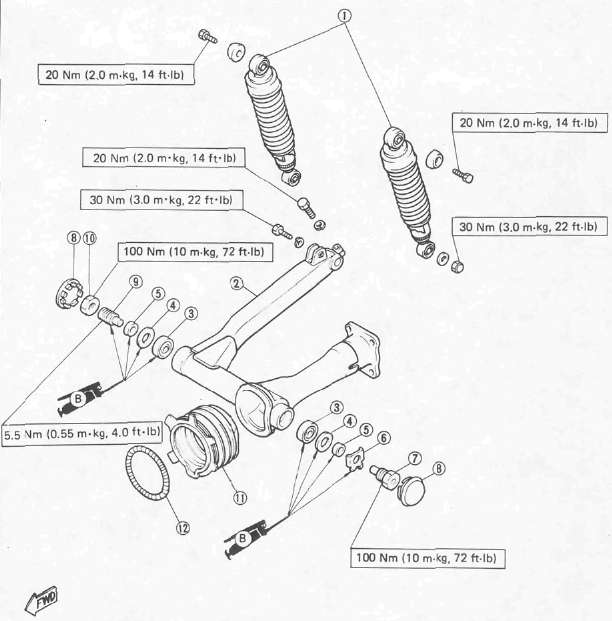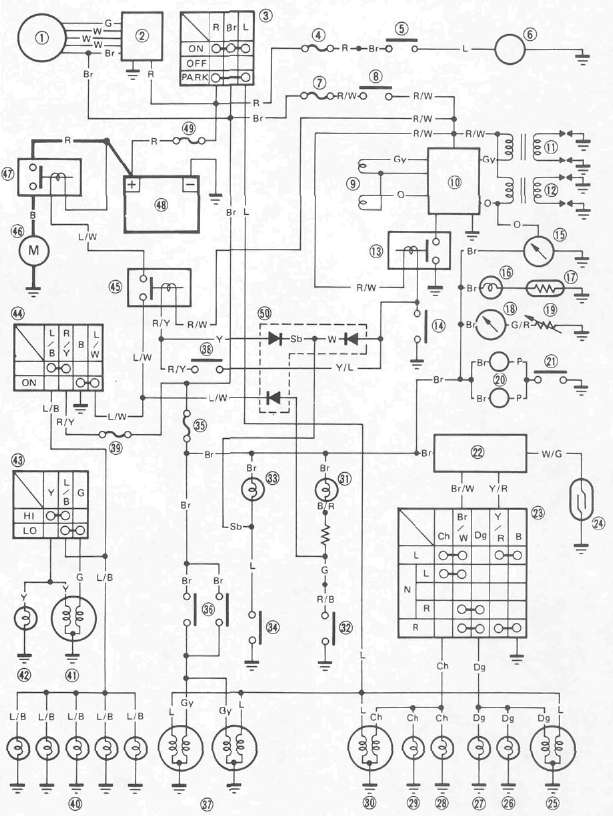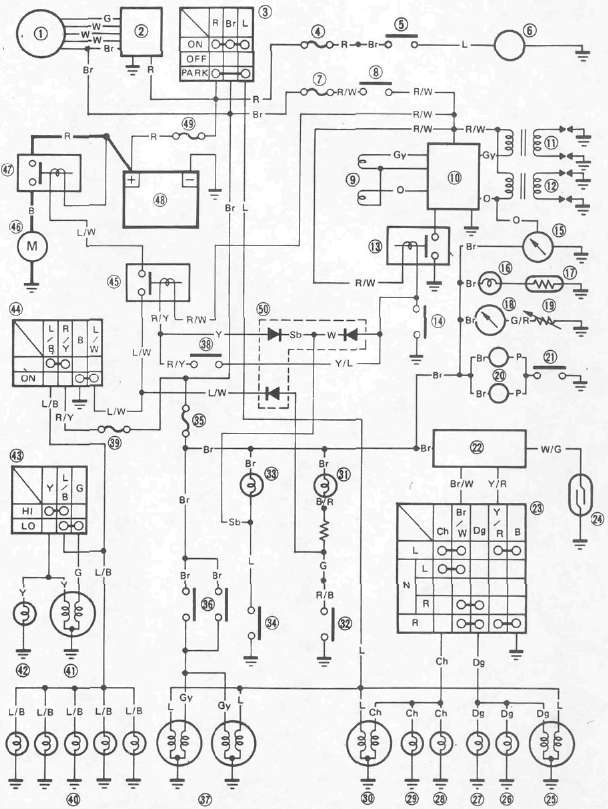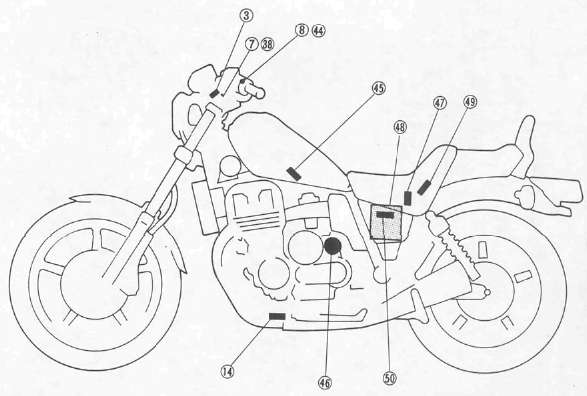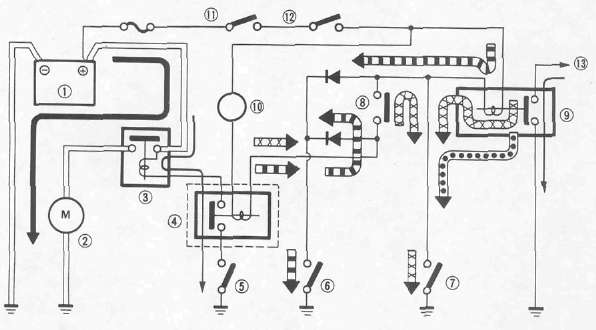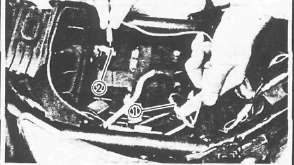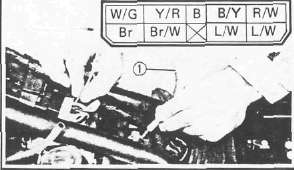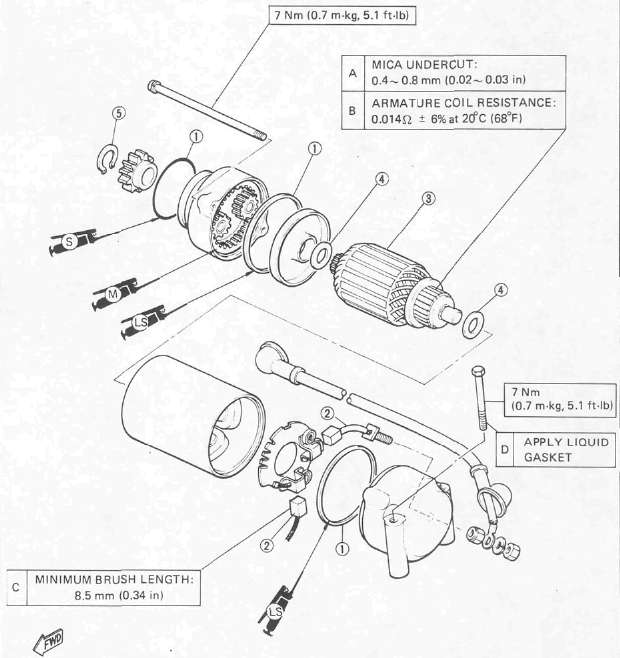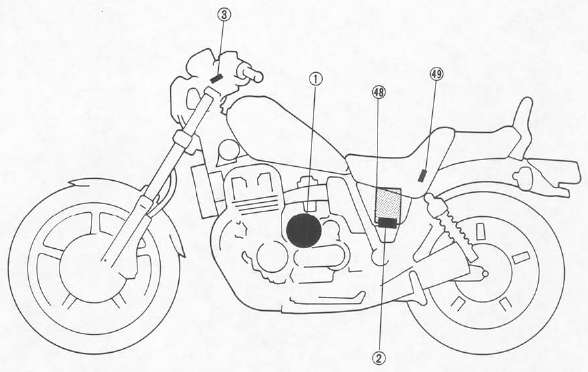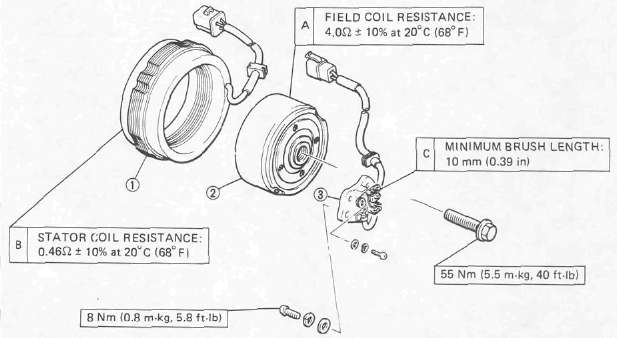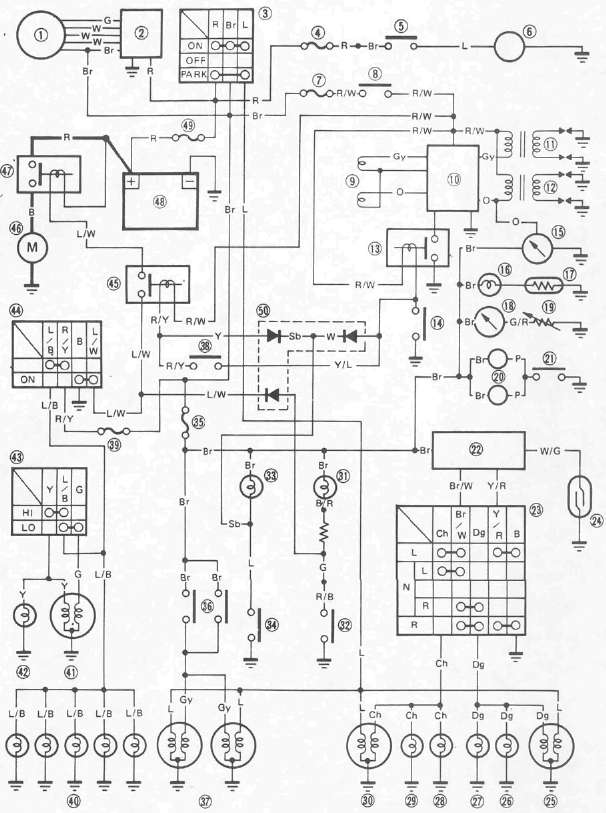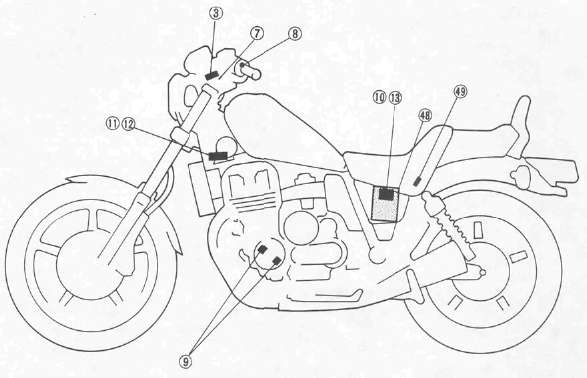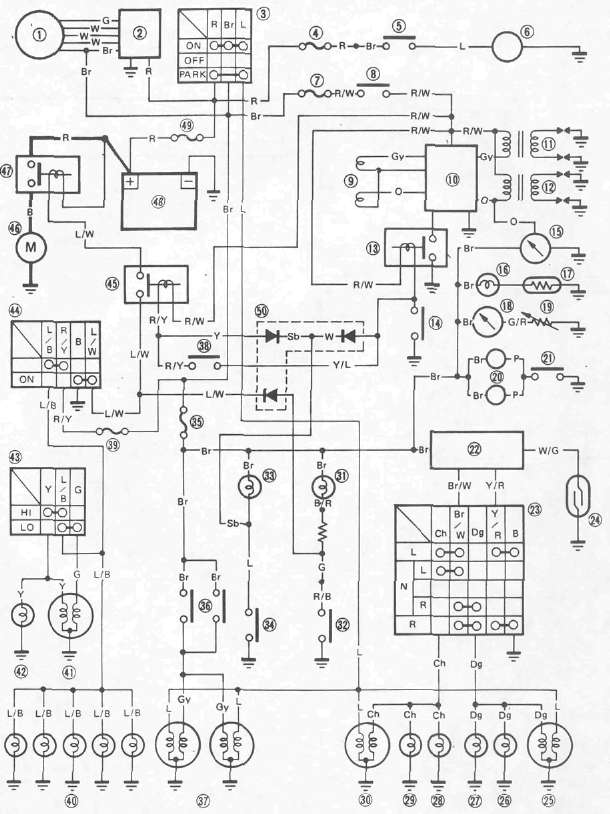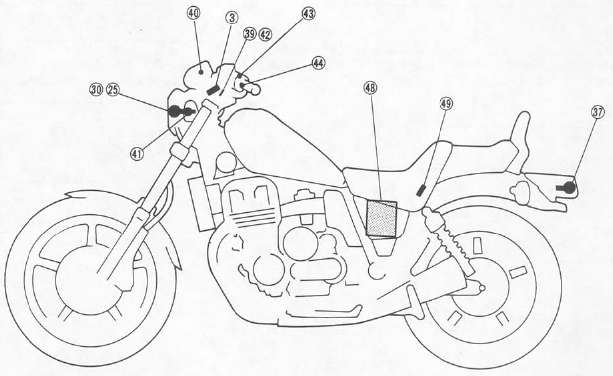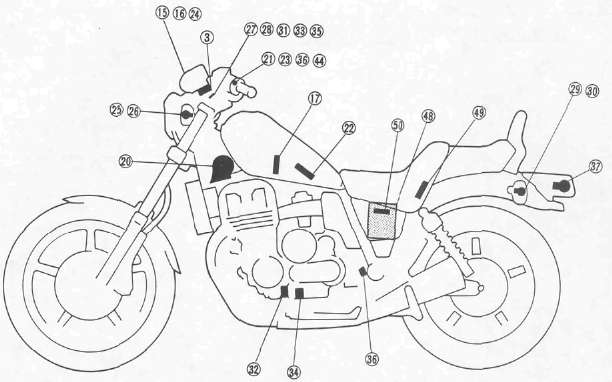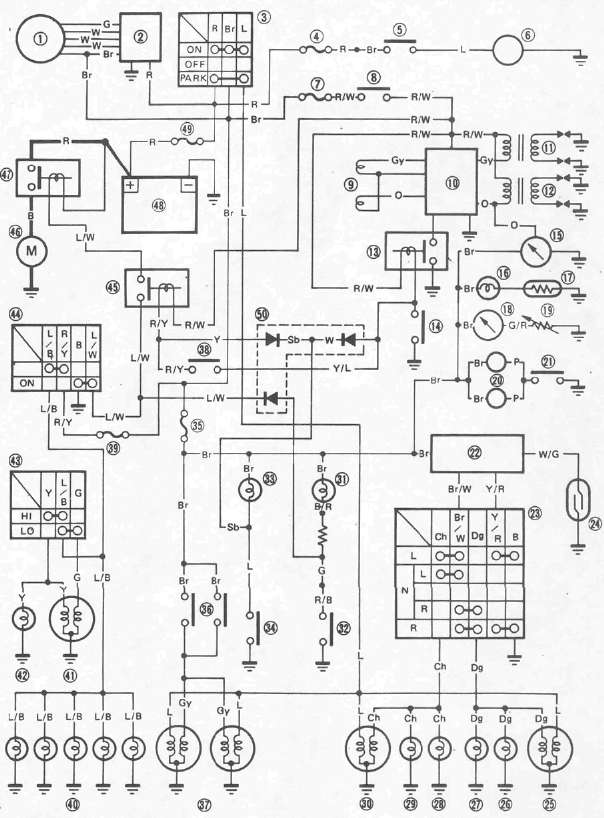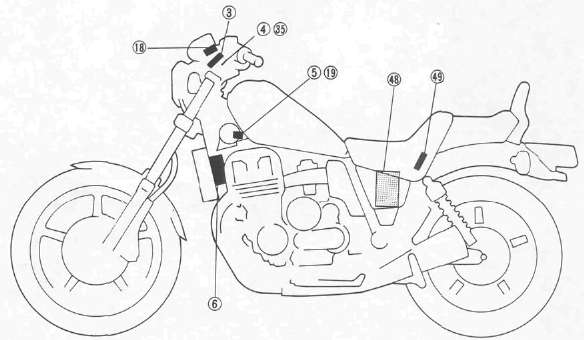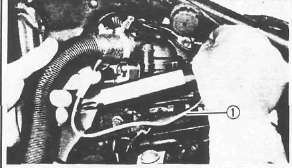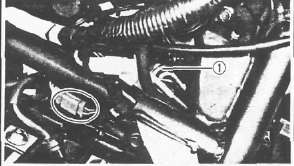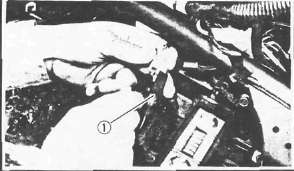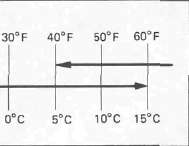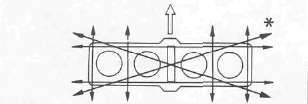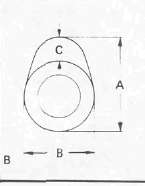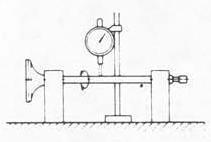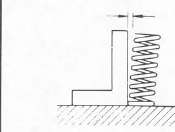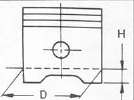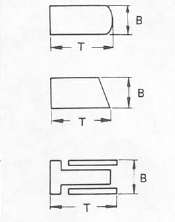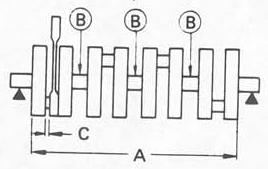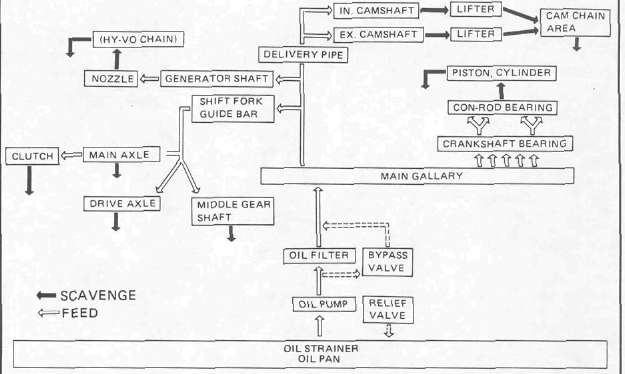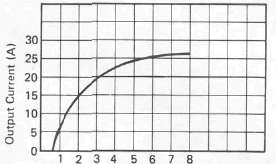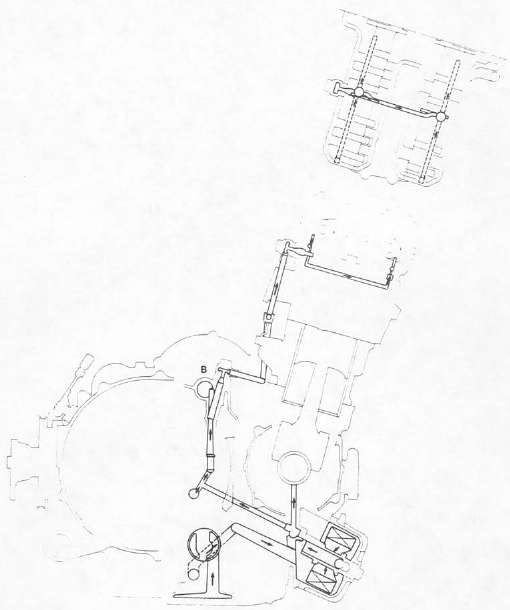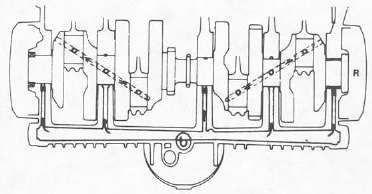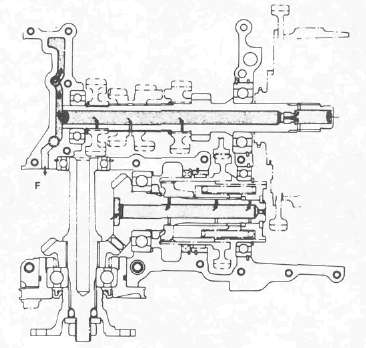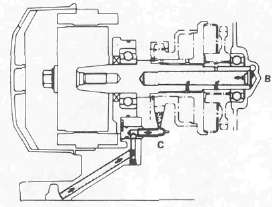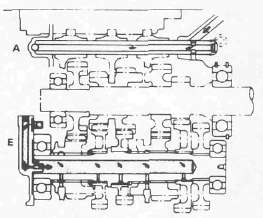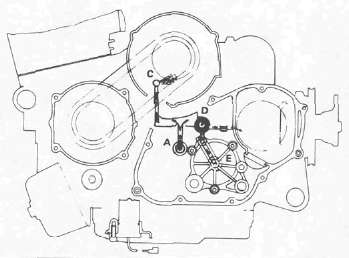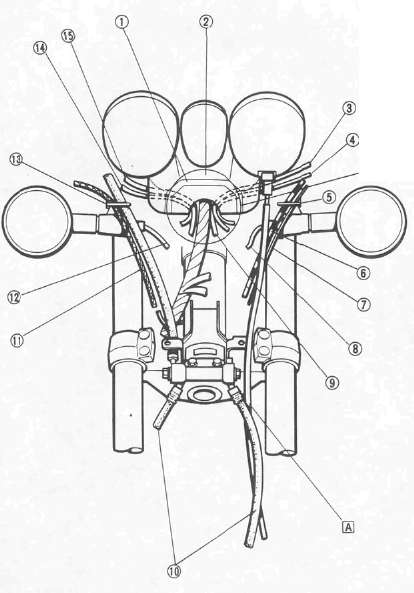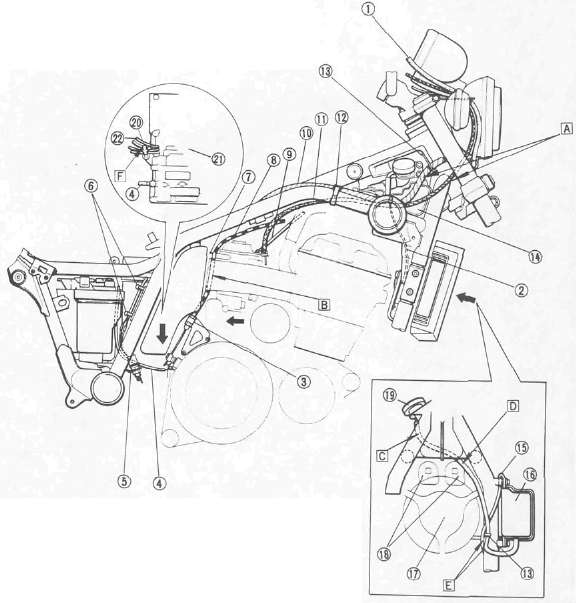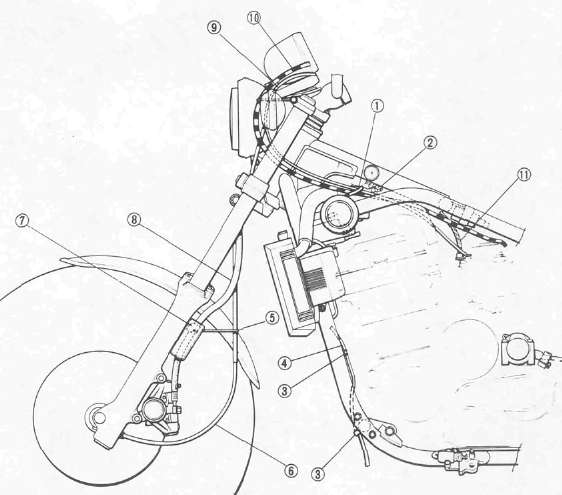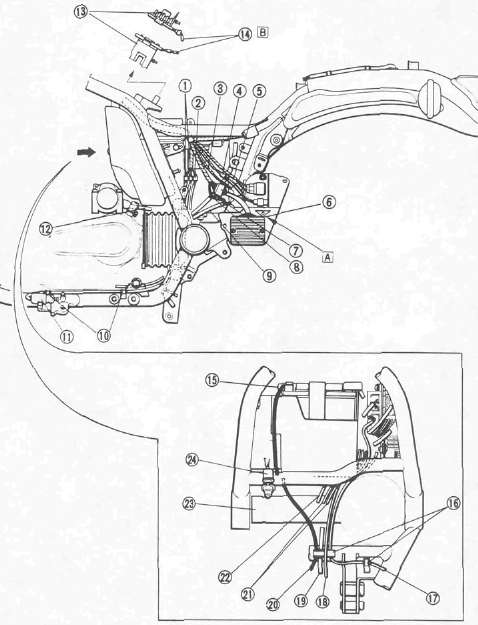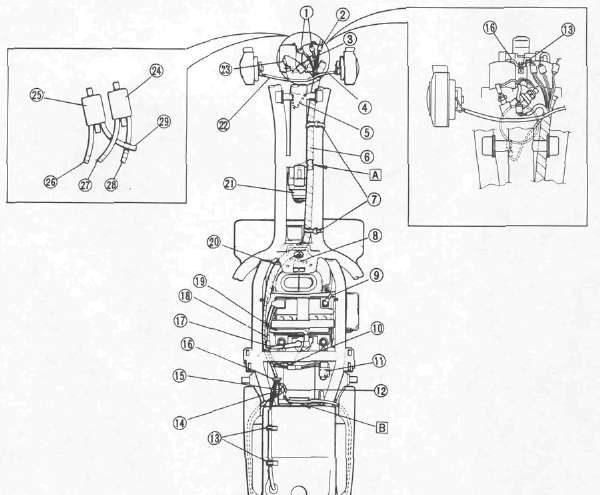XJ750XN Service Manual
XJ750XN Service Manual750 MaximX Service Manual
Chapter 1, GENERAL INFORMATION and SPECIAL TOOLS
Chapter 1, GENERAL INFORMATION and SPECIAL TOOLSGENERAL INFORMATION
MOTORCYCLE IDENTIFICATION
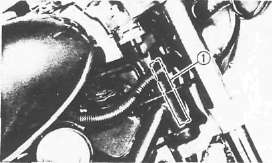
VEHICLE IDENTIFICATION NUMBER
The vehicle identification number is stamped into the right side of the frame.
NOTE:
The vehicle identification number is used to identify your motorcycle and may be used to register your motorcycle with the licensing authority in your state or province.
Starting Serial Number:
XJ750XN JYA1FL00 * FA000101
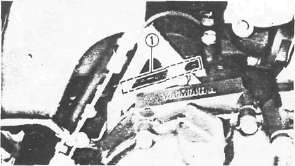
ENGINE SERIAL NUMBER
The engine serial number is stamped into the right side of the engine.
NOTE:
The first three digits of these numbers are for model identifications; the remaining digits are the unit production number.
Starting Serial Number:
XJ750XN 1FL-000101
NOTE:
Designs and specifications are subject to change without notice.
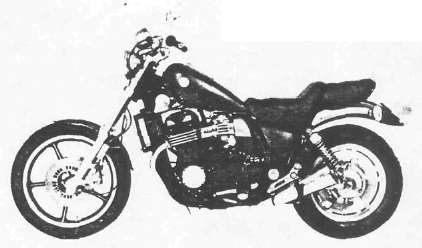
IMPORTANT INFORMATION
ALL REPLACEMENT PARTS
1. We recommend to use Yamaha genuine parts for all replacements. Use oil and/or grease recommended by Yamaha for assembly and adjustment.
GASKETS, OIL SEALS, AND O-RINGS
1. All gaskets, seals, and O-rings should be replaced when an engine is overhauled. All gasket surfaces, oil seal lips, and O-rings must be cleaned.
2. Properly oil all mating parts and bearings during reassembly. Apply grease to the oil seal lips.
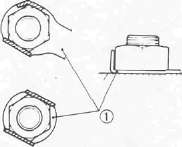
LOCK WASHERS/PLATES AND COTTER PINS
1. All lock washers/plates (1) and cotter pins must be replaced when they are removed. Lock tab(s) should be bent along the bolt or nut flat(s) after the bolt or nut has been properly tightened.
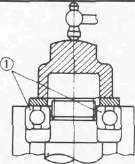
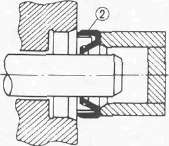
BEARINGS AND OIL SEALS
1. Install the bearing(s) (1) and oil seal(s) (2) with their manufacturer's marks or numbers facing outward. (In other words, the stamped letters must be on the side exposed to view.) When installing oil seal(s), apply a light coating of light-weight lithium base grease to the seal lip(s). Oil the bearings liberally when installing.
CAUTION:
Do not use compressed air to spin the bearings dry. This causes damage to the bearing surfaces.
CIRCLIPS
1.All circlips should be inspected carefully before reassembly. Always replace piston pin clips after one use. Replace distorted circlips. When installing a circlip © , make sure that the sharp-edged corner © is positioned opposite to the thrust (3) it receives. See the sectional view.
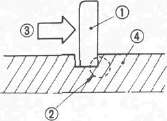
4.Shaft
SPECIAL TOOLS
The proper special tools are necessary for complete and accurate tune-up and assembly. Using the correct special tool will help prevent damage caused by the use of improper tools or improvised techniques.
FOR TUNE UP
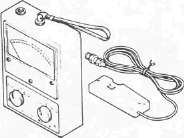
1. Inductive Tachometer P/N. 90890-03113 This tool is needed for detecting engine rpm.

2. Inductive Timing Light P/N. 90890-03109 This tool is necessary for checking ignition timing.
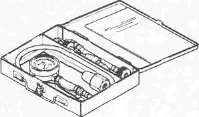
3. Compression Gauge P/N. 90890-03081
This gauge is used to measure the engine compression.

4. Fuel Level Gauge P/N. 90890-01312 This gauge is used to measure the fuel level in the float chamber.
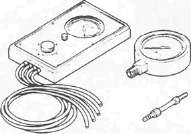
5. Vacuum gauge P/N. 90890-03094 This gauge is needed for carburetor synchronization.
FOR ENGINE SERVICE
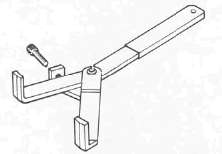
1. Universal Clutch Holder P/N. 90890-04086 This tool is used to hold the clutch when removing or installing the clutch boss locknut.
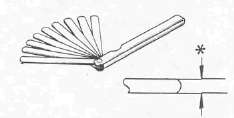
2. Thickness Gauge P/N. 90890-01399
This gauge is needed for measuring the valve clearance.
* Less than 8 mm (0.31 in)
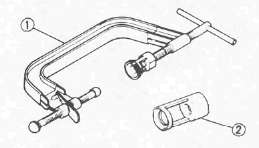
3. Valve Spring Compressor P/N. 90890-04019- (1)
Attachment P/N. 90890-04108- (2)
This tool is needed to remove and install the valve assemblies.
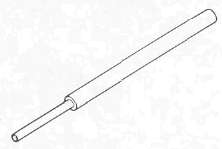
4. Valve Guide Remover (5.0 mm) P/N. 90890-04097
This tool is used to remove the valve guides.
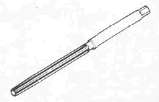
5. Valve Guide Reamer (5.0 mm) P/N. 90890-04099
This tool is used to rebore the new valve guide.

6. Valve Guide Installer P/N. 90890-04098
This tool is needed to install the valve guides properly.
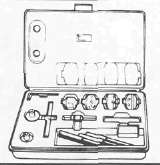
7. Valve Seat Cutter Set P/N.YM-91043
This tool is needed to resurface the valve seat.
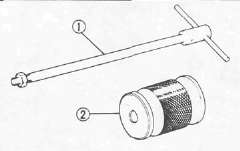
8. Armature Shock Puller P/N. 90890-01290- (1)
Weight P/N. 90890-01291 - (2)
These tools are used to remove the A.C.G. shaft.

9. Rotor Holding Tool P/N. 90890-04043
This tool is used to hold the A.C. Generator rotor during removal and installation.

10. Rotor Puller
P/N. 90890-01080 This tool is needed to remove the A.C. Generator rotor.

11. Rotor Puller Attachment
P/N. 90890-04052 This tool is needed when removing the A.C. Generator rotor together with the rotor puller.
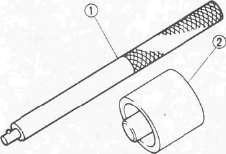
12. Water Pump Seal Installer
Handle P/N. 90890-04058- (1)
Adapter P/N. 90890-04078- (2)
This tool is needed for proper installation of the water pump seal.
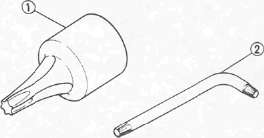
13. Torx Driver
#40 P/N. 90890-04049 - (1)
This tool is used to loosen or tighten the middle gear bearing retainer bolt.
#30 P/N. 90890-05245 - (2)
This tool is used to loosen or tighten the A.C.G. shaft cover.
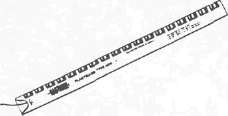
14. Plastigauge Set "Green"
P/N. YU-33210 This gauge is needed to measure the clearance for the connecting rod bearing.
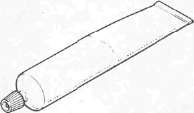
15. Yamaha Bond No. 1215
P/N. 90890-85505
This sealant (bond) is used for crankcase mating surfaces, etc.
FOR SHAFT DRIVE SERVICE
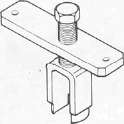
1. Middle Drive Pinion Holder
P/N. 90890-04051
This tool is needed when measuring gear lash.

2. Dial Gauge
P/N. 90890-03097
This gauge is used to measure gear lash.

3. Damper Spring Compressor
P/N. 90890-04090
This tool is needed to disassemble and reassemble the middle gear damper.
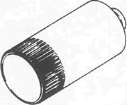
6. Middle-Drive-Shaft-Bearing-Retainer Wrench
P/N. 90890-04057
This tool is used to loosen or tighten the bearing retainer.
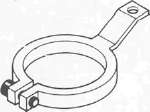
7. Final Gear Holding Tool
P/N. 90890-01254
This tool is needed when measuring gear lash.

8. Final-Drive Gear Lash Measurement Tool
P/N. 90890-01230
This tool is used to measure gear lash.
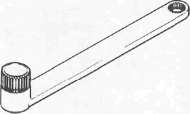
9. Middle and Final Gear Holding Tool
P/N. 90890-01229
This tool is used when measuring gear lash.

10. Final Drive Shaft Bearing Retainer Wrench
P/N. 90890-04050
This tool is used to remove and install the bearing retainer.
FOR CHASSIS SERVICE
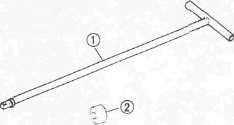
1.T-Handle
P/N. 90890-01326- (1)
Damper rod holder 22 mm
P/N. 90890-01365- (2)
This tool is used to loosen and tighten the front fork cylinder holding bolt.
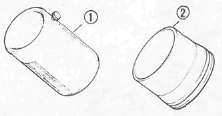
2. Front Fork Seal Driver (weight)
P/N. 90890-01367-(1)
Adapter (38 mm)
P/N. 90890-01372 -(2)
These tools are used when installing the fork seal.

3. Ring Nut Wrench
P/N. 90890-01268
This tool is used to loosen and tighten the steering ring nut.
FOR ELECTRICAL COMPONENTS
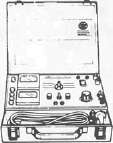
1. Electro Tester
P/N. 90890-03021
This instrument is necessary for checking the ignition system components.
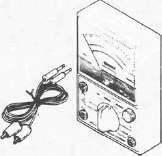
2. Pocket Tester
P/N. 90890-03112
This instrument is invaluable for checking the electrical system.
Chapter 2, MAINTENANCE
Chapter 2, MAINTENANCEINTRODUCTION
This chapter includes all information necessary to perform recommended inspections and adjustments. These preventive maintenance procedures, if followed, will ensure more reliable vehicle operation and a longer service life. The need for costly overhaul work will be greatly reduced. This information applies to vehicles already in service as well as new vehicles that are being prepared for sale. All service technicians should be familiar with this entire chapter.
Engine Maintenance
Engine MaintenanceValve Clearance Adjustment
Valve Clearance Adjustment
VALVE CLEARANCE ADJUSTMENT
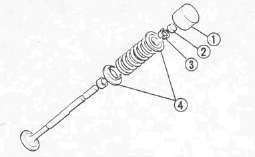
1 Valve lifter 2 Pad 3 Retainer 4 Spring seat
Valve Clearance (Cold):
Intake: 0.11 -0.20 mm (0.004- 0.008 in)
Exhaust: 0.21- 0.30 mm (0.008- 0.012 in)
Measurement
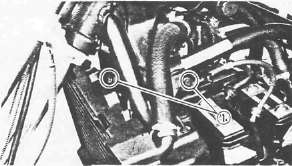
1. Remove:
• Seat
• Fuel tank
• Horns
• Ignition coil mount bolts (1)
2. Disconnect the spark plug caps
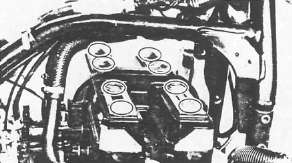
3. Remove:
• Ignition coils
• Spark plugs
• Cylinder head cover
• Left crankcase cover
4. Measure the valve clearance
NOTE:.
Be sure piston is at Top Dead Center (TDC) on compression stroke when measuring clearance.
Valve clearance measurement steps:
•Turn the crankshaft counterclockwise with a 19 mm (0.75 in) spanner.
NOTE:
Valve clearance must be measured when the engine is cool to the touch.
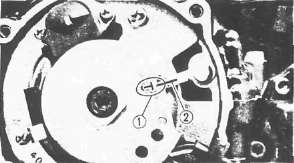
•Align the "T" mark (1) on the timing plate with the stationary pointer (2) . When the "T" mark is aligned with the stationary pointer (2) . the piston is at top dead center (TDC).
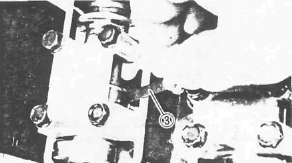
• Measure the valve clearance using a Feeler Gauge (3).
• Record the measured amount if the clearance is incorrect.
Intake Valve (cold): 0.11- 0.20 mm (0.004- 0.008in)
Exhaust Valve (cold): 0.21- 0.30 mm (0.008- 0.012 in)
Measure valve clearance, in sequence, for Nos. 2, 4, and No. 3 cylinders.
Out of specification - Adjust clearance.
Firing Sequence: 1 -2-4-3
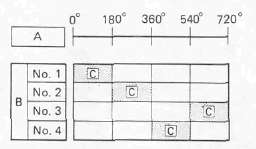
[A] Crankshaft counterclockwise turning angle. [Bl Cylinder [C] Combustion
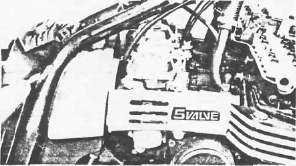
Adjustment
1. Remove carburetors Refer to CHAPTER 3 "ENGINE REMOVAL".
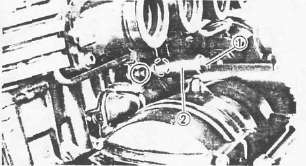
2. Loosen the cam chain tensioner end plug (1)
3. Remove the cam chain tensioner (2)
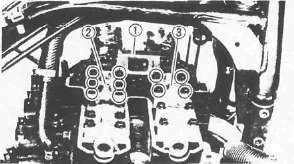
4. Remove:
•Cam chain guide (Upper) (1)
•Cam cap I3 (2)
•Cam cap E3 (3)
• Dowel pins
5. Remove:
•Cam chain sprocket bolts
•Cam caps
•Dowel pins
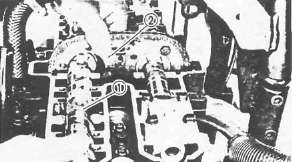
•Cam shafts (1)
•Cam chain sprockets (2)
NOTE:
Fasten safety wire to the cam chain to prevent it from falling into the crankcase.
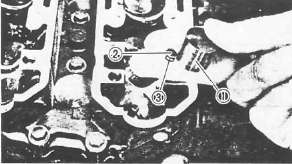
6. Remove:
• Valve lifter (1)
• Pad (2)
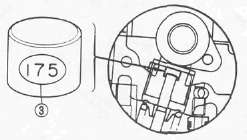
Note the installed pad number (3). Round off the value as required:
|
Pad range |
Pad Availability: 25 increments |
|
|
No. 120 ~ No. 240 |
1.20 mm (0.047 in) 2.40 mm (0.094 in) |
Pads stepped in 0.05 mm (0.002 in) increments |
|
Note: Thickness of each pad is marked on the pad side wall. |
||
|
• Round off the hundredths digit of the installed pad number to the nearest 0.05 mm increment. |
||
|
Hundredths digit |
Rounded valve |
|
|
0 or 2 |
0 |
|
|
5 |
(NOT ROUNDED OFF) |
|
|
8 |
10 |
|
7. Select the proper pad from the appropriate chart (next 2 pages, links below)
EXAMPLE:
Installed pad number = 175 (1.75 mm)
Rounded off digit = 175
NOTE:
Pads can only be selected in 0.05 mm (0.02 in) increments.
* Locate the "Rounded off Pad Number" on the chart, and then find the measured valve clearance. The point where these coordinates intersect is the new pad number.
NOTE:
Use the new pad number as a guide only as the number must be verified.
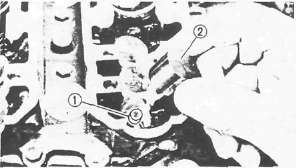
8. Install:
• Pad (1)
• Valve lifter (2)
• Cam shaft
• Cam chain sprocket
Refer to CHAPTER 3 "ENGINE ASSEMBLY"
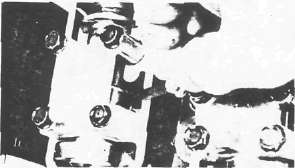
9. Recheck the valve clearance.
If the clearance is incorrect, repeat all of the clearance adjustment steps until the proper clearance is obtained.
Assembly
1. Reverse removal steps.
Inspect the head cover gasket and replace it if damaged.
2. Tighten:
• Cylinder head cover bolts
• Fuel tank bolts
Head Cover Bolt: 10 Nm (1.0 m.kg, 7.2 ft-lb)
Fuel Tank Bolt: 10 Nm (1.0 m.kg, 7.2 ft-lb)
Exhaust Valve Shim Chart
Exhaust Valve Shim ChartEXHAUST
MEASURED CLEARANCE | INSTALLED PAD NUMBER | |||||||||||||||||||||||||
120 | 125 | 130 | 135 | 140 | 145 | 150 | 155 | 160 | 165 | 170 | 175 | 180 | 185 | 190 | 195 | 200 | 205 | 210 | 215 | 220 | 225 | 230 | 235 | 240 | ||
0.00-0.02 |
|
|
|
| 120 | 125 | 130 | 135 | 140 | 145 | 150 | 155 | 160 | 165 | 170 | 175 | 180 | 185 | 190 | 195 | 200 | 205 | 210 | 215 | ||
0.03-0.07 |
|
|
|
| 120 | 125 | 130 | 135 | 140 | 145 | 150 | 155 | 160 | 165 | 170 | 175 | 180 | 185 | 190 | 195 | 200 | 205 | 210 | 215 | 220 | |
0.08-0.12 |
|
|
| 120 | 125 | 130 | 135 | 140 | 145 | 150 | 155 | 160 | 165 | 170 | 175 | 180 | 185 | 190 | 195 | 200 | 205 | 210 | 215 | 220 | 225 | |
0.13-0.17 |
|
| 120 | 125 | 130 | 135 | 140 | 145 | 150 | 155 | 160 | 165 | 170 | 175 | 180 | 185 | 190 | 195 | 200 | 205 | 210 | 215 | 220 | 225 | 230 | |
0.18-0.20 |
| 120 | 125 | 130 | 135 | 140 | 145 | 150 | 155 | 160 | 165 | 170 | 175 | 180 | 185 | 190 | 195 | 200 | 205 | 210 | 215 | 220 | 225 | 230 | 235 | |
0.21-0.30 | RECOMMENDED CLEARANCE | |||||||||||||||||||||||||
0.31-0.32 | 125 | 130 | 135 | 140 | 145 | 150 | 155 | 160 | 165 | 170 | 175 | 180 | 185 | 190 | 195 | 200 | 205 | 210 | 215 | 220 | 225 | 230 | 235 | 240 |
| |
0.33-0.37 | 130 | 135 | 140 | 145 | 150 | 155 | 160 | 165 | 170 | 175 | 180 | 185 | 190 | 195 | 200 | 205 | 210 | 215 | 220 | 725 | 230 | 735 | 240 |
| ||
0.38-0.42 | 135 | 140 | 145 | 150 | 155 | 160 | 165 | 170 | 175 | 180 | 185 | 190 | 195 | 200 | 205 | 210 | 215 | 220 | 225 | 230 | 235 | 240 |
| |||
0.43-0.47 | 140 | 145 | 150 | 155 | 160 | 165 | 170 | 175 | 180 | 185 | 190 | 195 | 200 | 205 | 210 | 215 | 220 | 225 | 230 | 235 | 240 |
| ||||
0.48-0.52 | 145 | 150 | 155 | 160 | 165 | 170 | 175 | 180 | 185 | 190 | 195 | 200 | 205 | 210 | 215 | 220 | 225 | 230 | 235 | 240 |
| |||||
0.53-0.57 | 150 | 155 | 160 | 165 | 170 | 175 | 180 | 185 | 190 | 195 | 200 | 205 | 210 | 215 | 220 | 225 | 730 | 235 | 740 |
| ||||||
0.58-0.62 | 155 | 160 | 165 | 170 | 175 | 180 | 185 | 190 | 195 | 200 | 205 | 210 | 215 | 220 | 225 | 230 | 235 | 240 |
| |||||||
0.63-0.67 | 160 | 165 | 170 | 175 | 180 | 185 | 190 | 195 | 200 | 205 | 210 | 215 | 220 | 225 | 230 | 235 | 240 |
| ||||||||
0.68-0.72 | 165 | 170 | 175 | 180 | 185 | 190 | 195 | 200 | 205 | 210 | 215 | 220 | 225 | 230 | 235 | 240 |
| |||||||||
0.73-0.77 | 170 | 175 | 180 | 185 | 190 | 195 | 200 | 205 | 210 | 215 | 220 | 225 | 230 | 235 | 240 |
| ||||||||||
0.78-0.82 | 175 | 180 | 185 | 190 | 195 | 200 | 205 | 210 | 215 | 220 | 225 | 230 | 235 | 240 |
| |||||||||||
0.83-0.87 | 180 | 185 | 190 | 195 | 200 | 205 | 210 | 215 | 220 | 225 | 230 | 235 | 240 |
| ||||||||||||
0.88-0.92 | 185 | 190 | 195 | 200 | 205 | 210 | 215 | 220 | 225 | 230 | 235 | 240 |
| |||||||||||||
0.93-0.97 | 190 | 195 | 200 | 205 | 210 | 215 | 220 | 225 | 230 | 235 | 240 |
| ||||||||||||||
0.98-1.02 | 195 | 200 | 205 | 210 | 215 | 220 | 225 | 230 | 235 | 240 | VALVE CLEARANCE (cold): 0.21 - 0.30 mm (0.008 - 0.012 in) Example: Installed is 175 Measured clearance is 0.35 mm (0.014 in) Replace 175 pad with 185 pad | |||||||||||||||
1.03-1.07 | 200 | 205 | 210 | 215 | 220 | 225 | 230 | 235 | 240 |
| ||||||||||||||||
1.08-1.12 | 205 | 210 | 215 | 220 | 225 | 230 | 235 | 240 |
| |||||||||||||||||
1.13-1.17 | 210 | 215 | 220 | 225 | 230 | 235 | 240 |
| ||||||||||||||||||
1.18-1.22 | 215 | 220 | 225 | 230 | 235 | 240 |
| |||||||||||||||||||
1.23-1.27 | 220 | 225 | 230 | 235 | 240 |
| ||||||||||||||||||||
1.28-1.32 | 225 | 230 | 235 | 240 |
| |||||||||||||||||||||
1.33-1.37 | 230 | 235 | 240 |
| ||||||||||||||||||||||
1.38-1.42 | 235 | 240 |
| |||||||||||||||||||||||
| 1.43-1.47 | 240 | |||||||||||||||||||||||||
Intake Valve Shim Chart
Intake Valve Shim ChartINTAKE
MEASURED CLEARANCE | INSTALLED PAD NUMBER | ||||||||||||||||||||||||
120 | 125 | 130 | 135 | 140 | 145 | 150 | 155 | 160 | 165 | 170 | 176 | 180 | 185 | 190 | 195 | 200 | 205 | 210 | 215 | 220 | 225 | 230 | 235 | 240 | |
0.00-0.02 |
|
|
| 120 | 125 | 130 | 135 | 140 | 145 | 150 | 155 | 160 | 165 | 170 | 175 | 180 | 185 | 190 | 195 | 200 | 205 | 210 | 215 | 220 | 225 |
0.03-0.07 |
|
| 120 | 125 | 130 | 135 | 140 | 145 | 150 | 155 | 160 | 165 | 170 | 175 | 180 | 185 | 190 | 195 | 200 | 205 | 210 | 215 | 220 | 225 | 230 |
0.08-0.10 |
| 120 | 125 | 130 | 135 | 140 | 145 | 150 | 155 | 160 | 165 | 170 | 175 | l80 | 185 | 190 | 195 | 200 | 205 | 210 | 215 | 220 | 225 | 230 | 235 |
0.11-0.20 | RECOMMENDED CLEARANCE | ||||||||||||||||||||||||
0.21-0.22 | 125 | 130 | 135 | 140 | 145 | 150 | 155 | 160 | 166 | 170 | 175 | 180 | 185 | 190 | 19b | 200 | 205 | 210 | 215 | 220 | 225 | 230 | 235 | 240 |
|
0.23-0.27 | 130 | 135 | 140 | 145 | 150 | 155 | 160 | 165 | 170 | 175 | 180 | 185 | 190 | 195 | 200 | 205 | 210 | 215 | 220 | 225 | 230 | 235 | 240 |
| |
0.28-0.32 | 135 | 140 | 145 | 150 | 155 | 160 | 165 | 170 | 175 | 180 | 185 | 190 | 195 | 200 | 205 | 210 | 215 | 220 | 225 | 230 | 235 | 240 |
| ||
0.33-0.37 | 140 | 145 | 150 | 155 | 160 | 165 | 170 | 175 | 180 | 185 | 190 | 195 | 200 | 205 | 210 | 215 | 220 | 225 | 230 | 235 | 240 |
| |||
0.38-0.42 | 145 | 150 | 155 | 160 | 165 | 170 | 175 | 180 | 185 | 190 | 195 | 200 | 205 | 210 | 215 | 220 | 225 | 230 | 235 | 240 |
| ||||
0.43-0.47 | 150| | 155 | 160 | 165 | 170 | 175 | 180 | 185 | 190 | 195 | 200 | 205 | 210 | 215 | 220 | 225 | 230 | 235 | 240 |
| |||||
0.48-0.52 | 155 | 160 | 165 | 170 | 175 | 180 | 185 | 190 | 195 | 200 | 205 | 210 | 215 | 220 | 225 | 230 | 235 | 240 |
| ||||||
0.53-0.57 | 160 | 165 | 170 | 175 | 180 | 18b | 190 | 195 | 200 | 205 | 210 | 215 | 220 | 225 | 230 | 235 | 240 |
| |||||||
0-58-0.62 | 165 | 170 | 175 | 180 | 185 | 190 | 195 | 200 | 205 | 210 | 215 | 220 | 225 | 230 | 235 | 210 |
| ||||||||
0.63-0.67 | 170 | 175 | 180 | 185 | 190 | 195 | 200 | 205 | 210 | 215 | 220 | 225 | 230 | 235 | 240 |
| |||||||||
0.68-0.72 | 175 | 180 | 185 | 190 | 195 | 200 | 205 | 210 | 215 | 220 | 225 | 230 | 235 | 240 |
|
| |||||||||
0.73-0.77 | 180 | 185 | 190 | 195 | 200 | 205 | 210 | 215 | 220 | 225 | 230 | 235 | 240 |
| |||||||||||
0.78-0.82 | 185 | 190 | 195 | 200 | 205 | 210 | 215 | 220 | 225 | 230 | 235 | 240 |
| ||||||||||||
0.83-0.87 | 190 | 195 | 200 | 205 | 210 | 215 | 220 | 225 | 230 | 235 | 240 |
| |||||||||||||
0.88-0.92 | 195 | 200 | 205 | 210 | 215 | 220 | 225 | 230 | 235 | 240 |
| ||||||||||||||
0.93-0.97 | 200 | 205 | 210 | 215 | 220 | 225 | 230 | 235 | 240 |
| |||||||||||||||
0.98-1.02 | 205 | 210 | 215 | 220 | 225 | 230 | 235 | 240 | VALVE CLEARANCE (cold): 0.11 -0.20 mm (0.004 - 0.008 in) Example: Installed is 175 Measured clearance is 0.24 mm (0.009 in) Replace 175 pad with 185 pad | ||||||||||||||||
1.03-1.07 | 210 | 215 | 220 | 225 | 230 | 235 | 240 |
| |||||||||||||||||
1.08-1.12 | 215 | 220 | 225 | 230 | 235 | 240 |
| ||||||||||||||||||
1.13-1.17 | 220 | 225 | 230 | 235 | 240 |
| |||||||||||||||||||
1.18-1.22 | 225 | 230 | 235 | 240 |
| ||||||||||||||||||||
1.23-1.27 | 230 | 235 | 240 |
| |||||||||||||||||||||
1.28-1.32 | 235 | 240 |
| ||||||||||||||||||||||
1.33-1.37 | 240 |
|
| ||||||||||||||||||||||
Spark Plug, Crankcase Ventilation, Fuel Line and Exhaust
Spark Plug, Crankcase Ventilation, Fuel Line and ExhaustSPARK PLUG
1. Remove spark plugs
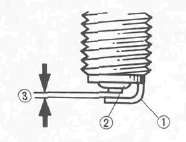
2. Inspect:
• Electrode (1) for wear/damage.
• Insulator color (2)
3. Measure the plug gap (3) using a Wire Gauge or Feeler Gauge. Regap as reqired.
Plug Gap: 0.6 - 0.7 mm (0.024 - 0.028 in)
Clean the plug with a spark plug cleaner if necessary.
Standard Spark Plug: D8EA (NGK) X24ES-U (NIPPONDENSO)
Before installing a spark plug, clean the gasket surface and plug surface.
4. Tighten Spark plug(s) to 17.5 Nm (1.75 m-kg, 12.5 ft-lb)
NOTE:
Finger-tighten the spark plug(s) before torquing to specification.
CRANKCASE VENTILATION SYSTEM
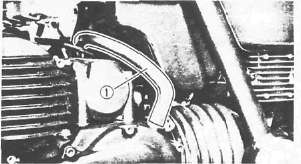
1. Inspect the crankcase ventilation hose (1). Replace damaged hoses.
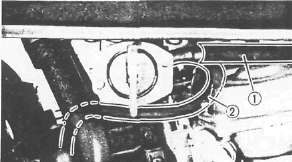
FUEL LINE
1. Inspect:
• Fuel hose (1)
• Vacuum hose (2)
Replace damaged hoses.
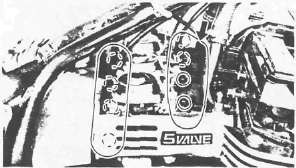
INTAKE MANIFOLD
1. Tighten:
• Carburetor clamps
• Carburetor joint bolts
2. Inspect:
• Carburetor joint
• Gaskets
Replace if necessary.
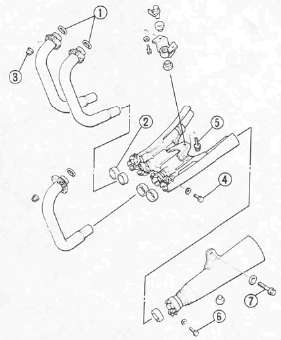
EXHAUST SYSTEM
1. Inspect:
•Exhaust pipe gasket(s) (1)
• Muffler clamp gasket(s) (2)
Damage > Replace.
Exhaust gas leakage > Repair.
2. Tighten:
• Exhaust pipe bolts
• Muffler bolts
Exhaust Pipe Flange (3) :10 Nm(1.0m-kg, 7.2ft-b)
Exhaust Pipe Clamp (4) :20 Nm (2.0 m-kg, 14 ft-lb)
Exhaust Chamber Mount (5): 25 Nm (2.5 m-kg, 18 ft-lb)
Muffler Clamp (6): 20 Nm (2.0 m-kg, 14 ft-lb)
Muffler Bracket (7) 20 Nm (2.0 m-kg, 14 ft-lb)
Carburettor - Idle speed and Synchronization
Carburettor - Idle speed and SynchronizationIDLE SPEED
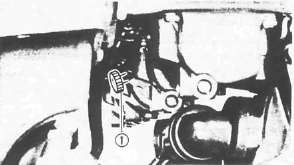
1. Adjust the idle speed. Warm up the engine and turn the throttle stop screw (1) to adjust.
Idle Speed:
1,050 ± 50 r/min
CARBURETOR SYNCHRONIZATION
Carburetor Adjustment
Carburetors must be set properly before synchronizing the carburetors.
NOTE:
Valve clearance must be set properly before synchronizing the carburetors.
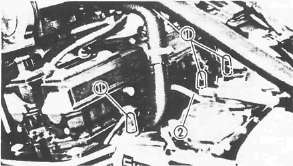
1. Remove:
• Seat
• Fuel tank
2. Disconnect:
• Vacuum plugs (1)
• Vacuum hose (2)
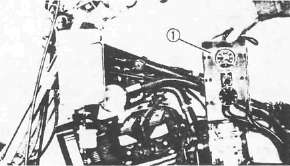
3. Install:
• Vacuum Gauge (90890-03094)(1)
• Suitable test fuel tank
4. Start the engine and let it warm up.
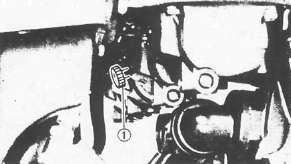
5. Turn throttle stop screw (1) to adjust idle speed to 1,050 ± 50r/min.
6. Adjust carburetor synchronization
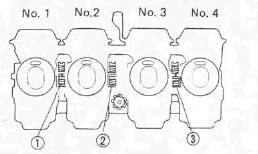
Carburetor synchronization adjustment steps:
•Synchronize the carburetor No. 1 to the carburetor No. 2 by turning the synchronizing screw "1" until the both gauge readings are the same.
•Rev. the engine for a fraction of a second, two or three times, and check the synchronization again.
Vacuum Pressure at Idle Speed: 24 kPa (180 mm Hg, 7.1 in Hg)
Vacuum Synchronous Difference: 0.7 kPa (5 mm Hg, 0.2 in Hg)
• Repeat the above steps to synchronize the carburetor No. 4 to the carburetor No.3 by turning the synchronizing screw " 3 " until the both gauge readings are the same.
• Repeat the same steps to synchronize No. 3 carburetor to No. 2 carburetor, then turn synchronizing screw " 2 " until both gauge readings are the same.
Engine Oil
Engine OilENGINE OIL
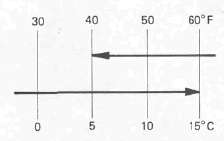
At 5°C(40°F) or Higher: Yamalube 4-Cycle Oil or SAE 20W40 Type SE Motor Oil
At15°C(60°F) or Lower: SAE 10W30 Type SE Motor Oil
Note:
recommended engine oil classification; API Service "SE", "SF" type or equivalent (e.g. "SF-SE", "SF-SE-CC", "SF-SE-SD" etc.)
Oil Level Measurement
1. Check the oil level. Add as required.
Oil level visual inspection steps:
•Place the motorcycle on its centerstand and warm up the engine for several minutes.
NOTE:
Position the motorcycle straight up when checking oil level, a slight tilt to the side can produce false readings.
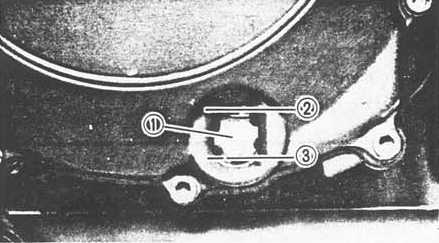
• Stop the engine and visually check the oil level through the level window (1) .
(2) Maximum
(3) Minimum
Oil Change (Without filter)
1. Warm up the engine for several minutes, then place a receptacle under the engine.
2. Remove: The oil filler cap
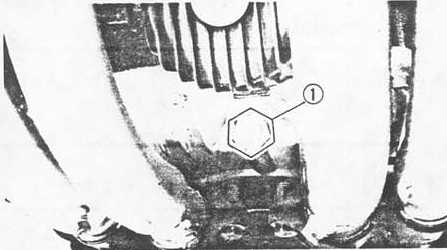
3. Remove the drain plug (1) and drain the engine oil.
4. Replace and tighten the drain plug
Engine Drain Plug: 43 Nm (4.3 m-kg, 31 fMb)
5. Fill the crankcase with engine Oil: 2.5 L (2.2 Impqt, 2.6 US qt)
CAUTION:
Do not allow foreign material to enter the crank-case.
6. Install the filler cap
Oil Change (With filter)
1. Warm up the engine and place a receptacle under the engine.
2. Remove:
• Oil filler cap
• Drain plug
Drain the engine oil.
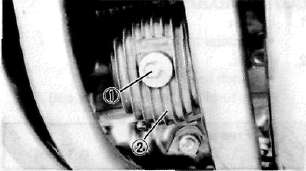
3. Remove:
• Oil filter bolt (1)
• Filter cover (2)
4. Replace and tighten the drain plug
Engine Drain Plug:
43 Nm (4.3 m-kg, 31 ftlb)
5. Install:
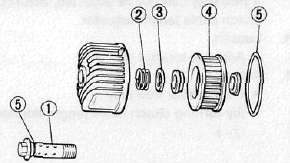
• Oil filter bolt 1
• Spring 2
• Washer 3
• Oil filter (New) 4
• O-ring 5 (x2, one on bolt, one on cover)
• Oil filter assembly
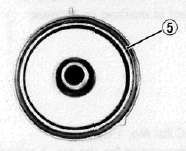
NOTE:
• Be sure the O-ring 5 is positioned properly.
• Fit the filter cover projection into the crank-case cover slot.
6. Tighten the oil filter bolt
Oil Filter Bolt: 15 Nm (1.5 nvkg. 11 ftlb)
7. Fill the crankcase with Engine Oil: 2.8 L (2.5 imp qt, 3.0 US qt)
8. Install the oil filler cap
9. Warm up the engine and check for oil leaks. Stop the engine instantly if leaking occurs.
10. Check the oil level
Level low — Add sufficient oil.
Coolant
CoolantCOOLANT
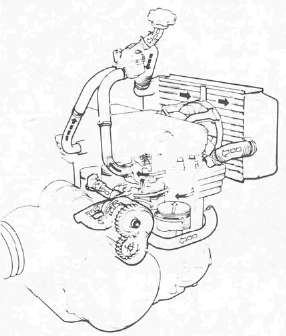
Recommended Coolant:
High Quality Ethylene Glycol Antifreeze Containing Anti-corrosion for Aluminum Engine Inhibitors Coolant and Water
Mixed Ratio: 50%/50%
Total amount: 2.4 L (2.11 Imp qt, 2.54 US qt)
Reservoir Tank Capacity: 0.49 L (0.43 Imp qt, 0.52 US qt)
From "LOW" to "FULL" Level: 0.14 L (0.12 Imp. qt, 0.15USqt)
WARNING:
Do not remove the radiator cap when the engine and radiator are hot. Scalding hot fluid and steam may be blown out under pressure, which could cause serious injury.
When the engine has cooled, open the radiator can by the following procedure: Place a thick rag, like a towel, over the radiator cap, slowly rotate the cap counterclockwise to the detent. This procedure allows any residual pressure to escape. When the hissing sound has stopped, press down on the cap while turning counterclockwise and remove it.
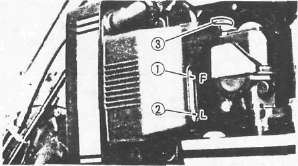
(1) "FULL" level (2) "LOW" level
Coolant Level Check
1. Check:
•Coolant level Coolant level low > Add sufficient coolant.
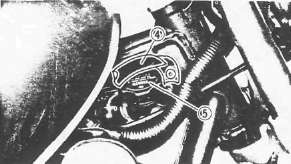
2. Remove:
• Reservoir tank cap (3)
• Cap retainer (4)
• Radiator cap (5)
3. Add:
• Coolant
Clutch Adjustment
Clutch AdjustmentCLUTCH ADJUSTMENT
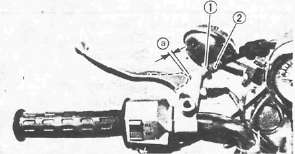
1. Loosen the adjuster locknut (1)
2. Adjust the clutch lever free play (a) by turning adjuster (2) in or out.
Free Play (a): 2 - 3mm (0.08-0.12 in)
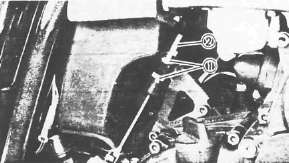
3. If free play can not be adjusted, adjust by clutch cable length adjuster.
4. Loosen the adjuster locknuts (1)
5. Adjust clutch lever free play (a) by turning clutch cable length adjuster (2)
Ignition Timing Check
Ignition Timing CheckIGNITION TIMING CHECK
1. Check: • Ignition timing

Ignition timing check steps:
• Remove the cover.
• Connect Timing Light (90890-03109) (1) to No. 1 cylinder spark plug lead.
•Warm up the engine and let it idle at the specified idle speed of 1,050 ± 50 r/min.
• Visually check the stationary pointer in the timing window to verify it is within the required firing range indicated on the flywheel.

Incorrect firing - Check timing plate and/or pickup assembly (tightness damage). Refer to CHAPTER 7, "ELECTRICAL" for further information.
(1) TDC for No. 1 cylinder
(2) Firing range for the No. 1 cylinder
1. Check:
• Ignition timing
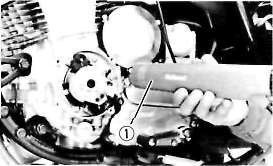
Ignition timing check steps:
• Remove the cover.
• Connect the Timing Light (YU-08037) (1) to No. 1 cylinder spark plug lead.
• Warm up the engine and let it idle at the specified idle speed of 1.050 ± 50 r/min.
• Visually check the upper pickup coil mark (T) is within the firing range (2) indicated on timing plate.
Incorrect firing — Check timing plate and/or pickup assembly (tightness damage)
Refer to CHARTER 6. "ELECTRICAL" for further information.
Compression Pressure Measurement
Compression Pressure MeasurementNOTE:
Insufficient compression pressure will result in performance loss.
1. Measure the valve clearance. Adjust as necessary.
2. Warm up the engine.
3. Remove the spark plugs
4. Measure the compression pressure
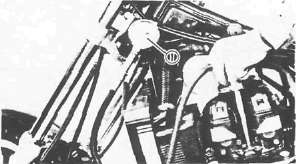
Compression pressure measurement steps:
• Install the Compression Gauge (90890-03081) (1) using an adapter.
• Crank over the engine with the electric starter (be sure the battery is fully charged) with the throttle wide-open until the compression reading on the gauge stabilizes.
• Check readings with specified levels (See chart).
Compression Pressure (at sea level):
Standard: 1,059 kPa (10.8 kg/cm2, 154 psi)
Minimum: 1,098 kPa (11.2 kg/cm2, 159 psi)
Maximum: 1,138 kPa (11.6 kg/cm2, 165 psi)
WARNING:
When cranking the engine, ground all of the spark plug leads to prevent sparking.
• Repeat the previous steps for the other cylinders.
• If pressure falls below the minimum level:
1) Squirt a few drops of oil into the affected cylinder.
2) Measure the compression again.
Compression Pressure (with oil introduced into cylinder)
|
Higher than without oil |
Worn or damaged pistons |
|
Same as without oil |
Defective ring(s), valves, cylinder head gasket or piston is possible. |
|
Above maximum level |
Inspect cylinder head, valve surfaces, or piston crown for carbon deposits. |
NOTE:
The different between the highest and lowest cylinder compression readings must not vary more than the specified value.
Difference between Each Cylinder: Less than 98 kPa (1 kg/cm2, 14 psi)
Chassis Maintenance
Chassis MaintenanceFinal Gear Oil and Air Filter
Final Gear Oil and Air Filter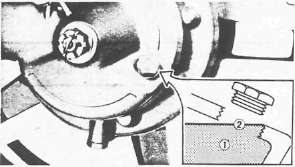
(1) Oil
FINAL GEAR OIL Oil Level Measurement
1. Place the motorcycle on a level area and place on its centerstand.
2. Remove the oil filler cap
3. Observe the oil level (2) and add oil if necessary.
NOTE:
Oil level must be up to the brim of the filler hole.
CAUTION:
Be sure that no foreign material enters the final gear case.
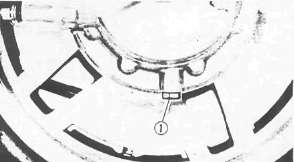
Gear Oil Replacement
1. Place a receptacle under the final gear case.
WARNING:
Spilling oil on the tires or on the ground under the tires will reduce traction and may result in an accident. Use a funnel, stiff piece of card, plastic or similar to ensure all oil is directed into the receptacle.
2. Remove the filler cap and drain plug (1). Drain final gear oil into the receptacle.
3. Re-install the drain plug. Torque to 23 Nm (2.3 m-kg, 17 ft-lb).
4. Fill the gear case to the specified level.
Final Gear Oil: SAE 80 API "GL-4" Hypoid gear oil
Oil Capacity: 0.20 L (0.18 Imp qt, 0.21 US qt)
NOTE:.
If desired, an SAE 80W90 Hypoid gear oil may be used for all conditions.
5. Install the filler cap. Torque cap to 23 Nm (2.3 m-kg, 17 ft-lb)
AIR FILTER
1. Remove the seat, fuel tank and rubber cover.
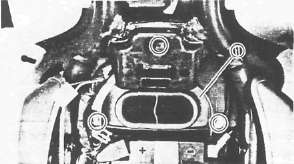
2. Remove the air filter cover (1)
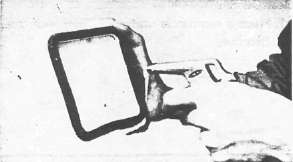
3. Eliminate dust using compressed air.
Note:
Blow out dust from the inside out.
4. Inspect the element and replace if damaged.
CAUTION:
The engine should never be run without the air/filter element installed; excessive piston and/or cylinder wear may result.
5. Install the element back in the airbox. Installation steps are the reverse of removal.
CAUTION:
Make sure the element cover fits into the corresponding filter case edge.
Brakes
BrakesFRONT BRAKE
Brake Fluid Inspection
1. Check the Brake fluid level. Replenish as required.
NOTE:
Use only DOT 3 or equivalent fluid from a sealed container.
WARNING:
Be sure that:
•Water does not enter the master cylinder when refilling.
•Spilled fluid is cleaned up immediately to prevent painted surfaces or plastic parts from eroding.
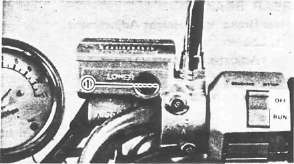
(1) Lower level
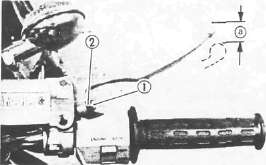
Front Brake Lever Free Play Adjustment
1. Loosen the adjuster locknut (1)
2. Adjust the free play (a) by turning the adjuster (2) until the free play (a) is within the specified limits.
Brake Lever Free Play (a): 2- 5 mm (0.08- 0.20 in)
CAUTION:
Proper lever free play is essential to avoid excessive brake drag.
3. Tighten the adjuster locknut
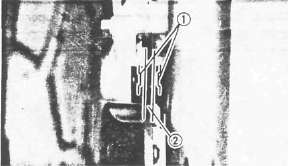
Brake Pad Inspection
1. Activate the brake lever.
2. Inspect the wear indicator (1). If the indicator almost contacts disc (2), replace pads. Refer to "CHASSIS."
REAR BRAKE
Rear Brake Pedal Height Adjustment
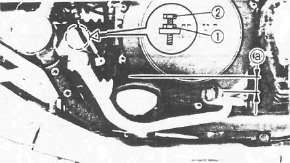
1. Loosen the adjuster locknuts (1)
2. Adjust the brake pedal height (a) by turning the adjuster (2) until the brake pedal position is at the specified height.
Brake Pedal Height (a): 10 mm (0.4 in) Below the Top of the Footrest
WARNING:
Adjust pedal height, then adjust brake pedal free play.
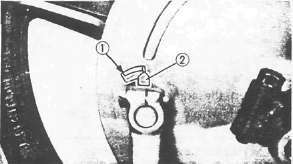
(1) Wear limit line
Rear Brake Shoe Inspection
1. Depress brake pedal.
2. Inspect the wear indicator (2). if the indicator is at wear limit line (1), replace brake shoes.
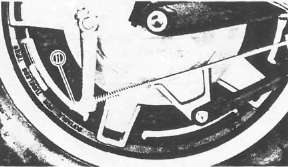
Rear Brake Pedal Free Play Adjustment
1. Rotate the adjuster nut (1). Turn it clockwise or counterclockwise until proper brake pedal free play is attained.
Brake Pedal Free Play: 20-30 mm (0.8-1.2 in)
WARNING:
Check to verify correct brake light operation after adjustment.
Brake Light Switch Adjustment
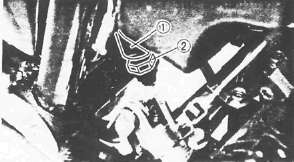
1. Hold the switch body (1) with your hand so that it does not rotate and turn the adjusting nut (2) .
Cable inspection and lubrication
Cable inspection and lubricationCable inspection and lubrication steps:
• Remove the two screws that secure throttle housing to handlebar.
• Hold cable end high and apply several drops of lubricant to cable.
• Coat metal surface of disassembled throttle twist grip with suitable all-purpose grease to minimize friction.
•Check for damage to cable insulation. Replace any corroded or obstructed cables.
• Lubricate any cables that do not operate smoothly.
Yamaha Chain and Cable Lube or SAE 10W30 Motor Oil
BRAKE AND SHIFT PEDALS/ BRAKE AND CLUTCH LEVERS
Lubricate pivoting parts of each lever and pedal.
Yamaha Chain and Cable Lube or SAE 10W30 Motor Oil
CENTERSTAND AND SIDESTAND
Lubricate centerstand and sidestand at their pivot points.
Yamaha Chain and Cable Lube or SAE 10W30 Motor Oil
Suspension Adjustments and Oil Change
Suspension Adjustments and Oil ChangeFRONT FORK OIL CHANGE
WARNING:
Securely support the motorcycle so there is no danger of it falling over.
1. Place a suitable stand under the engine to raise the front wheel off the ground.
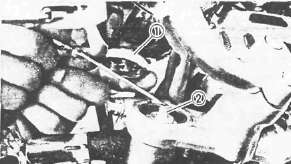
2. Remove the air valve cap (1)
NOTE:
Keep the valve (2) open by pressing it for several seconds so that the air can be let out of the inner tube.
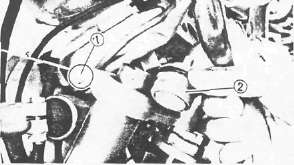
3. Loosen the inner tube pinch bolt (1)
4. Remove the cap bolt (2)
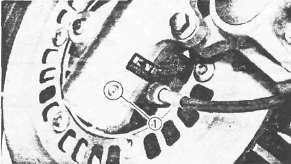
5. Remove the drain screw (1). Drain the fork oil.
WARNING:
Do not allow any oil to contact the disc brake components. If oil is discovered, be sure to remove it, otherwise diminished braking capacity and damage to the rubber components of the brake assembly will occur.
6. Inspect:
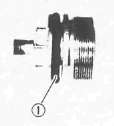
•O-ring (1) (Cap-bolt)
•Gasket (Drain bolt screw)
Replace if worn or damaged.
7. Install the drain screw
8. Fill the front forks.
Each Fork:
389 cm3 (13.7 Imp oz, 13.2 US oz)
After filling purnp the forks slowly up and down to distribute the oil.
9. Tighten the cap-bolt and pinch bolt
Cap Bolt: 23 Nm (2.3m.kg, 17 ft-lb)
Pinch Bolt: 20 Nm (2.0 m-kg, 14 ft-lb)
10. Pressurize Fork with specified amount of air. Refer to "Front fork adjustment".
11. Install the fork cap
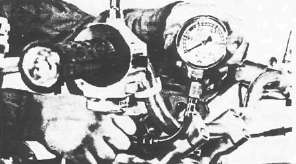
Maximum Air Pressure: 118 kPa (1.2 kg/,cm 17.1 psi) Do not exceed this amount.
FRONT FORK ADJUSTMENT
1. Place motorcycle on centerstand, then elevate front wheel.
NOTE:
Be sure there is no weight on the front end of the motorcycle and the fork tube is at room temperature when air pressure is checked and adjusted.
2. Remove the fork cap
3. Measure the air pressure with an air gauge and adjust as needed.
NOTE:
Increased air pressure causes stiffer suspension; decreased pressure causes softer suspension.
CAUTION:
Do not use a high pressure air supply that will overpressurize the forks faster than the operator can control. Use only a manual pump or low pressure supply to avoid seal damage.
|
Air Pressure Adjustment |
|
|
To increase air pressure |
Use manual air pump or pressurized air supply. |
|
To decrease air pressure |
Release air by pushing valve pin. |
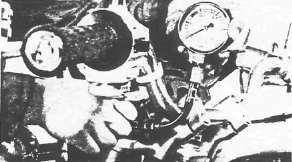
Standard Air Pressure: 39.2 kPa (0.4 kg/cm3, 5.7 psi)
Maximum Air Pressure: 118 kPa (1.2 kg/cm2, 17.1 psi)
Minimum Air Pressure: Zero
4. Install the Fork cap
REAR SHOCK ABSORBER ADJUSTMENT
If the spring seat is raised, the spring becomes stiffer, and if lowered, it becomes softer.
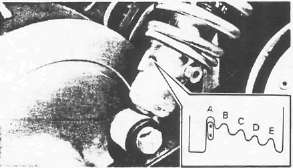
Standard Position: A A. - Softest E. - Stiffest
WARNING:
Always adjust each shock absorber to the same setting. Uneven adjustment can cause poor handling and loss of stability.
Steering Head Adjustment
Steering Head AdjustmentSteering Head Inspection
1. Place the motorcycle on its centerstand, then elevate the front wheel.
2. Check the steering assembly bearings. Grasp the bottom of the forks and gently rock the fork assembly back and forth. Adjust if any looseness can be detected.
Adjustment
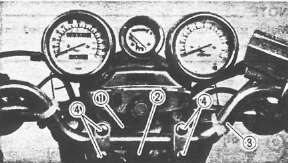
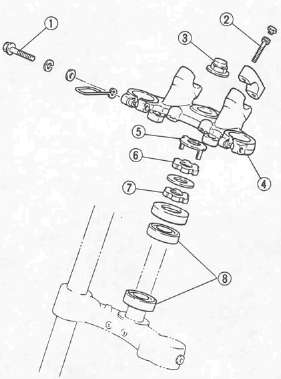
Steering head adjustment steps:
• Loosen the pinch bolts (1) .
• Remove the handlebar securing bolts (2) .
• Remove the handlebar.
•Remove the steering stem nut (3) .
•Remove the steering crown (4) .
•Remove the lock washer (5).
•Loosen the upper ring nut (6) .
•Tighten the lower ring nut (7)
Ring Nut (Lower): 50 Nm (5.0 m.kg, 36 ft-lb)
NOTE:
The tapered side of ring nuts must face downward.
• Loosen the ring nut (7) completely and retighten it to specification.
Rint Nut (Lower): 6Nm (0.6 m-kg, 4.3 ft-lb)
• Check the steering stem by turning it lock to lock. If there is any binding, remove the steering bearings (8) .
(See CHAPTER 6, STEERING HEAD for more details.)
• Hand-tighten the upper ring nut (6) , then align the slots of both ring nuts. If not aligned, hold the lower ring nut (7) and tighten the other until they are aligned.
• Install the lock washer (5).
NOTE:
Make sure the lock washer tab is placed in the slots.
• Install the steering crown (4) and tighten the steering stem nut (3) to specification.
Steering Stem Nut: 110 Nm (11.0 m-kg, 80 ft-lb)
• Install the handlebar (3) and torque the bolt (2) to specification.
Pinch Bolt: 20 Nm (2.0m.kg, 14 ft-lb)
Handlebar Bolt: 20 Nm (2.0 m-kg, 14 ft-lb)
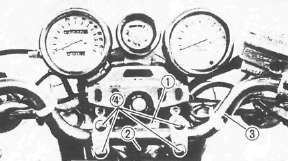
• Install the fork and bolt caps.
Wheels, Bearings and Tires
Wheels, Bearings and TiresFront Wheel Bearings
1. Raise the front end of the motorcycle, and spin the wheel by hand. Touch the axle or front fork white spinning the wheel. Replace the bearings if any vibration is detected.
Note: It may be necessary to retract the brake pads from the disk in order to freely rotate the wheel.
Rear Wheel Bearings
1. Remove the rear wheel
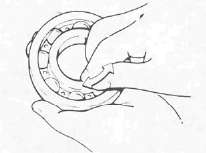
2. Check the bearing movement by rotating it with the fingers. Replace if any roughness or wear is detected.
TUBELESS TIRES AND ALUMINUM WHEELS
WARNING:
Always inspect aluminum wheels before a ride.
Do not attempt any repairs to the wheel; replace any defective wheel.
Do not attempt to use tubeless tires on a wheel designed for use with tube-type tire only. Tire failure and subsequent personal injury may result from sudden deflation.
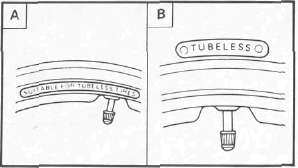
|
A | Wheel |
B Tire |
|
Tube type |
Tube type only |
|
Tubeless |
Tube type or tubeless |
• Be sure to install the proper tube when using tube-type tires.
• New tires have a relatively poor adhesion on the road surface so do not allow them to be subjected to high speed load from maximum speed until after a break-in run of approx. 100 km (60 mi).
• Always use the correct tire inflation pressure according to the operating conditions.
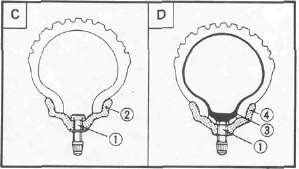
(C) Tubeless tire
(D) Tube type tire
(1) Air valve
(2) Aluminum wheel {Tubeless type)
(3) Tube
(4) Aluminum wheel (Tube type)
Always perform the following steps to ensure safe operation, maximum tire performance and long service.
1. Measure the tire pressure and adjust as necessary.
|
Basic weight: With oil and full fuel tank |
232 kg (511 lb) |
|
|
Maximum load-*- |
238 kg (525 lb) load |
|
|
Cold tire pressure |
Front |
Rear |
|
Up to 90 kg (198 1b) load* |
177 kPa (1.8 kg/cm2, 26 psi) |
196 kPa (2.0 kg/cm2, 28 psi) |
|
90 kg (198 1b) load ~ 238 kg (525 lb) |
196kPa (2.0 kg/cm2, 28 psi) |
275 kPa (2.8 kg/cm2, 40 psi) |
|
High speed riding |
206 kPa (2.1 kg/cm2, 30 psi) |
226 kPa (2.3 kg/cm2, 32 psi) |
* Load is the total weight of cargo, rider, passenger, and accessories.
2. Inspect the tire surfaces for wear or damage. Replace as required.
Minimum Tire Tread Depth: (Front and Rear) 1.0 mm (0.04 in)
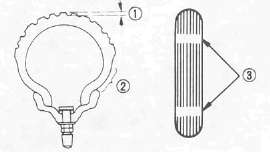
(1) Tread depth
(2) Side wall
(3) Wear indicator
3. Inspect the aluminium wheels for damage or cracks. Never attempt even small repairs to the wheel.
NOTE:
Always balance the wheel when a tire or wheel has been changed or replaced.
WARNING:
Ride conservatively after installing a tire to allow it to seat itself properly on the rim.
Electrical Maintenance
Electrical MaintenanceBattery
Battery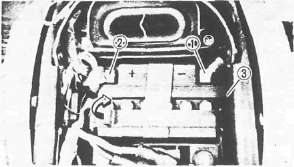
1. Disconnect:
• Negative lead (1)
• Positive lead (2)
• Breather hose (§)
2. Remove the battery
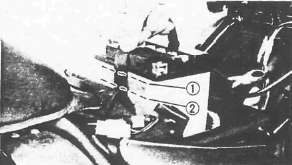
3. Check the fluid level. It should be between upper (1) and lower (2) level marks.
CAUTION:
Refill with distilled water only; tap water contains minerals harmful to a battery.
4. Inspect the breather hose (1) for obstructions. Clear or replace as necessary.
5. Connect the breather hose (1). Be sure the hose is properly attached and routed.
HOW TO ROUTE BATTERY BREATHER HOSE.
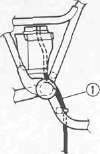
CAUTION;
Always charge a new battery before using it to ensure maximum performance.
Charging Current: 1.4 amps/10 hrs
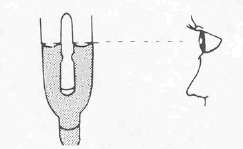
Specific Gravity:
1.280 at 20°C(68°F)
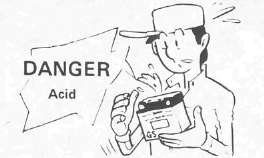
WARNING: Battery electrolyte is dangerous; it contains sulfuric acid and therefore is poisonous and highly caustic. Always follow these preventive measures:
• Avoid bodily contact with electrolyte as it can cause severe burns or permanent eye injury.
• Wear protective eye gear when handling or working near batteries.
Antidote (EXTERNAL):
• SKIN - Flush with water.
• EYES - Flush with water for 15 minutes and get immediate medical attention.
Antidote (INTERNAL):
• Drink large quantities of water or milk follow with milk of magnesia) beaten egg, or vegetable oil. Get immediate medical attention.
Batteries also generate explosive hydrogen gas, therefore, you should always follow these preventive measures:
• Charge batteries in a well-ventilated area.
• Keep batteries away from fire, sparks, or open flames (e.g., welding equipment, lighted cigarettes, etc.)
• DO NOT SMOKE when charging or handling batteries.
KEEP BATTERIES AND ELECTROLYTE OUT OF REACH OF CHILDREN.
Headlight and Fuses
Headlight and FusesHEADLIGHT
Headlight Bulb Replacement
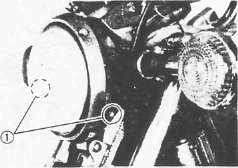
1. Remove securing screws (1) from light unit assembly/headlight body.
2. Disconnect the headlight lens unit leads
3. Remove the light unit assembly
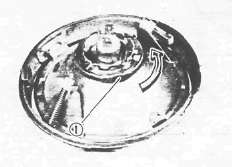
4. Rotate the bulb holder (1) counterclockwise.
5. Remove the defective bulb
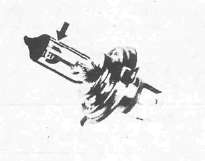
6. Install new bulb and secure with bulb holder.
CAUTION:
• Avoid touching glass part of bulb.
• Keep the bulb free from oil otherwise, transparency of glass, bulb life, and luminous flux will be adversely affected.
• If oil gets on bulb, clean it with a cloth moistened thoroughly with alcohol or lacquer thinner.
WARNING:
Do not touch the headlight bulb when it is on, as the bulb generates enormous heat; keep flammable objects away.
7. Install the light unit assembly to headlight body.
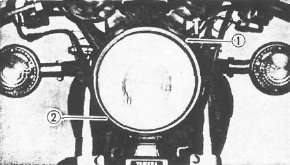
Headlight Beam Adjustment Horizontal adjustment:
1. Rotate the horizontal adjusting screw (1)
|
Horizontal Adjustment of Headlight Beam |
|
|
Adjusting screw |
Beam direction |
|
Turn clockwise |
> to Right |
|
Turn counterclockwise |
<- to Left |
|
Horizontal Adjustment of Headlight Beam |
|
|
Adjusting screw |
Beam direction |
|
Turn clockwise |
> to Right |
|
Turn counterclockwise |
< to Left |
Vertical adjustment: 1. Rotate:
• Vertical adjusting screw (2)
|
Vertical Adjustment of Headlight Beam |
|
|
Adjusting screw |
Beam direction |
|
Turn clockwise |
to Raise |
|
Turn counterclockwise |
to Lower |
FUSE
The fuse box is under the indicator light panel. The main fuse is under the seat.
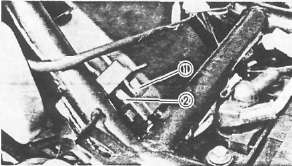
(1) Main fuse
(2) Spare fuses
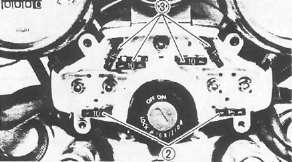
(3) Other fuse block
Blown fuse procedure steps:
• Turn off ignition and the circuit.
• Install a new fuse of proper amperage.
• Turn on switches to verify operation of electrical device.
• If fuse blows immediately again, check circuit in question.
WARNING:
Do not use fuses of higher amperage rating than recommended. Extensive electrical system damage and fire could result from substitution of a fuse of improper amperage.
Periodic Maintenance Intervals
Periodic Maintenance Intervals
|
Item |
Remarks |
EVERY |
||
|
Break-in 1,000km (600mi) |
6,000km (4,000mi) or 6 months |
12,000km (8,000mi) or 12 months |
||
|
Valve(s)* |
Check valve clearance. Adjust if necessary. |
Every 42,000 km (26,600 mi) |
||
|
Spark plug{s) |
Check condition. Clean or replace if necessary. |
o |
o |
o |
|
Air filter |
Clean. Replace if necessary. |
|
o |
o |
|
Carburetor* |
Check idle speed/synchronization/starter operation. Adjust if necessary. |
o |
o |
o |
|
Fuel line* |
Check fuel hose and vacuum pipe for cracks or damage. Replace if necessary. |
|
o |
o |
|
• Engine oil |
Replace (Warm engine before draining). |
o |
o |
o |
|
Engine oil filter* |
Replace. |
o |
|
o |
|
Final gear oil |
Check oil level/oil leakage. Replace every 24,000 (16,000) or 24 months. |
Replace |
o |
o |
|
Front brake* |
Check operation/fluid leakage/See NOTE. Correct if necessary. |
|
o |
o |
|
Rear brake |
Check operation. Adjust if necessary. |
|
o |
o |
|
Clutch |
Check operation. Adjust if necessary. |
|
o |
o |
|
Rear arm pivot* |
Check rear arm assembly for looseness. Correct if necessary. Moderately repack every 24,000 (16,000) or 24 months.* * |
|
|
o |
|
Wheels* |
Check balance/damage/runout. Repair if necessary. |
|
o |
o |
|
Wheel bearings* |
Check bearings assembly for looseness/damage. Replace if damaged. |
|
o |
o |
|
Steering bearing* |
Check bearings assembly for looseness. Correct if necessary. Moderately repack every 24,000 (16,000) or 24 months."* |
o |
|
o |
|
Front forks* |
Check operation/oil leakage. Repair if necessary. |
|
o |
o |
|
Rear shock absorber* |
Check operation/oil leakage. Repair if necessary. |
|
o |
o |
|
Cooling system |
Check coolant leakage. Repair if necessary. Replace coolant every 24,000 (16,000) or 24 months. |
|
o |
o |
|
Fittings/Fasteners" |
Check all chassis fittings and fasterners. Correct if necessary. |
O |
O |
O |
|
Center and sidestand* |
Check operation. Repair if necessary. |
o |
o |
O |
|
Sidestand switch* |
Check operation. Clean or replace if necessary. |
o |
o |
o |
|
Battery* |
Check specific gravity. Check breather pipe for proper operation. Correct if necessary. |
|
o |
o |
|
AC generator* |
Replace generator brushes. |
|
|
o |
*: It is recommended that these items be serviced by a Yamaha dealer. **: Medium weight wheel bearing grease.
NOTE:
Brake fluid replacement:
1. When disassembling the master cylinder or caliper cylinder, replace the brake fluid. Normally check the brake fluid level and add the fluid as required.
2. On the inner parts of the master cylinder and caliper cylinder, replace the oil seals every two years.
3. Replace the brake hoses every four years, or if cracked or damaged.
Chapter 3, ENGINE OVERHAUL
Chapter 3, ENGINE OVERHAULNOTE: It is not necessary to remove the engine in order to remove the following components:
• Piston
• Clutch
• Carburetor
• Oil pump
• Water pump
Engine Removal
Engine RemovalPREPARATION FOR REMOVAL
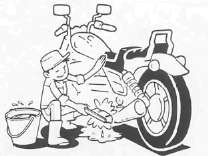
1. Remove all dirt, mud, dust, and foreign material before removal and disassembly.
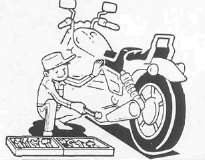
2. Use proper tools and cleaning equipment. Refer to CHAPTER 1, "SPECIAL TOOLS."
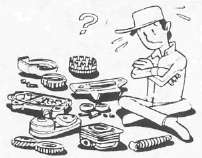
NOTE:
When disassembling the engine, keep mated parts together. This includes gears, cylinders, pistons, and other parts that have been "mated" through normal wear. Mated parts must be reused as an assembly or replaced.
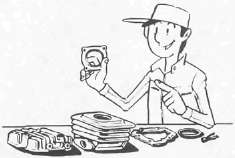
3. During the engine disassembly, clean all parts and place them in trays in the order of disassembly. This will speed up assembly time and help assure that all parts are correctly reinstalled in the engine.
SEAT AND FUEL TANK
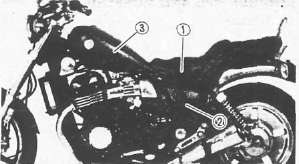
1. Remove:
• Seat 1
• Side cover 2
• Fuel tank 3
2. Drain the engine Oil
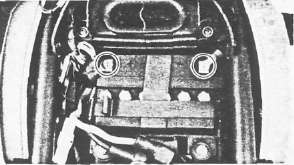
BATTERY
1. Disconnect the battery leads
NOTE:
Disconnect the negative lead first.
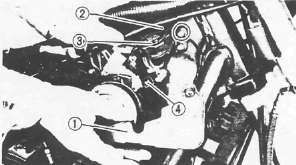
RADIATOR
1. Remove:
• Panel 1
• Radiator cap cover 2
• Radiator cap 3
2. Disconnect the electric fan motor lead 4
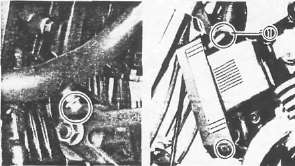
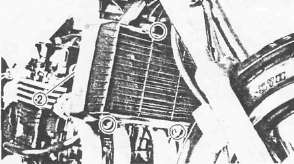
3. Drain:
• Coolant (in the radiator)
• Coolant (in the radiator pipe)
4. Disconnect:
• Radiator hose (Inlet) 1
• Radiator hose (Outlet) 2
5. Remove the radiator
CAUTION:
Do not bend or damage any of the radiator fins when removing the radiator from the motorcycle or when storing it.
EXHAUST PIPE AND MUFFLER
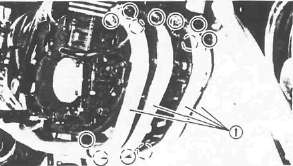
1. Remove the header nuts
2. Loosen the clamp bolts
3. Remove the exhaust header pipes 1
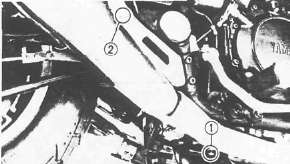
4. Remove:
• Chamber mount bolt 1
• Muffler mount bolts 2
• Mufflers with chamber
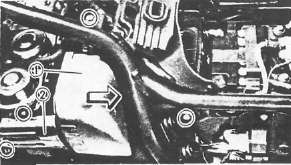
CARBURETOR AND CABLES
1. Remove:
• Air cleaner case 1 mount bolts.
• Side cover 2
2. Loosen the clamp screws
3. Push the air cleaner case toward the rear to disconnect air outlet hoses from carburetors.
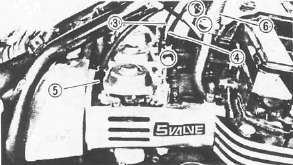
4. Disconnect:
• Choke cable 1
• Throttle cables 2
• Clutch cable 3
5. Remove the carburetors
NOTE:
After removing the carburetors, cover the carburetors with a clean cloth to keep dust and dirt out.
6. Disconnect:
• Radiator hoses 4
• Crankcase ventilation hose
CONNECTOR
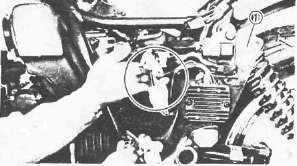
1. Remove panel 1
2. Disconnect:
• Pickup coil lead
• Generator lead
• Neutral switch lead
• Oil level switch lead
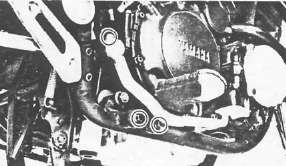
FOOTREST, BRAKE PEDAL, AND DRIVE SHAFT
1. Remove:
• Brake pedal
• Footrests (Left and Right)
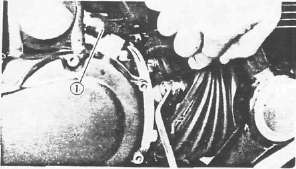
2. Disconnect:
• Starter motor lead 1 (from starter motor)
• Rubber boot
3. Remove the joint bolts
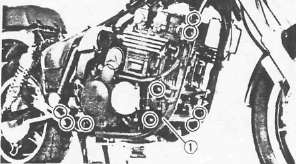
ENGINE REMOVAL
1. Place a suitable stand under the engine.
2. Remove:
• Downtube frame 1
• Mount bolts
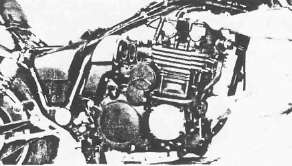
3. Remove the engine assembly from chassis right side.
Caution:
The engine is heavy, awkward and a tight fit. An assistant may be required to avoid dropping it.
There are many pinch points between the various parts of the engine and sections of the frame. Take care to avoid injury.
NOTE: If it is necessary to remove the engine without assistance, it may be worthwhile to lay the bike on it's right side and lift the frame off the bike. Take care to avoid damage to such pieces as mirrors, levers and chrome.
Engine Disassembly
Engine DisassemblyCylinder Head Removal
Cylinder Head RemovalRADIATOR PIPES, CARBURETOR JOINT, AND OIL DELIVERY PIPE
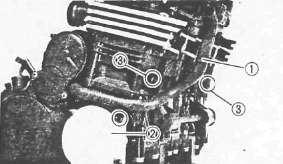
1. Remove:
• Radiator pipe 1
• Cover (Right) 2
2. Drain the coolant (in the cylinder) by removing drain bolts 3
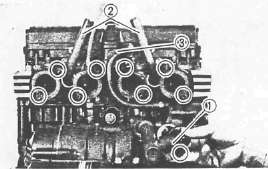
3. Remove;
• Water pump joint 1
• Radiator pipes 2
• Carburetor joints
• Bypass hose 3
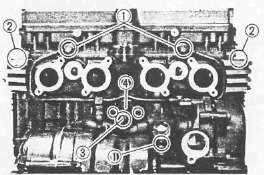
4. Remove:
• Oil delivery pipe union bolts 1
• Copper washers
• Cylinder head side covers 2
5. Loosen the cam chain tensioner end plug 3
6. Remove the cam chain tensioner assembly 4
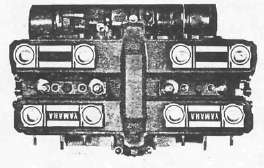
CYLINDER HEAD AND CYLINDER
1. Remove the cylinder head cover
NOTE:
Piston and cylinder can be removed, when necessary, without removing the camshaft.
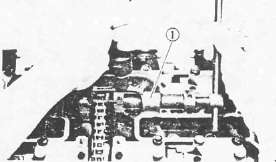
The main steps are as follows.
• Disconnect the cam chain using Cam Chain Cutter 1 (90890-01112).
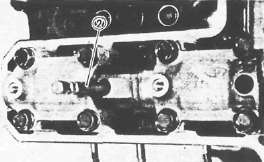
• Remove the cylinder head nuts in the camshaft case using Hexagon Wrench 2 .
• Remove the cam shaft, cam shaft case and cylinder head as assembly.
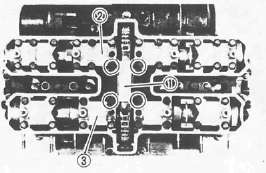
2. Remove:
• Cam chain guide (Upper) 1
• Camshaft cap (I3) 2
• Camshaft cap (E3) 3
• Dowel pins
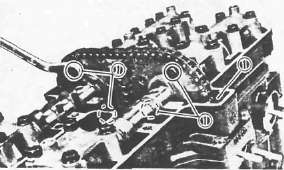
3. Remove:
• Cam chain sprocket bolts 1 Use 2 2 mm (0.88 in) wrench to hold camshaft.
• Camshaft caps (I1, I2, I4, E1,E2, E4)
• Dowel pins
• Camshafts
• Cam chain guide (Front) 1
4. Remove:
• Cylinder head nut
• Cylinder head
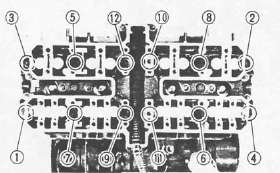
NOTE:
Follow the numerical order shown in photo, start by loosening each nut 1 /4 turn until all are loose.
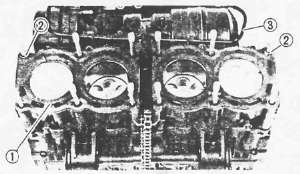
5. Remove:
• Cylinder head gasket 1
• Dowel pins 2
• Cylinder
• Oil delivery pipes 3
• Cylinder base gasket
• Dowel pins
Pistons, Starter, Generator and Pickup Coil
Pistons, Starter, Generator and Pickup CoilPISTON AND CAM CHAIN GUIDE
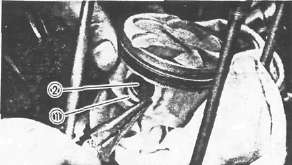
Mark each piston so it can be reinstalled in the appropriate cylinder.
1. Remove:
• Piston pin clips 1
• Piston pins 2
NOTE: Before removing the piston pin clip, cover the crankcase with a clean rag so you will not accidentally drop the clip into the crankcase.

• Pistons
• Cam chain guide (Rear) 3
STARTER MOTOR AND GENERATOR
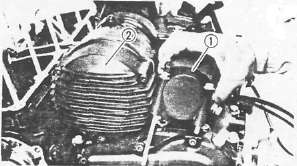
1. Remove:
• Starter motor bolts
• Starter motor assembly 1
• Generator cover 2
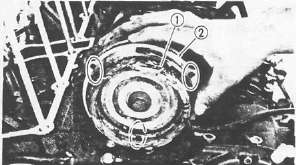
2. Remove:
• Stator coil 1
• Gasket 2
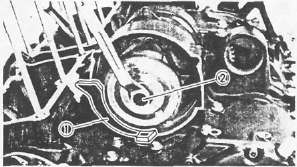
3. Attach the rotor Holding Tool (90890-04043) 1
4. Remove the rotor holding bolt 2

5. Attach:
• Rotor Puller Adapter (90890-04052) 1
• Rotor Puller (90890-01080) 2
6. Remove the rotor 3
PICKUP COIL
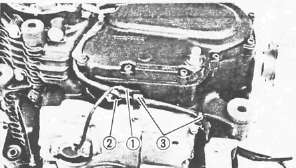
1. Disconnect:
• Oil level switch lead 1
• Neutral switch lead 2
• Pickup coil lead (from clamps 3 )
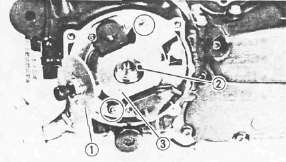
2. Remove:
• Timing plate 1
• Dowel pin 2
• Pickup coil assembly 3
Clutch and Oil Pump
Clutch and Oil PumpCLUTCH
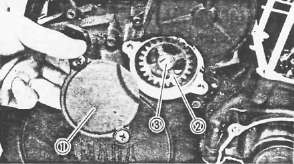
1. Remove:
• Water pump drive sprocket cover 1
• Water pump drive sprocket 2
Note:
Water pump drive sprocket bolts 3 is locked with LOCTITE®.
• Spacer
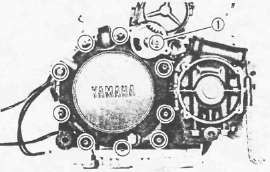
2. Remove:
• Bearing retaining washer 1
• Clutch cover
• Gasket
• Dowel pins
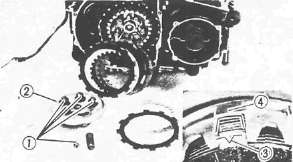
3. Remove:
• Clutch spring bolts 1
• Clutch springs
• Pressure plate 2
• Friction plates
• Clutch plates
NOTE:
The outermost friction plate has a tab with a V-cut 3 in it. Give some identifying mark to the corresponding dog 4 in the clutch housing. This dog is narrowest.
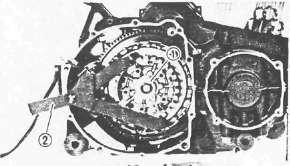
4. Bend the lock washer tab 1
5. Attach the universal Clutch Holder (90890-04086) 2
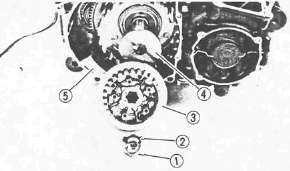
6. Remove:
• Clutch boss nut 1
• Lock washer 2
• Clutch boss 3
• Thrust washer 4
• Oil baffle plate 5
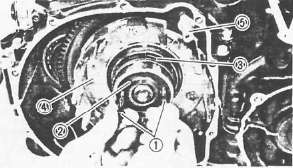
7. Install:
• Clutch cover bolts 1 (into clutch housing spacer holes)
8. Remove:
• Clutch housing spacer 2
• Bearing 3
• Clutch housing 4
• Water pump drive shaft 5
OIL PUMP
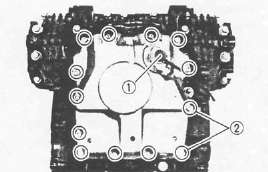
1. Remove:
• Oil filter
• Oil level switch 1
• Oil pan
• Clamps 2
• Gasket
• Dowel pins
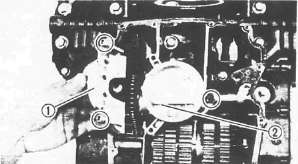
2. Remove:
• Oil pump drive chain cover 1
• Oil pump assembly 2
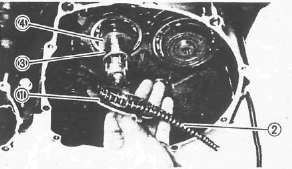
3. Remove:
• Oil pump drive sprocket 1
• Chain 2
• Collar 3
• Thrust plate 4
Shifter, Middle Gear and Crankcase
Shifter, Middle Gear and CrankcaseSHIFTER AND MIDDLE GEAR
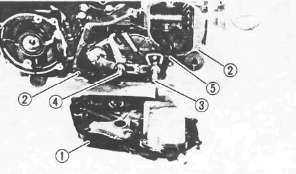
1. Remove:
• Crankcase cover (Left) 1
• Gasket
• Dowel pin 2
• Shift shaft 3
• Shift lever 4
• Oil level maintaining plug 5
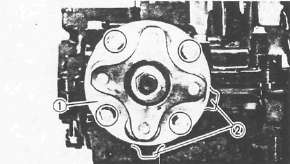
2. Remove:
• Middle driven gear housing 1
• Shims 2
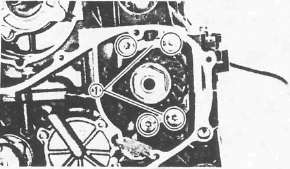
3. Remove:
• Bearing retainer 1 Use Torx Driver #40 (90890-04049).
CRANKCASE
1. Remove:
• Bolts (Crankcase)
• Clamps
• Battery negative lead
NOTE:
• Remove the bolts starting with the highest numbered one.
• The embossed numbers in the crankcase designate the crankcase tightening sequence.
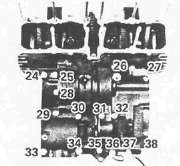
Upper crankcase
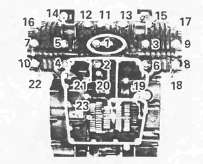
Lower crankcase
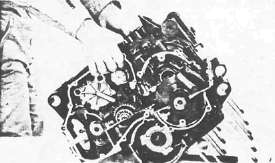
2. Remove:
• Lower crankcase
• Blind plug (from crankcase right end)
• Crankshaft bearings
NOTE:
Identify each crankshaft bearing position very carefully so that it can be reinstalled in its original place.
Gears, Starter Drive and Shift Drum
Gears, Starter Drive and Shift DrumMAIN AXLE AND MIDDLE DRIVE GEAR
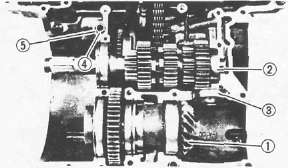
1. Remove:
• Middle drive gear 1
• Main axle 2
• Bearing 3
• Dowel pins 4
• O-ring 5
A.C.G. SHAFT, STARTER DRIVE, AND CRANKSHAFT
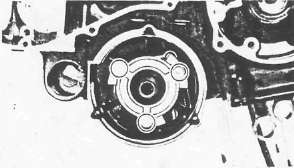
1. Remove housing using Torx Driver #30 (90890-05245)
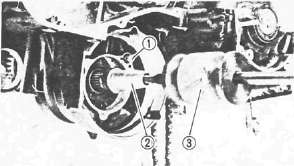
2. Remove:
• Oil spray nozzle 1
• A.C.G. shaft 2
Use Armature Shock Puller (90890-01290) and (90890-01291)3
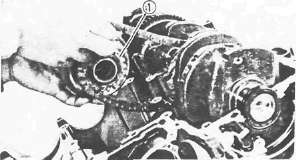
3. Remove:
• Starter clutch assembly 1
• Crankshaft
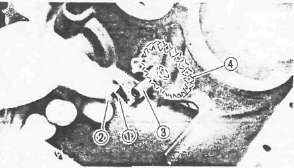
5. Bend the lock washer tab 1
6. Remove:
• Starter idle gear shaft bolt 2
• Lock washer
• Stopper plate
• Starter idle gear shaft 3
• Starter idle gear 4
SHIFT CAM AND DRIVE AXLE
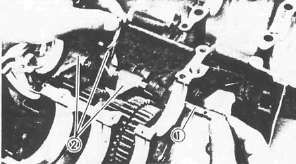
1. Remove:
• Guide bar 1
• Shift forks 2
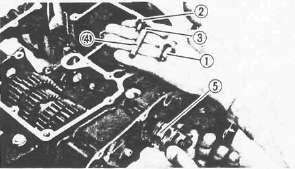
2. Remove:
• Neutral switch 1
• Bolts 2
• Stopper plate 3
• Shift cam locating pin 4
• Shift cam 5
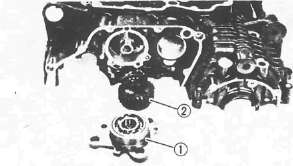
3. Remove:
• Drive axle bearing cover 1
• 5th wheel gear 2
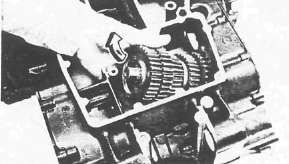
4. Remove the drive axle assembly
Inspection and Repair
Inspection and RepairCylinder Head and Camshaft Case
Cylinder Head and Camshaft Case 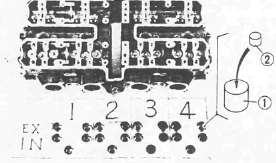
1. Remove
• Lifters 1
• Valve pads 2
NOTE:
Identify each lifter and pad position very carefully so that it can be reinstalled in its original place.
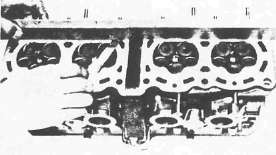
2. Measure the warpage using a precision straight edge or surface plate and feeler gauges. Resurface if warpage exceeds allowable limit.
Cylinder Head Warpage: Less than 0.03 mm (0.0012 in)
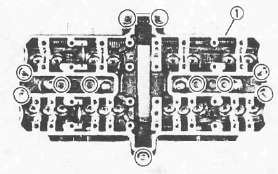
3. Remove the camshaft case 1
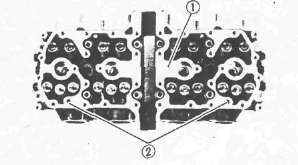
4. Remove:
• Camshaft case gasket 1
• Dowels 2
• Cylinder head nuts
• Plain washers
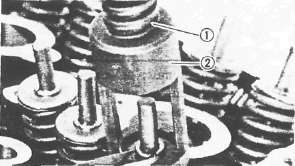
5. Attach:
• Valve Spring Compressor (90890-04019) 1
• Attachment (90890-04108) 2
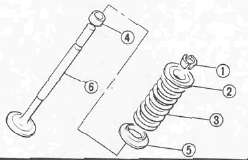
6. Remove:
• Valve retainers 1
• Valve spring seat 2
• Valve spring 3
• Oil seal 4
• Valve spring seat 5
• Valve 6
NOTE:
Deburr any deformed valve stem end. Use an oil stone to smooth the stem end.
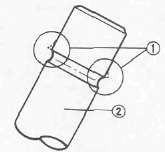
1 Deburr 2 Valve stem
7. Eliminate:
• Carbon deposit (from combustion chamber) Use rounded scraper.
NOTE:
Do not use a sharp instrument and avoid damaging or scratching:
• Spark plug threads
• Valve seat
• Aluminum
8. Install:
• Valves
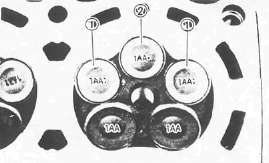
NOTE:
Be sure the "1AA : " mark 1 valves are for intake left and right and "1AA •" mark 2 for intake center.
9. Install the valve springs
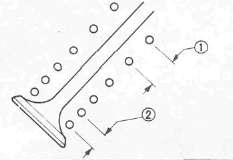
NOTE:
• All valve springs must be installed with the larger pitch 1 upward as shown.
• Be sure the "Blue" spring is for intake and "Red" for exhaust.
2 Smaller pitch
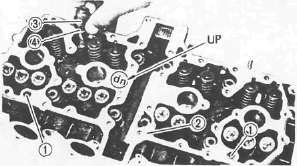
10. Install:
• Dowels 1
• Camshaft case gasket 2
NOTE:
Be sure the "UP" mark face to upward.
• Plain washers 3
• Cylinder head nuts 4
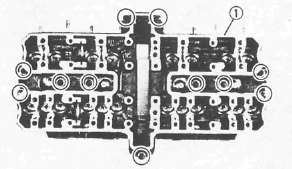
11. Install the camshaft case 1. Torque the camshaft case bolts to 10 Nm (1.0m-kg, 7.2ft-ft)
Valves, Guides, Seats and Springs
Valves, Guides, Seats and Springs1. Measure the valve stem clearance
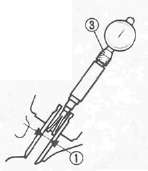
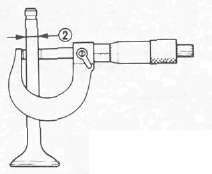
Use a bore gauge 3 to determine the valve guide inside diameter.
Valve Guide Inside Diameter Limit: 5.05 mm (0.199 in)
2. Measure the valve stem diameter with a micrometer. Replace guide if clearance exceeds specification.
Valve stem clearance = Valve guide inside diameter 1 minus Valve stem diameter 2
Valve Stem Clearance Limit:
Intake 0.08 mm (0.003 in)
Exhaust 0,10 mm (0.004 in)
3. Examine the valve face for pitting or wear and regrind as necessary. Measure the valve face as indicated below and replace if valve cannot be brought back to specification.
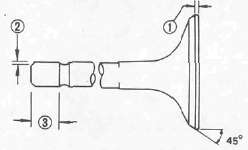
Minimum Thickness (Service limit) 1 : 0.7 mm (0.028 in)
Beveled 2 : 0.35 mm (0.014 in)
Minimum Length (Service limit) 3 :14.5 mm (0.6 in)
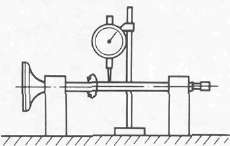
4. Check:
• Valve stem end Mushroom shape and/or diameter. Replace if larger than rest or stem.
• Runout. Replace if it exceeds specification.
Maximum Valve Stem Runout: 0.01 mm (0.0004 in)
5. Inspect the valve guide for signs of wear and/or oil leakage. Replace if excessive.
NOTE:
Heat the
cylinder head in an oven to 100°C (212°F) to ease valve guide removal
and reinstallation and to maintain correct interference fit.
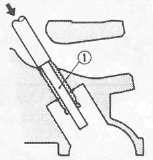
Valve Guide Replacement
1. Remove the valve guide. Use Valve Guide remover 1 (90890-04097)
NOTE
• Always replace valve guide if valve is replaced.
• Always replace oil seal if valve is removed.
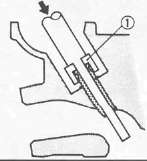
2. Install the new valve guide with Valve Guide Installer 1 (90890-04098) and Valve Guide Remover (90890-04097).
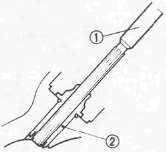
3. Bore valve guide 1 to obtain proper valve stem clearance. Use 5 .0 mm (0.20 in) Reamer 2 (YM-04099).
Valve Seat
1. Inspect the valve seat for pitting/wear. Cut new faces as required.
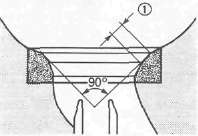
2. Measure the valve seat width 1. Follow the next steps if out of specification.
|
|
Standard width |
Wear limit |
|
Valve seat width |
1.0 ± 0.1 mm (0.040 ± 0.004 in) |
1.8 mm (0.070 in) |
3. Apply:
• Mechanic's bluing dye (Dykem) (to valve and seat)
• Fine grinding compound (Small amount) (to valve face surface)
4. Position the valve into the cylinder head.
CAUTION:
Do not allow any compound to contact the valve stem or guide. Flush thoroughly as required.
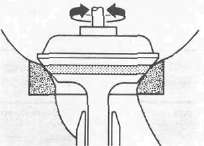
5. Spin it rapidly back and forth, then lift valve and clean off all grinding compound.
6. Inspect the valve seat surface. Wherever valve seat and valve face made contact, blueing will have been removed.
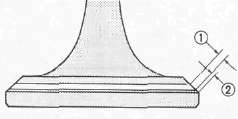
7. Measure:
• Valve seat width 1
• Contacting position 2
Recut if out of specification.
Width 1 : 1.0 ± 0.1 mm (0.040 ± 0.004 in)
Position 2 : 0.3 mm (0.012 in)
8. Cut valve seat.
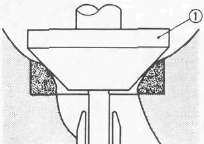
NOTE:
Cut valve seat using valve seat cutter 1 if valve seat width exceeds limit or if valve seat is pitted or worn.
CAUTION:
When twisting cutter, keep an even downward pressure to prevent chatter marks.
Valve seat recutting steps are necessary if:
• Valve seat is uniform around perimeter of valve face but too wide or too narrow or not desired position on valve face.
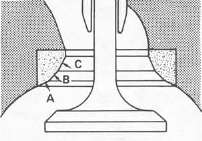
|
Cut valve seat as follows: |
|
|
Section A |
20° Cutter |
|
Section B |
45° Cutter |
|
Section C |
60° Cutter |
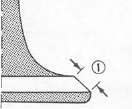
|
• Valve face indicates that valve seat is in desired position 1 but too wide |
||
|
Valve seat cutter set |
Desired result |
|
|
Use |
20° Cutter 6 0° Cutter |
to reduce valve seat width. |
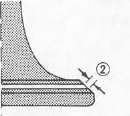
|
• Valve seat is desired position 2 but too narrow |
||
|
Valve seat cutter set |
Desired result |
|
|
Use |
45° Cutter |
to achieve a uniform valve seat width (Standard specifications). |
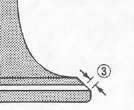
|
• Valve seat is too narrow and touching the valve margin 3. |
||
|
Valve seat cutter set |
Desired result |
|
|
Use |
20° Cutter, first 45 ° Cutter |
to obtain correct seat width. |

|
• Valve seat is too narrow and touching the bottom edge of the valve face 4. |
||
|
Valve seat cutter set |
Desired result |
|
|
Use |
60° Cutter, first 45 ° Cutter |
to obtain correct seat width. |
NOTE:
Lap valve/valve seat assembly if:
•Valve face/valve seat are used or severely worn.
•Valve and valve guide has been replaced.
•Valve seat has been cut.
Valve/Valve Seat Assembly Lapping
1. Apply coarse lapping compound (Small amount!) to valve face.
2. Position the valve (in cylinder head)
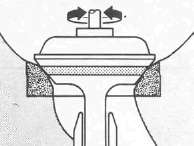
3. Rotate the valve. Turn until valve and valve seat are evenly polished, then clean off compound.
4. Repeat above steps with fine compound and continue lapping until valve face shows a completely smooth surface uniformly.
5. Eliminate all compound from valve face.
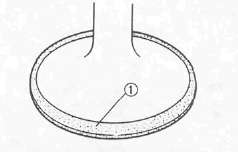
6. Apply mechanic's bluing dye (Dykem) 1 to valve face and seat.
7. Rotate the valve. Valve must make full seat contact indicated by grey surface all around valve face where bluing was removed.
8. Apply solvent into each intake and exhaust port. If solvent leaks past valve seat, relap until seal is complete.
NOTE:
Pour solvent into intake and exhaust ports only after completion of all valve work and assembly of head parts.
Re-lapping steps:
• Disassemble head parts.
• Repeat lapping steps using fine lapping compound.
• Clean all parts thoroughly.
• Reassemble and check for leakage again using solvent.
• Repeat steps as often as necessary to effect a satisfactory seal.
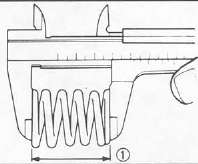
Valve Spring Measurement
Measure the valve spring free length. Replace if out of specification.
Valve Spring Free Length (Limit):
|
lntake Spring |
Exhaust Spring |
|
|
37.76 mm (1.487 in) |
37.96 mm (1.495 in) |
|
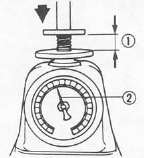
2. Measure:
• Installed length 1
• Valve spring installed force 2
Replace if out of specification.
Valve Spring Installed Force:
|
Intake Spring |
Exhaust Spring |
||
|
1 |
2 |
1 |
2 |
|
35.0 mm |
7.3-8.7 kg |
35.0 mm |
11.0-13.0 kg |
Camshafts, Chain and Sprockets
Camshafts, Chain and SprocketsCAMSHAFT, CAM CHAIN, AND CAM SPROCKET
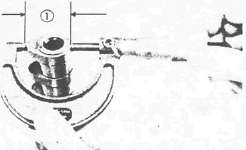
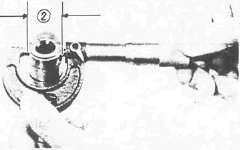
Camshaft
1. Measure:
• Large cam lobe length 1
• Small cam lobe length 2
Use a micrometer. Replace if out of specification.
|
|
Intake [Limit] |
Exhaust [Limit] |
|
1 |
32.45 mm (1.2776 in) |
32.30 mm (1.2727 in) |
|
2 |
24.85 mm (0.9783 in) |
24.85 mm (0.9783 in) |
Camshaft/Cap Clearance Measurement
1. Install:
• Intake camshaft
• Exhaust camshaft
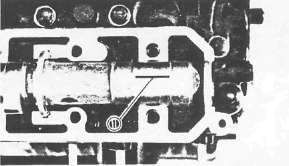
2. Position a strip of Plastigage® (YU-33210) 1 onto camshaft.
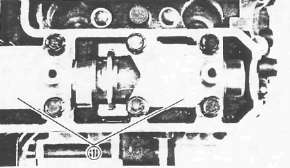
3. Install the camshaft caps 1
4. Tighten the camshaft cap bolts
Camshaft Cap Bolts: 10 Nm (1.0mkg, 7.2ft-lb)
NOTE:
Do not turn the camshaft when measuring clearance with Plastigage.
5. Remove the camshaft caps
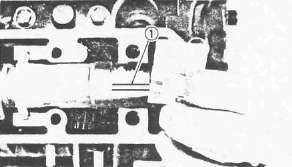
6. Measure the width of Plastigage® 1
Out of specification -> Follow step 7 .
Camshaft-to-cap Clearance: 0.050 - 0.084 mm (0.0020- 0.0033 in)
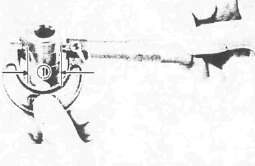
7. Measure the camshaft bearing surface diameter 1. Use a micrometer.
Out of specification -> Replace camshaft.
Within specification -> Replace cylinder head.
Camshaft Bearing Surface Diameter:
Standard: 24.437~24.450mm (0.9621-0.9626 in)
Cam Cap Inside Diameter: Standard: 2 4 .500-24.521 mm (0.9646-0.9654 in)
Cam Chain Tensioner
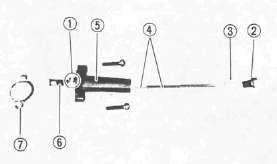
1 One way cam
2 End plug
3 Washer
4 Spring
5 Tensioner body
6 Tensioner rod
7 Gasket
1. Check the one-way cam operation. Replace if operation is not smooth.
2. Inspect: all parts for damage and wear. Replace as necessary.
Cam Chain
1. Inspect:
• Cam chain
Chain stretch/Cracks-> Replace
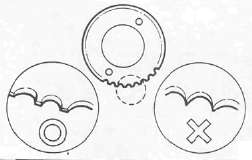
Cam Sprockets
1. Inspect the cam sprockets for wear/damage. Replace worn sprockets.
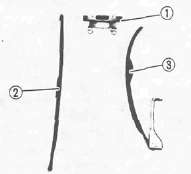
Chain Guide
1. Inspect:
• Upper chain guide 1
• Exhaust side chain guide 2
• Intake side chain guide 3
Replace worn parts.
Cylinders, Pistons and Rings
Cylinders, Pistons and RingsCYLINDER
1. Inspect the cylinder walls for vertical scratches and Rebore or Replace cylinder as required.
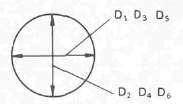
2. Measure the cylinder inside diameter.
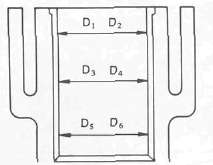
NOTE:
Obtain measurements at three depths by placing measuring instrument parallel to and at right angles to crankshaft.
Out of specification -> Rebore cylinder, and replace piston and piston rings.
|
|
Standard |
Wear Limit |
|
Cylinder bore: C |
68.000-68.005 mm |
68.1 mm |
|
Cylinder taper: T |
0 |
0.05 mm |
C= Maximum D
T= Maximum of D1or D2 minus Minimum of D5 or D6
PISTON, PISTON RING, AND PISTON PIN
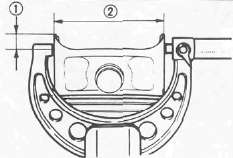
Piston 1 . Measure the piston skirt diameter "P" 2
NOTE:
Measure the piston skirt diameter where the distance 1 is 5.0 mm (0.197 in) from the piston bottom edge.
|
|
Piston Size P |
|
Standard |
68.00 mm |
|
Oversize 2 |
68.50 mm |
|
Oversize 4 |
69.00 mm |
2. Measure the piston clearance
Piston Clearance = Cylinder inside diameter "C" minus Piston skirt diameter "P"
Out of specification -> Rebore cylinder, and replace piston and piston rings.
Piston Clearance: 0.06 - 0.08 mm (0.0024 - 0.0031 in)
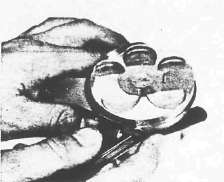
Piston Ring 1 .
Measure ring side clearance. Use a feeler gauge.
Out of specification -> Replace piston.
NOTE:
Clean carbon from piston ring grooves and rings before measuring side clearance.
|
|
Piston Ring Side Clearance (Limit): |
|
|
Top Ring |
0.15 mm (0.006 in) |
|
|
2nd Ring |
0.15 mm (0.006 in) |
|
2. Position the piston ring in cylinder.
NOTE:
Insert a ring into cylinder, and push it approximately 2 0 mm (0.8 in) into cylinder. Push ring with piston crown so that ring will be at a right angle to cylinder bore.
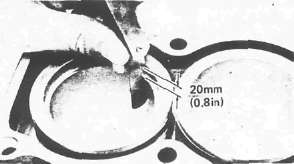
3. Measure the ring end gap. Replace if out of specification.
NOTE:
You cannot measure end gap on expander spacer of oil control ring. If oil control ring rails show excessive gap, replace all three rings.
|
|
End Gap Limit (Installed): |
|
Top Ring |
1.0 mm (0.040 in) |
|
2nd Ring |
1.0 mm (0.040 in) |
|
Oil Ring |
1.5 mm (0.060 in) |
Piston Ring Oversize

•Top and 2 nd piston ring Oversize top and middle ring sizes are stamped on top of ring.
|
Oversize 2 |
0.50 mm (0.0197 in) |
|
Oversize 4 |
1.00 mm (0.0394 in) |
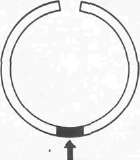
• Oil control ring Expander spacer of bottom ring (oil control ring) is color-coded to identify sizes.
|
Size |
Color |
|
Oversize 2 |
Red |
|
Oversize 4 |
Yellow |
Piston Pin
1. Lubricate piston pin (Lightly)
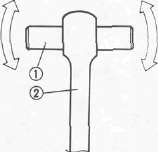
2. Install:
• Piston pin 1 into small end of connecting rod 2.
3. Check for free play
Free play -> Inspect connecting rod for wear.
Wear -> Replace connecting rod and piston pin.
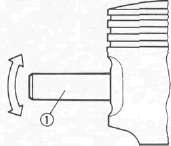
4. Position the piston pin 1 into piston.
5. Check for free play in piston.
Free play -> Replace piston pin and/or piston.
Crankshaft and Connecting Rods
Crankshaft and Connecting RodsCRANKSHAFT AND CONNECTING ROD
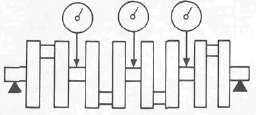
Crankshaft Runout
1. Place both ends of crankshaft on V-blocks.
2. Rotate Crankshaft
3. Measure the crankshaft runout at main journal bearings. Use a Dial Gauge (90890-03097).
Maximum Crankshaft Runout: 0.03 mm (0.0012 in)
Connecting Rod Bearings
1 . Inspect bearings for Burns/Flaking/Roughness/Scratches. Replace as necessary.
Connecting Rod Bearing Clearance
1. Clean all parts thoroughly.
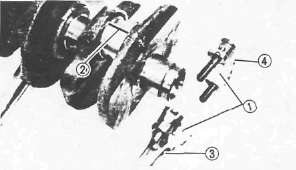
2. Install connecting rod bearings 1 into connecting rod and cap.
3. Attach Plastigage® 2 onto crankpin.
4. Position:
• Connecting rod 3 onto crankshaft.
• Connecting rod cap 4
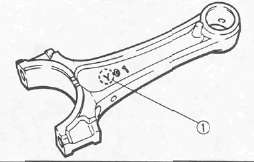
NOTE:
• Be sure the "Y" marks 1 on the connecting rods face toward left crankshaft end.
• Be sure the letters on both components align to form a perfect character.
5. Apply:
Molybdenum disulfide grease (to bolt threads)
Torque both ends of rod cap evenly.
NOTE:
Do not move connecting rod until a clearance measurement has been completed.
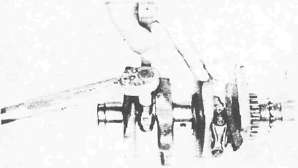
CAUTION:
Tighten to full torque specification without pausing. Apply continuous torque between 2.0 and 3.6 m-kg. Once you reach 2.0 m-kg DO NOT STOP TIGHTENING until final torque is reached. If tightening is interrupted between 2.0 and 3.6 m-kg, loosen nut to less than 2.0 m-kg and start again.
Connecting Rod Cap: 3 6 Nm (3.6 m-kg, 26 ft-lb)
6. Remove connecting rod cap carefully.
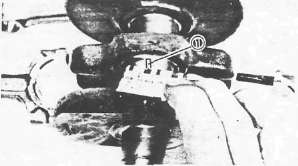
7. Measure Plastigage® width 1 . Replace connecting rod bearing if clearance is excessive.
Connecting Rod Bearing Clearance: 0.032 ~ 0.056 mm (0.0013- 0.0022 in)
Crankshaft Main Bearing Clearance Measurement
1. Clean all parts.
2. Position upper crankcase half. Place on a bench in an upside down position.
3. Install:
• Bearings into the upper crankcase
• Crankshaft
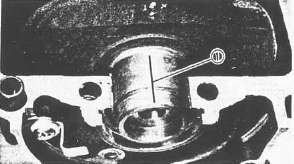
4. Attach Plastigage® (YU-33210) 1 onto the crankshaft journal surface.
NOTE:
Do not move crankshaft until clearance measurement has been completed
5. Install:
• Bearings into lower crankcase
• Lower crankcase
6. Tighten bolts
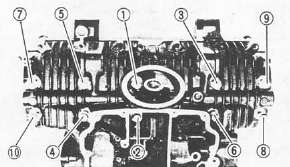
CAUTION:
Tighten to full torque in torque sequence cast on the crankcase.
9 mm (0.36 in) Bolt: 3 6 Nm (3.6m-kg, 2 5 fMb)
7. Remove bolts in reverse assembly order. carefully remove lower crankcase.
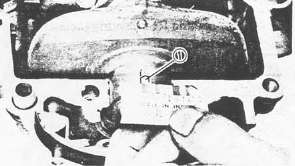
8. Measure Plastigage® width 1
Out of specification -> Replace bearings. Replace crankshaft if necessary.
Main Bearing Oil Clearance: 0.020 - 0.044 mm (0.0008-0.0017 in)
Crankshaft Main and Connecting Rod Bearing Selection
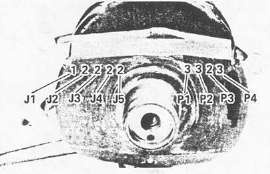
• Numbers used to indicate crankshaft journal sizes are stamped on the LH crankweb. The first five are main bearing journal numbers, starting with the left journal. The four rod bearing journal numbers follow in the same sequence.
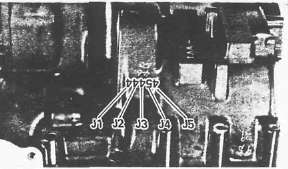
• The upper crankcase half is numbered J1, J2, J3, J4, and J5 on the rear right boss as shown.
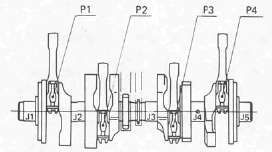
•The connecting rods are numbered 4 or 5 .
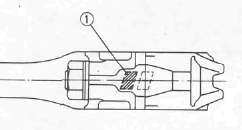
The numbers are stamped in ink on the rod cap 1.
|
Bearing Color Code |
|
|
No. 1 |
Blue |
|
No. 2 |
Black |
|
No. 3 |
Brown |
|
No. 4 |
Green |
|
No. 5 |
Yellow |
* No. 5 applies only to the crankshaft main bearing selection.
Example, Selection of the crankshaft main bearing:
If the crankcase J1 and crankshaft J1 sizes are No. 4 and No. 1 , respectively, the bearing size No. is:
Bearing size No. = Crankcase No. minus Crankshaft No.
= 4 -1 = 3 (Brown)
Example 2 , Selection of the connecting rod bearing:
If the connecting rod P1 and crankshaft P1 sizes are No. 4 and No. 1 , respectively, the bearing size No. is:
Bearing size No. = Connecting rod No. minus- Crankshaft No.
= 4 -1 = 3 (Brown)
Oil Pump, Primary Drive and Starter Drive
Oil Pump, Primary Drive and Starter DriveOIL PUMP
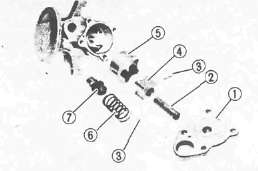
1. Remove:
•Screw
• Pump cover 1
• Pump shaft 2
• Pin 3
• Inner rotor 4
• Outer rotor 5
• Spring 6
• Relief valve 7
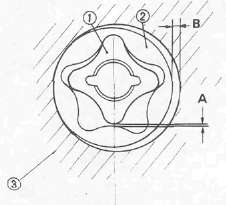
2. Measure:
•Clearance "A" (between inner rotor 1 and outer rotor 2
• Clearance "B" (between outer rotor 2 and pump housing 3 )
Out of specification -> Replace oil pump.
|
|
Oil Pump Clearance: |
Clearance A |
0.03 ~ 0.09 mm (0.0012- 0.0035 in) |
Clearance B |
0.03 ~ 0.08 mm (0.0012- 0.0031 in) |
PRIMARY DRIVE
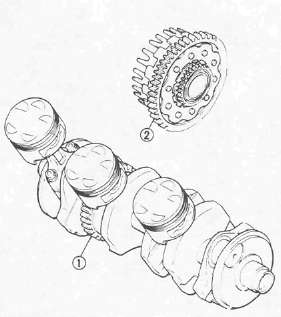
1. Inspect:
• Primary drive gear 1
• Primary driven gear2
Wear/Damage -> Replace both gears,
Excessive noises during operation-► Replace both gears.
|
Primary Reduction Ratio: |
No. of teeth |
Ratio |
Drive |
Driven |
58 |
97 |
1.672 |
STARTER DRIVE
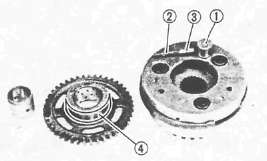
Electric Starter Clutch
1. Check:
• Roller 1 operation
• Spring 2 operation
• Spring cap 3 operation
Unsmooth operation -> Replace one-way clutch.
2. Inspect:
• Surface 4 of the idle gear
Pitting/Wear/Damage -> Replace.
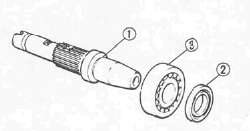
Starter Clutch Shaft (A.C.G. shaft)
1. Check:
• Shaft 1
• Oil seal 2
Wear/Damage — Replace.
• Bearing 3
Unsmooth operation - Replace.
Clutch
ClutchCLUTCH

1. Inspect:
• Clutch housing dogs 1
Cracks/Pitting (edges): Moderate -> Deburr.
Severe -> Replace clutch housing.
2. Inspect
• Clutch housing bearing 2
• Spacer 3
Damage -> Replace.
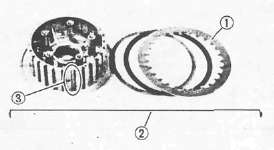
NOTE:
The clutch boss contains a built-in damper beneath the first clutch friction plate (clutch plate 1). It is not necessary to remove the wire circlip 2 and disassemble the built-in damper unless there is serious clutch chattering.
3. Inspect the clutch boss spline 3 for pitting:
Moderate -» Deburr.
Severe -> Replace.
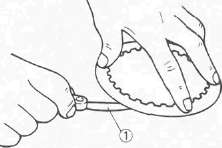
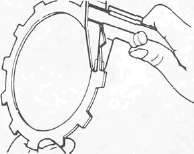
4. Place clutch plate on surface plane. For each plate:
Use feeler gauge 1 to measure maximum warpage from surface. Measure Friction plate thickness
Out of specification -> Replace clutch or friction plate as a set.
|
|
Standard |
Wear Limit |
|
Friction Plate Thickness |
3.0 mm (0.12 in) |
2.8 mm (0.11 in) |
|
Clutch Plate Warp Limit |
0 |
0.05 mm 0.0020 in) |
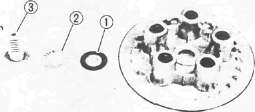
5. Inspect:
• Pressure plate
• Plate washer 1
•Thrust bearing 2
• Pull rod 3
Damage -> Replace.
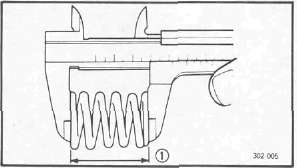
6. Measure each clutch spring free length
If any are out of specification -> Replace springs as a set.
Clutch Spring Minimum Free Length 1 : 49.0 mm (1.93 in)
Transmission
TransmissionTRANSMISSION
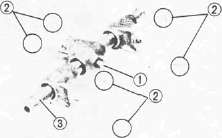
1. Inspect:
• Shift fork cam follower 1
• Shift fork pawl 2
• Guide bar 3
Scoring/Bends/Wear-> Replace.
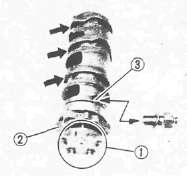
2. Inspect:
• Shift cam groove
• Shift cam dowel and side plate 1
• Shift cam stopper plate 2
• Neutral point 3
Wear/Damage -> Replace.
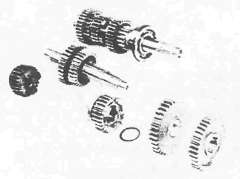
3. Measure the transmission shaft runout. Use a centering device and dial gauge. Replace shaft if bent.
Maximum Runout: 0.08 mm (0.0031 in)
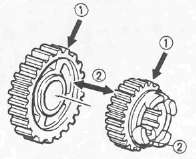
4. Inspect the gear teeth 1 for: Blue discoloration/Pitting/Wear. Inspect the mated dogs 2 for Rounded edges/Cracks/Missing portions. Replace as necessary.
Note:
Minor rounding of the dogs can be corrected by undercutting. See the article on "Repairing second gear" elsewhere on this site.

5. Check:
• Proper gear engagement (Each gear to its counter part). Incorrect-> Reassemble.
• Gear and bearing movement. Roughness-> Replace.
SHIFTER
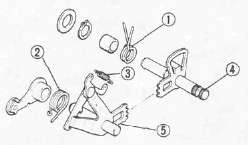
1. Inspect:
• Shift return spring 1
• Stopper lever spring 2
• Shift lever spring 3
Damage -> Replace.
• Shift shaft 4
• Shift lever 5
Damage/Bends/Wear -> Replace.
CRANKCASE
1. Inspect:
• Case halves
• Bearing seat
• Fitting
Damage -> Replace.
BEARINGS AND OIL SEALS
1. Inspect each bearing. Clean and lubricate, then rotate inner race with finger.
Roughness -> Replace bearing (see Removal).
2. Inspect all oil seals. Replace any damaged or worn seals.
CIRCLIPS AND WASHERS
1. Inspect:
• Circlips
• Washers
Damage/Looseness/Bends -> Replace.
Engine Assembly and Adjustment
Engine Assembly and AdjustmentLower Crankcase
Lower CrankcaseLOWER CRANKCASE
1 Drive axle assembly
2 5 th wheel gear
3 O-ring
4 Housing
5 Shift cam
6 Shift cam locating pin
7 Shift fork 3
8 Shift fork 2
9 Shift fork 1
10 Shift fork guide bar
11 Circlip
12 Dowel pin
13 Blind plug
14 Middle drive gear assembly

1. Install:
• Drive axle assembly 1
• 5th wheel gear 2
• new O-ring 3 onto the housing 4
• Drive axle bearing housing 4
Drive Axle Bearing Housing: 12 Nm (1.2 m kg, 8 .7 ft-lb)
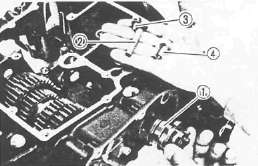
2. Install:
• Shift cam 1
• Shift cam locating pin 2
• Stopper plate 3
• Bolt
• Neutral switch 4
Shift Cam Locating Pin: 8 Nm (0.8 m-kg, 5 .8 ft-lb)
Neutral Switch: 20 Nm (2.0 m-kg, 14 ft-lb)
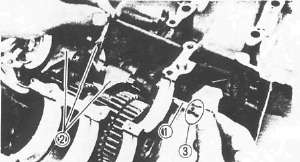
3. Install:
•Shift forks 2
•Guide bar 1
NOTE: • All
shift fork numbers should face the left side and be in sequence (1, 2 ,
3 ), starting from the left.
• The guide bar groove 3 should face the right side.
4. Place the shift cam and transmission gears in NEUTRAL position.
CAUTION:
Be sure the gear shifts correctly while hand-turning the shift cam.
5. Clean the crankcase counterbore where the main bearing is fitted.
6. Install the crankshaft bearings See inspection for crankshaft bearing selection.
CRANKSHAFT

1. Clean:
• Crankshaft
• Connecting rods
2. Install the connecting rod bearings into connecting rod and cap.
3. Lubricate the connecting rod bolt threads with Molybdenum Disulfide Grease
4. Apply engine oil to the crankshaft pins.
5. Install:
• Connecting rods
• Rod caps
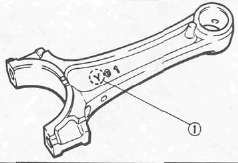
NOTE:
• Be sure the letter on both components align to form a perfect character.
• The stamped "Y" mark on the connecting rods 1 should face towards the left side of the crankcase.
Upper Crankcase
Upper CrankcaseUPPER CRANKCASE
1 Crankshaft bearing
2 Drive chain guide
3 Starter idle gear
4 A.C.G. drive chain
5 Oil seal
6 Starter clutch assembly
7 Main axle assembly
8 A.C.G. shaft
9 O-ring
10 Oil spray nozzle
11 Housing
12 Cam chain guide
|
CONNECTING ROD BEARING SELECTION: |
|
|
CALCULATED NO. |
COLOR CODE |
|
1 |
BLUE |
|
2 |
BLACK |
|
3 |
BROWN |
|
4 |
GREEN |
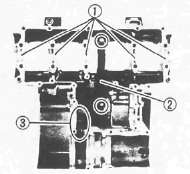
1. Install:
• Crankshaft bearings 1
• Drive chain guide 2
• Starter idle gear 3
Drive Chain Guide: 8 Nm (0.8 m-kg, 5.8 ft-lb)
Starter Idle Gear: 8 Nm (0.8 m-kg, 5.8 ft-lb)
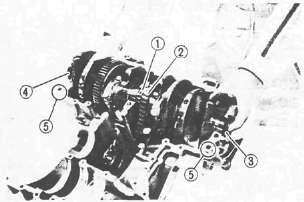
2. Apply engine oil to the bearings.
3. Place the cam chain 1 , drive chain 2 , and oil seal 3 onto the crankshaft.
4. Install the crankshaft (onto the upper crankcase)
NOTE:
• Insert the oil seal flange completely into the crankcase positioning groove.
•Be careful not to damage the oil seal duringinstallation.
• Blind plug 4
• Dowel pins 5
5. Place the drive chain on the starter clutch assembly.
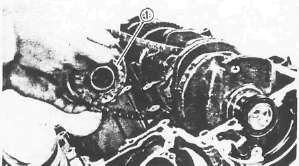
6. Install
• Starter clutch assembly 1 onto the upper crankcase
• A.C.G. shaft
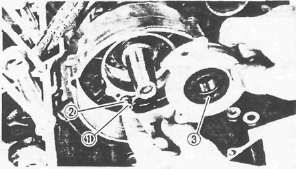
7. Install:
• Oil spray nozzle 1 with new O-ring 2
• Housing with new oil seal 3
NOTE:
Lightly apply grease to the oil seal lips.
Housing Bolt: 10 Nm (1.0 m-kg, 7.2 ft-lb) LOCTITE®
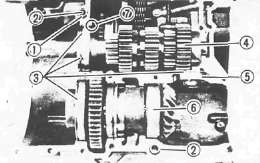
8. Install:
• O-ring (New) 1
• Dowel pins 2
• Half clips 3
• Main axle assembly 4
• Bearing 5
• Middle drive shaft assembly 6
9. Position the bearing pin (left bearing) as shown 7.
CRANKCASE ASSEMBLY
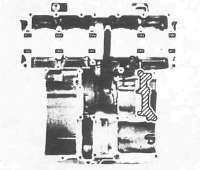
1. Attach a length of wire to the cam chain.
2. Apply Yamaha bond No. 1215 (908 8 5505).
NOTE:
DO NOT ALLOW any sealant to come in contact with the oil galley O-ring, or crankshaft bearings. Do not apply sealant to within 2-3 mm (0.08-0.12 in) of the bearings.
3. Install the lower crankcase onto the upper crankcase.

• Be sure the shift fork (No. 1 ) 1 engages the groove 2 in the 2nd pinion gear on the main axle.
• Insert the oil seal and blind seal flanges completely into the crankcase positioning grooves.
• Be careful not to damage the seals during installation.
4. Install:
• Bolts
• Washers
• Clamps
• Battery negative lead
5. Tighten:
• Crankcase bolts
Crankcase:
6 mm bolt: 12 Nm (1.2m-kg, 8.7ft-lb)
8 mm bolt: 24 Nm(2.4m-kg, 17 ft-lb)
NOTE:
The embossed numbers in the crankcase designate the crankcase tightening sequence.
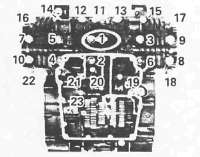
LOWER CRANKCASE
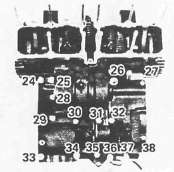
UPPER CRANKCASE
Oil Pump, Clutch and Water Pump
Oil Pump, Clutch and Water PumpOIL PUMP AND OIL PAN
1 Chain cover
2 Oil pump sprocket
3 Oil pump drive sprocket
4 Oil pump cover
5 Inner rotor
6 Spring
7 Relief valve
8 Shaft
9 Dowel pin
10 Outer rotor
11 Dowel pin
12 O-ring
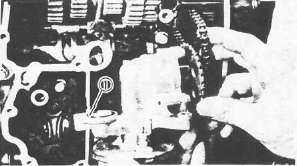
1. Install:
• O-ring 1 onto the oil pump assembly
• Chain
• Oil pump assembly
• Chain cover
Oil Pump: 12 Nm (1.2 m-kg, 8.7 ft-lb)
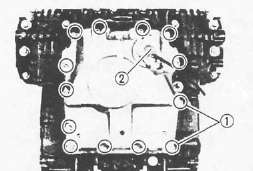
2. Install:
• Oil pan
• Wire clamps 1
• Bolts
• Oil level switch 2
Oil Pan: 12 Nm (1.2 mkg, .7 ft-lb)
Oil Level Switch: 8 Nm (0.8m-kg, 5.8 ft-lb)
CLUTCH
1 Plate washer
2 Oil seal
3 Bearing
4 Pinion gear
5 Plate washer
6 Circlip
7 Lock washer
8 Friction plate
9 Clutch plate
10 Wire clip
11 Clutch plate
12 Clutch boss spring
13 Spring seat
14 Thrust plate
15 Spacer
16 Bearing (15-28)
17 Oil pump drive sprocket
18 Collar
19 Thrust plate
20 Pull rod
21 Bearing
22 Water pump drive shaft
23 Spacer
24 Water pump drive gear
Note:
The outermost friction plate has a V-cut in it. Give some identifying mark to the corresponding dog in the clutch housing.
CLUTCH AND OIL PUMP DRIVE SPROCKET
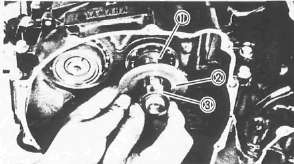
1. Install:
• Thrust plate 1
• Oil pump drive sprocket 2
12 Nm (1.2m-kg, 8.7 ft-lb)
2. Hook the drive chain on the drive sprocket.
3 Install:
• Collar 3
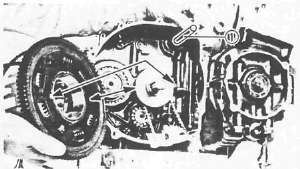
4. Install:
• Water pump drive shaft 1
• Clutch housing
CAUTION:
Be sure that the oil pump drive gear tabs engage the clutch housing grooves on its back or the tabs will be damaged when tightening the clutch boss securing nut.
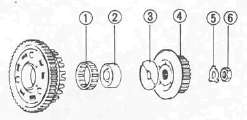
5. Install:
• Bearing 1
• Spacer 2
• Thrust plate 3
• Clutch boss 4
• Lock washer (New) 5
• Nut 6
Clutch Boss: 70 Nm (7.0 m kg, 50 ft lb)
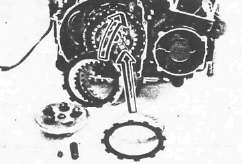
6. Bend lock washer tabs against the nut flats.
7. Install:
• Friction plates
• Clutch plates
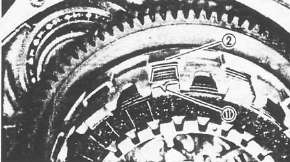
8. Install:
• Friction plate (with V-cut 1 in tab)
NOTE:
Install the friction plate so that the V-cut tab is in the identified dog 2 . If you forget to identify the position with a mark, measure the width of each dog. 13.8 mm (0.543 in) width is for that position. The other width are 14 mm (0.551 in).
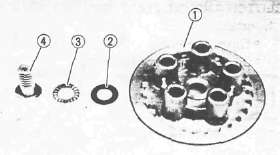
9. Install:
• Plate washer 2
• Thrust bearing 3 onto the pull rod 4
• Pull rod 4 into the pressure plate 1
10. Install:
• Pressure plate
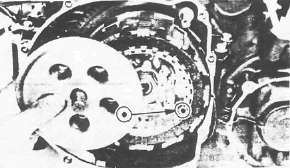
NOTE:
Align a dot on the clutch boss with a dot on the pressure plate.
• Clutch springs
Clutch Spring: 8 Nm (0.8 m-kg, 5.8 ft-lb)
11. Install:
• Oil baffle plate
• Dowel pins
• Gasket
• Clutch cover
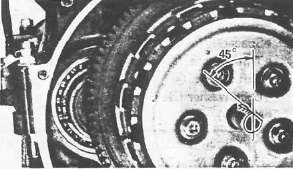
NOTE:
Set the gear of the clutch pull rod facing approximately 45° from horizontal toward the rear.
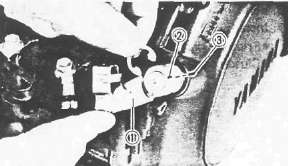
• Set the clutch lever 1 on the right crankcase cover parallel to the gasket surface.
• Make sure that the punch mark on the lever 2 align with the mark on the crankcase cover 3 when pushing the lever towards the front by hand.
Clutch Cover: 1 2 Nm(1.2m-kg,8.7ft-lb)
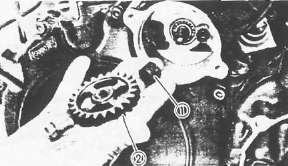
12. Install:
• Spacer 1
• Water pump drive gear 2
• Water pump drive gear cover.
Water Pump Drive Gear: 12 Nm (1.2 m-kg, 8.7 ft-lb) LOCTITE®
Cover: 8Nm(0.8m-kg, 5.8ft-lb)
Middle Gear, Generator, Starter and Pickup Coil
Middle Gear, Generator, Starter and Pickup CoilMIDDLE GEAR
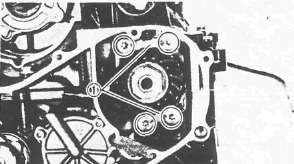
1. Install:
• Bearing retainers 1
• TORX screws (New)
• Oil level maintaining plug
Bearing Retainer: 25 Nm (2.5 m-kg, 18 ft-lb)
2. Stake the screw heads to the dents on the bearing retainers with a center punch.

3. Install:
• Shims 1
• Middle driven gear housing 2
• Bolt
Middle Driven Gear Housing: 25 Nm (2.5 m-kg, 18 ft-lb). Use LOCTITE®
SHIFTER
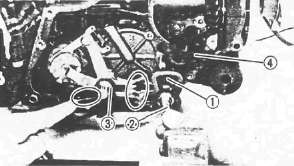
1. Install:
• Washer 1
• Shift shaft 2
• Shift lever3
• Oil level maintaining plug 4
• Gasket
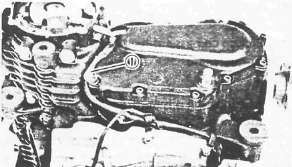
2. Install:
• Crankcase cover
• Wire harness clip 1
• Bolts
Crankcase Cover: 12 Nm (1.2 m-kg, 8.4 ftlb)
GENERATOR AND STARTER
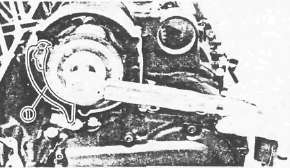
1. Install:
• Rotor Use Rotor Holding Tool (90890-04043) 1 .
Rotor: 55 Nm (5.5 m-kg, 40 ft-lb)
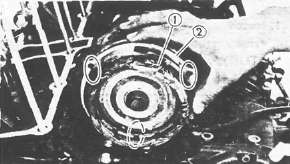
2. Install the stator coil 1
NOTE:
Align the grooves on the stator coil core with the bolt holes on the crankcase.
• Gasket 2
• A.C.G. cover
A.C.G. Cover: 12 Nm (1.2 mkg, 8 .4 ft-lb)
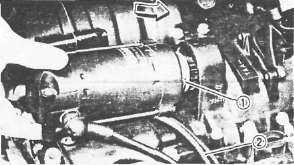
3. Install:
• Starter motor
• Bolts
Starter Motor: 7 Nm (0.7m-kg, 5 .1 ft-lb)
NOTE:
• Be careful the O-ring 1 is not damaged when installing the starter motor.
• Route the A.C.G. lead wires 2 as shown.
PICKUP COIL
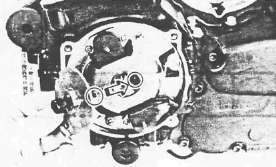
1. Install:
• Pickup coil assembly
• Timing plate
NOTE: Align the locating pin on the crankshaft with the corresponding slot in the timing plate.
Pickup Bolt: 8 Nm (0.8 m-kg, 5.8 ft-lb)
Timing Plate: 24 Nm (2.4 m-kg, 17 ft-lb)
Pistons and Cylinder
Pistons and CylinderPISTON AND CYLINDER
1 Cylinder head gasket
2 Dowel pin
3 Drain bolt
4 Oil delivery pipe
5 O-ring
6 Cylinder base gasket
7 Piston ring
8 Piston pin clip
9 Piston pin
10 Copper washer
1. Install:
• Piston rings (onto the pistons)

NOTE:
Be sure to install the rings so that Manufacturer's marks or numbers are located on the top side of the rings. Oil the pistons and rings liberally.
2. Install pistons.
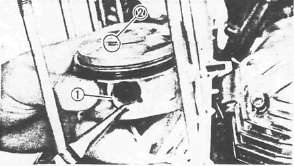
NOTE:
• Be sure the piston is positioned correctly.
• Always install new piston pin clips 1
• The "EX" mark 2 on the piston should face toward the front (Exhaust side).
3. Oil liberally:
• Pistons
• Rings
• Cylinders
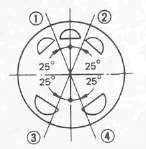
4. Set piston ring ends as per the above diagram.
CAUTION:
Make sure the ends of the oil ring expanders do not overlap.
1 TOP
2 OIL RING (LOWER RAIL)
3 OIL RING (UPPER RAIL)
4 2ND
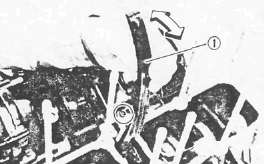
5. Install:
• Cam chain guide (Rear) 1
Cam Chain Guide (Rear): 10 Nm (1.0m-kg, 7.2ft-lb)
6. Check guide movement. Reassemble if the action is not smooth.
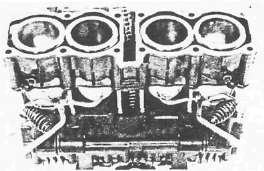
7. Install:
• Dowel pins
• Gasket (New)
• Cylinder
CAUTION:
• Be careful not to damage the cam chain guide during installation.
• Pass the cam chain through the cam chain cavity.
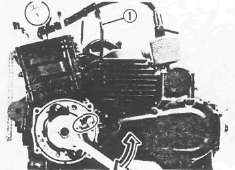
8. Position oil delivery pipe 1
9. Set the dial gauge on the No. 1 piston head center as shown to find the No. 1 piston top dead center and check whether the "T" mark on the timing plate and stationary pointer are aligned or not. If not, loosen the pointer securing screw and adjust.
Cylinder Head
Cylinder HeadCYLINDER HEAD
1 Check bolt
2 Dowel pin
3 Camshaft case gasket
4 Valve guide
5 O-ring
6 Camshaft case
7 Cylinder head
8 Oil pipe
[A] Be sure the "UP" mark faces upward.
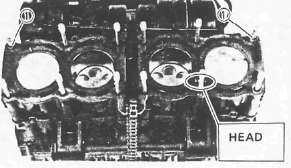
1. Install:
• Dowel pins 1
• Cylinder head gasket (New)
• Cylinder head
NOTE:
• Be careful not to damage the cam chain guide during installation.
• Pass the cam chain through the cam chain cavity.
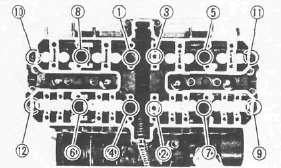
2. Tighten nuts in sequence as shown and torque the nut in two stages.
Cylinder Head: [10 mm ] 37 Nm (3.7 m-kg, 27 ft-lb)
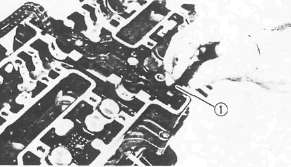
3. Install the cam chain guide (Front) 1
NOTE:
The lower end of chain guide must rest in the cam chain guide slot in the crankcase.
Camshafts
CamshaftsCAMSHAFT
1 Cam cap
2 Dowel pin
3 Cam chain sprocket (IN)
4 Cam chain sprocket (EX)
5 Camshaft (IN)
6 Camshaft (EX)
7 Lifter
8 Adjusting pad
9 Cam chain guide (Front)
10 Oil delivery pipe
11 Copper washer
12 Camchain tensioner
13 Camchain tensioner end cap bolt
14 Camchain guide (Upper)
15 Valve retainer
16 Spring seat
17 Valve spring
18 Spring seat
19 Oil seal
20 Valve
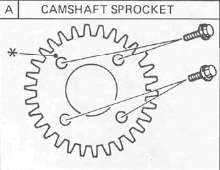
* When installing the sprocket, use holes except for the one with a punch mark.

Camshaft installing steps:
• Align the "T" mark on the timing plate 1 with the stationary pointer 2 . Do not turn the crankshaft during the camshafts installation.
• Install the cam chain sprockets onto the camshafts.
• Apply engine oil to the camshaft bearing surface.
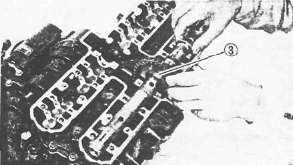
• Turn the camshafts by hand so that the timing marks 3 (o: small hole) on the camshafts face upward.
• Install the dowel pins into the cam caps.
• Install the caps (without IN3 and EX3) onto the camshafts and tighten the cap bolts.
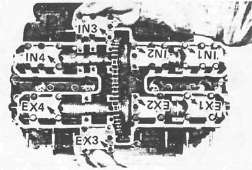
NOTE:
• The arrow mark on the caps should face toward the outside.
• The numbers are punched on the camshaft caps in increments from left to right.
Cam Cap: 10 Nm (1.0m-kg, 7.2 ft-lb)
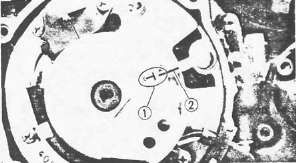
2. Install cam chain sprockets
Cam chain sprockets installing steps:
• Align the "T" mark on the timing plate 1 with the stationary pointer on the pickup coil 2 . Do not turn the crankshaft when installing the sprockets.
• Place the cam chain onto the exhaust sprocket.
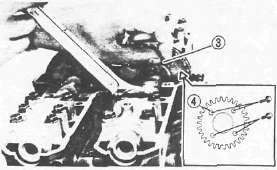
• Install the sprockets and finger tighten the sprocket bolts 3
NOTE:
When installing the sprocket, use holes except for the one with a punch mark 4.
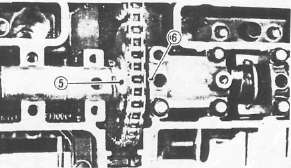
• Rotate the exhaust camshaft to align the punched mark on the camshaft 5 with the "—" mark on the EX2 cam cap 6
• Force the exhaust camshaft clockwise to remove the cam chain slack.
• Place the cam chain onto the intake sprocket.
• Install the sprocket and finger tighten the sprocket bolt.
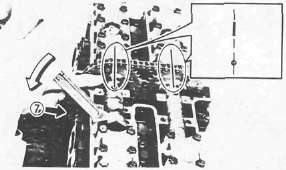
• Rotate the intake camshaft to align the punched mark on the camshaft with the "—" mark on the IN2 cam cap.
• Force the intake camshaft clockwise to remove all the cam chain slack.
• Insert your finger into the cam chain tensioner hole, and push the cam chain guide inward 7.
•While pushing the cam chain guide, be sure camshaft timing marks align with the cap marks.
• Remove the intake sprocket if marks do not align.
• Change the meshing position of sprocket and cam chain.
3. Install the cam chain tensioner
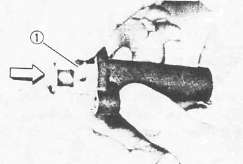
Cam chain tensioner installation steps:
• Remove the tensioner end cap bolt and spring.
• Release the cam chain tensioner one-way cam 1 and push the tensioner rod into the tensioner body.
• Install the tensioner with a new gasket onto the cylinder.
Tensioner Body: 10Nm(1.0m-kg, 7.2ft-lb)
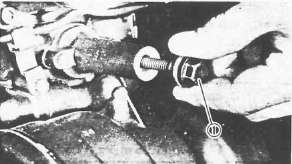
• Install the tensioner springs and end cap bolt 1 . Tighten the bolt.
Tensioner End Cap Bolt: 9 Nm (0.9m-kg, 6.5 ft-lb)
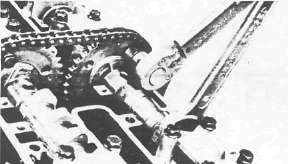
• Turn the crankshaft and install the sprocket securing bolts.
• Tighten the sprocket bolts.
Sprocket: 20 Nm (2.0m-kg, 14ft-lb)
CAUTION:
Be sure to attain the specified torque value to avoid the possibility of these bolts coming loose and causing damage to the engine.
Install the caps (IN3 and EX3) and camchain guide (Upper).
4. Apply engine oil to the cam chain, sprockets, camshafts, and valves.
5. Turn the crankshaft counterclockwise a few turns to ensure that it turns smoothly.
CAUTION:
Be sure the exhaust and intake camshaft mark are aligned with the cam cap marks.
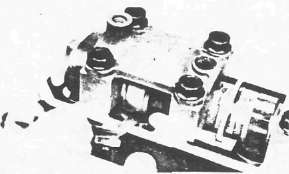
6. Measure:
Valve clearance
Out of specification -> Adjust.
IN: 0.11 -0.20 mm (0.004 ~ 0.008 in)
EX: 0.21 -0.30 mm (0.008-0.012 in)
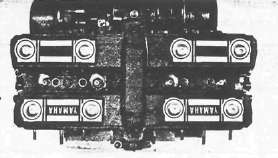
7. Install:
• Cylinder head cover
• Bolts
• Spark plugs
Cylinder Head Cover: 10 Nm (1.0m-kg, 7.2fMb)
SparkPlug: 17 .5 Nm (1.75 m-kg, 12 .5 ftlb)
8. Install:
• Gasket
• Crankshaft end cover (Left)
• Screw
Crankshaft End Cover (Left): 7 Nm (0.7 m-kg, 5.1 ft-lb)
Radiator Pipes, Carburettor Joints and Oil Delivery Pipe
Radiator Pipes, Carburettor Joints and Oil Delivery PipeRADIATOR PIPES, CARBURETOR JOINT, AND OIL DELIVERY PIPE
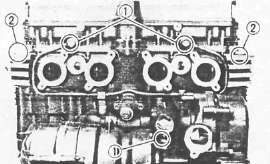
1. Install:
• Union bolt with copper washer 1
• Cylinder head side cover 2
Oil Delivery Pipe: 21 Nm (2.1 m-kg, 15 ft-lb)
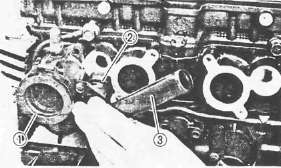
2. Install:
• Carburetor joints 1
• Radiator pipes (with O-ring 2 ) 3
Carburetor Joint: 12 Nm (12 m-kg, 8 .7 ft-lb)
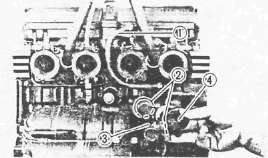
3. Install:
• Bypass hose 1
• O-rings 2
• Radiator pipe 3
• Water purnp joint 4
Water Pump Joint: 10 Nm (1.0 m-kg, 7.2 ft-lb)
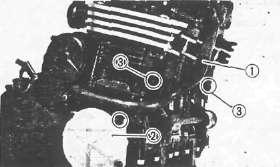
4. Install:
• Radiator pipe 1
• Cover (Right) 2
Radiator Pipe: 8Nm (0.8m-kg, 5.8ft-lb)
Cover: 8 Nm (0.8m-kg, 5.8 ft-lb)
• Drain bolts 3
Middle Gear Service
Middle Gear ServiceMIDDLE GEAR SERVICE
1 Spring retainers
2 Spring seat
3 Damper cams
4 Midde drive gear shim
5 Bearing
6 Bearing retainer
7 Middle drive shaft
8 Middle driven shaft
9 Shim
10 O-ring
11 Bearing housing
12 Oil seal (35 x 5 0x6)
Gear Lash Measurement and Adjustment
Gear Lash Measurement and AdjustmentGEAR LASH MEASUREMENT
NOTE:
The middle gear lash can be checked only when the gears are installed in the crankcase.
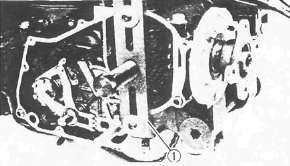
1. Attach:
• Middle Drive Pinion Holder (90890-04051) 1 .
NOTE:
Before installing the tool, loosen the holder bolt all the way out and after installation tighten this bolt as tight as necessary (finger tight is generally sufficient).
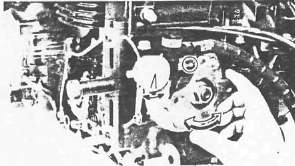
2. Attach a dial gauge against the middle drive flange as shown
3. Measure middle gear lash by rotating the flange gently back and forth. Follow Gear Lash Adjustment procedure if lash is not within specified limits.
Middle Gear Lash: 0.1 - 0.2 mm (0.004 - 0.008 in)
NOTE: Check this engagement at 4 points. If the gear lash exceeds the specified limit and adjustment is necessary, the engine or swing arm should be removed from the motorcycle.
GEAR LASH ADJUSTMENT
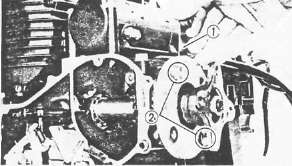
1. Install the driven gear housing assembly into the crankcase leaving about a 2 mm (0.080 in) gap 1 between the housing and crankcase and install the two bolts 2 to the bearing housing 180° opposite to each other.
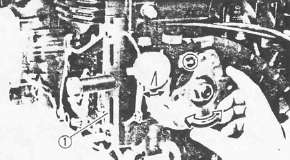
2. Attach:
• Middle Drive Pinion Holder (90890-04051)1 .
• Dial gauge
3. Slowly tighten the bolts alternately until the dial gauge lash measurement reaches 0.2 mm (0.008 in).
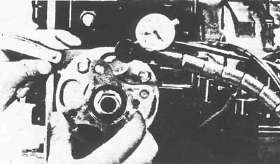
4. Measure the clearance between the bearing housing and the crankcase. This clearance is the shim size required.
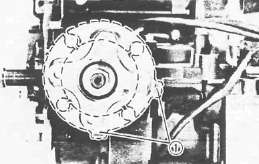
5. Install the proper sized shim(s) 1
6. Tighten the bearing housing.
Bearing Housing: 25 Nm (2.5 mkg, 18 ft-lb)
7. Recheck the middle gear lash. Readjust if necessary.
Middle Gear Removal and Disassembly
Middle Gear Removal and DisassemblyREMOVAL
Middle Drive Gear
NOTE:
Middle drive gear and its shims can be removed without separating the engine.
1. Remove the clutch cover. Refer to "ENGINE DISASSEMBLY."

2. Strike the middle drive shaft out 1
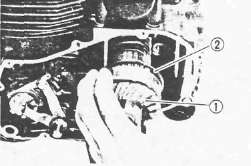
3. Remove
• Middle drive shaft 1
•Shims 2
DISASSEMBLY Middle Drive Gear
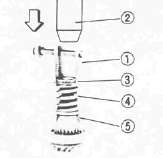
1. Remove:
• Spring retainer. Use Damper Compressor (90890-04090) 1 with hydraulic press 2 .
• Spring seat 3
• Spring 4
• Damper cam 5
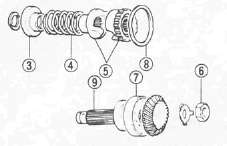
6 Middle drive shaft nut
7 Bearing
8 Shim
9 Middle drive shaft
NOTE:
Perform following steps only if middle-drive-shaft bearing or gear must be replaced.
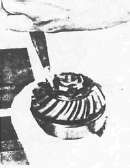
2. Secure middle drive shaft in a vise.
3. Flatten the locking collar of the nut with a center punch.
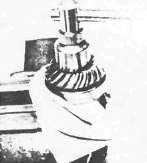
4. Remove:
• Middle drive shaft nut
• Bearing
• Middle drive pinion
Middle Driven Gear
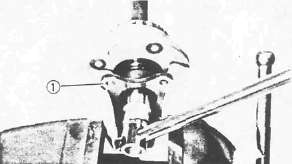
1. Support the drive flange in a vise securely.
2. Remove:
• Flange holding nut
• Flange 1
Middle Gear Inspection and Reassembly
Middle Gear Inspection and ReassemblyINSPECTION
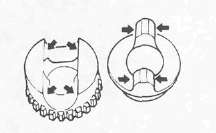
1. Check
• teeth of middle gear for discoloration/Pitting/Wear. If necessary, replace all middle gears as a set.
• Damper cam surfaces for wear/Unsmooth action. Replace if necessary.
2. Check bearing movement. Rotate the race by finger and replace if rough.
ASSEMBLY AND ADJUSTMENT
1. Select proper middle-drive-gear shim.
NOTE:
Select proper middle-drive-gear shim whenever crankcase and/or middle gears are replaced.
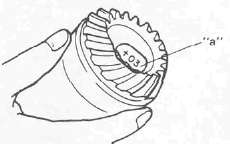
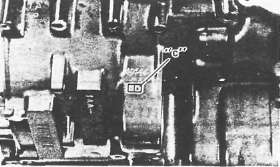
Shim thickness calculation:
Calculate shim thickness using formula below:
Shim thickness (A) = c - a - b
a = 43 plus or minus the number printed on end of middle drive shaft.
b = a bearing thickness. (Considered constant)
c = 60 plus the number found on the upper crankcase half near the main bearing selection numbers:
For example:
If middle drive shaft is marked "+03" and crankcase is tamped "45".
a= 43 + 0.03 = 43.03 mm
c= 63 + 0.45 = 60.45 mm
b= 16.94 mm (Constant)
A = 60.45 - 43.03 - 16 .94 = 0.48 Calculated shim thickness is 0.48 mm.
Available shim thickness: 0.15 mm, 0.30 mm, 0.40 mm, 0.50 mm
Because shim can only be selected in 0.05 mm increments, use following chart to round off the hundredths digit of calculated thickness, and select appropriate shim.
|
Hundredths digit |
Rounded value |
|
0,1,2 |
0 |
|
3,4,5,6 |
5 |
|
7,8,9 |
10 |
In above example, calculated shim thickness is 0.48 mm. The chart instructs you, however, to round off the 8 to 10. Thus you should use two 0.50 mm shims.

2. Install:
• Middle drive shaft bearing.
• Middle drive pinion
• Lock washer (New)
• Nut
3. Tighten the nut
4. Bend lock washer of nut into middle drive shaft slot using a center punch.
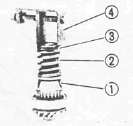
5. Assemble:
• Damper cam 1
• Spring 2
• Spring seat 3
• Spring retainer
Use a Press and Damper Compressor (90890-04090)4.
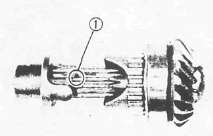
NOTE:
Install the driven damper cam onto the drive pinion shaft with the cam lobes positioned 90° from the row of shaft oil holes 1. Positioning tolerance is ±1 spline (15°) from the 90° position.
Middle Drive Shaft Nut: 110 Nm (11 m-kg, 8 0 ft-lb)
6. Install:
• Bearing housing (onto the drive pinion shaft)
• Flange
• O-ring (New) (onto the drive pinion shaft)

7. Tighten:
• Flange holding nut
Flange Holding Nut: 90 Nm (9.0 m-kg, 65 ft-lb) LOCTITE®
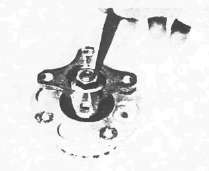
8. Lock the thread on the holding nut with a center punch.
Remounting the Engine
Remounting the Engine
1. Refer to engine removal. Reverse those removal steps that apply.
2. Tighten engine mounting bolts
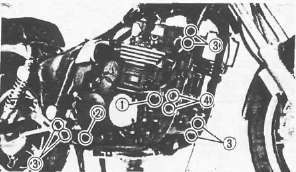
Engine Mounting Bolt: Front 1: 42 Nm (4.2 m-kg, 30 ft-lb)
Rear 2 : 90 Nm (9.0 m-kg, 65 ft-lb)
Down Tube 3 , Bracket 4 : 33 Nm (3.3 m-kg, 24 ft-lb)
3. Connect:
• Pickup coil lead
• Generator lead
• Neutral switch lead
• Oil level switch lead
• Starter motor lead
• Crankcase ventilation hose
• Battery leads
NOTE:
•See CHAPTER 8 "Cable Routing" for proper cable, lead, and hose routing.
• Connect the battery positive lead first.
• Make sure that the cables are not twisted.
• Be careful not to pinch the leads.
4. Install the Carburetors. Note: see Carburetor section for further details.
5. Connect:
• Throttle cable
• Starter cable
6. Tighten the air cleaner case mounting bolts
Air Cleaner Case: 10Nm{1.0m-kg, 7.2ft-lb)
7. Install:
• Fuel tank
• Seat
8. Add:
• Engine oil
Engine Oil: 3.5 L (3.1 Imp qt, 3.7 US qt)
• Coolant
Recommended Coolant: High Quality Ethylene Glycol Antifreeze Containing Anti-corrosion for Aluminum Engine Inhibitors Coolant and Water.
Mixed Ratio: 50%/50%
Total amount: 2.4 L (2.11 Imp qt, 2.54 US qt) .
Reservoir Tank Capacity: 0.49 L (0.43 Imp qt, 0.52 US qt)
From "LOW" to "FULL" Level: 0.14 L (0.12 Imp qt, 0.15 US qt)
Chapter 4, COOLING SYSTEM
Chapter 4, COOLING SYSTEMDescription
DescriptionCOOLANT FLOW
The coolant is circulated by an impeller type pump mounted on the right-hand crankcase and driven by a gear. The coolant is drawn by the pump from the bottom tank of the radiator, through the pipe 1, and discharged into the cylinder head and cylinder through the pipe 2. The coolant passes from the cylinder head through coolant ways and after circulating around combustion chamber jacketing enters the radiator upper tank via inlet pipe 3. The heated coolant from the engine then passes down through the finned tubes to the bottom tank of the radiator. These finned tubes present a large surface area to the air and dissipate the heat.
4 Radiator
5 Water pump
6 Thermostatic valve
Draining the System
Draining the SystemCOOLANT DRAINING
Do not remove the radiator cap when the engine and radiator are hot.
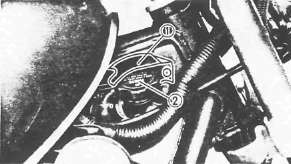
1. Remove:
•Cap retainer 1
Radiator cap 2
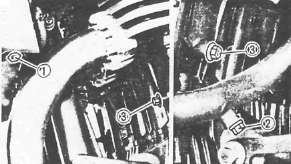
2. Place an open container under the engine.
3. Remove:
• Drain bolts 1, 2 & 3. Drain the coolant.
1 Drain bolt (Radiator) 2 Drain bolt (Radiator pipe) 3 Drain bolt (Cylinder)
Water Pump
Water PumpREMOVAL AND DISASSEMBLY
NOTE:
Be sure to drain the coolant before disassembly of the cooling system components.
1. Drain the engine oil
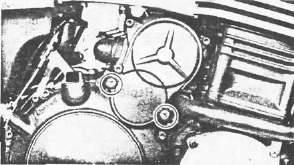
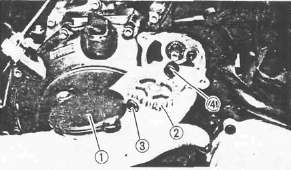
2. Remove:
•Water pump drive gear cover 1
•Water pump drive gear 2
Water pump drive gear bolt 3 is locked with LOCTITE®.
•Spacer 4
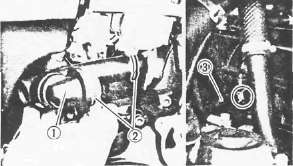
3. Remove:
• Water pump joint 1
• O-rings 2
4. Disconnect bypass hose 3
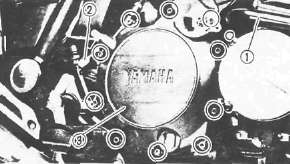
5. Remove:
• Radiator pipe 1
• Clutch cam shaft lever 2
• Clutch cover 3
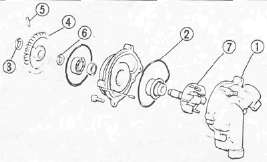
5. Remove:
• Water pump cover 1
• O-ring 2
• Circlip 3
• Driven gear 4
• Dowel pins 5
• Circlip 6
• Impeller shaft 7
INSPECTION
1. Eliminate deposits from the impeller and water pump housing.
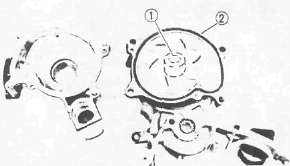
2. Inspect:
• Oil seal 1
• O-ring 2
Replace if worn or damaged.
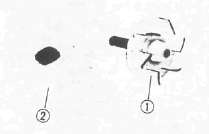
3. Inspect:
• Impeller 1
• Driven gear 2
Replace if cracked, worn or damaged.
ASSEMBLY AND INSTALLATION
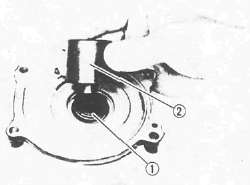
1. Install:
• Oil seal (Mechanical seal) 1 Use Water Pump Seal Installer (90890-04078) 2 and Handle (90890-04058).
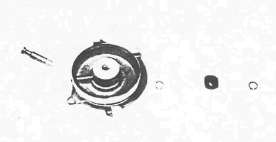
2. Assembly:
• Water pump Reverse the disassembly procedures.
Water Pump Cover: 10 Nm (1.0m-kg, 7.2ft-lb)
3. Install:
• Clutch cover Refer to CHAPTER 3 "ENGINE ASSEMBLY AND ADJUSTMENT"
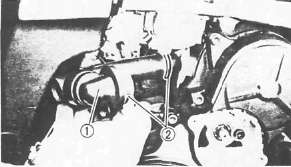
• Water pump joint 1 (With new O-rings 2)
Water Pump Joint: 10Nm(1.0mkg, 7.2ft-lb)
4. Connect the bypass hose
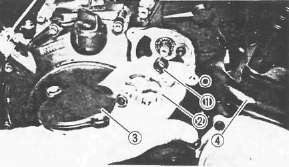
5. Install:
• Spacer 1
• Water pump drive gear 2
• Water pump drive gear cover 3
• Radiator pipe 4 (With new O-ring)
Water Pump Drive Gear: 12Nm (1.2m.kg, 8.7ft-lb) LOCTITE®
Water Pump Drive Gear Cover: 8Nm (0.8 m-g, 5.8 ft-lb)
Thermostat
Thermostat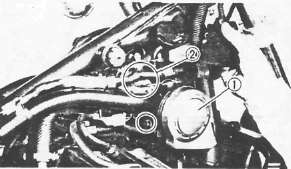
REMOVAL AND DISASSEMBLY
1. Drain coolant
2. Remove horns 1
3. Disconnect electrical leads 2
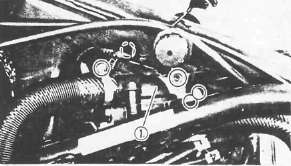
4. Disconnect coolant hoses
5. Remove thermostat housing 1
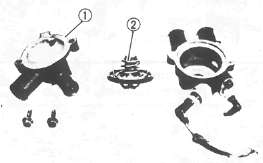
6. Remove:
• Thermostat cover 1
• Thermostatic valve 2
INSPECTION
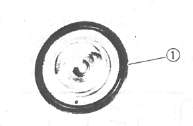
1. Inspect o-ring 1 Replace if worn or damaged.
2. Check thermostatic valve and replace if out of specification.
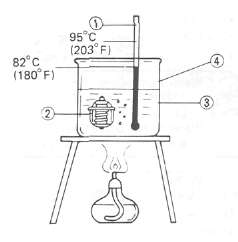
1 Thermometer 2 Thermostatic valve 3 Water 4 Vessel
Inspection steps:
• Suspend thermostatic valve in a vessel of water.
• Place reliable thermometer in water.
• Heat water slowly.
• Observe thermometer, while stirring water continually.
Thermostatic Valve Opening Temperature: 82°C (180°F)
Full Open Temperature/Lift: 95°C(203°F)/8mm (0.31 in) or more
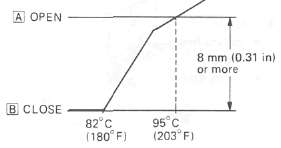
NOTE:
Thermostat is sealed and its setting is specialized work. If its accuracy is in doubt, always replace it. A faulty unit could cause serious overheating or overcooling.
ASSEMBLY AND INSTALLATION
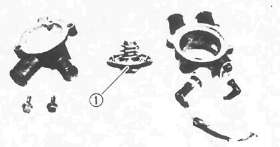
1. Install:
• Thermostatic valve 1
• Thermostat cover
NOTE:
Install the thermostatic valve so that the breather hole is forward.
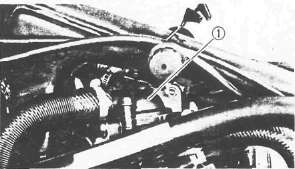
2. Install the thermostat housing 1
3. Connect:
• Radiator hoses
• Electrical leads
4. Install the horns
Radiator & Filling
Radiator & FillingREMOVAL
1. Drain coolant
2. Remove radiator assembly
Refer to CHAPTER 3 "ENGINE REMOVAL".
INSPECTION
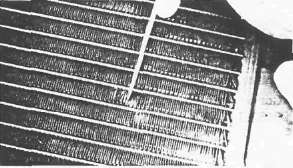
1. Inspect:
• Radiator fins. Blow out obstructions with compressed air through rear of radiator. Straighten bent fins with a radiator comb.
• Coolant hoses. Replace if cracked or damaged.
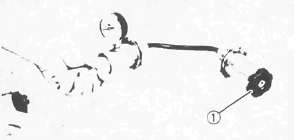
2. Measure:
• Valve opening pressure (Radiator cap 1 ) Use the Cooling System Tester (90890-01325). Replace if out of specification.
Valve Opening Pressure: 78-98kPa(0.8 -1.0 kg/cm, 11.4-14.2 lb/in2)
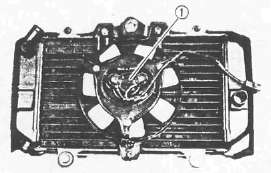
• Fan motor assembly 1

3. Check valve in the radiator cap for weak spring/defective seating. Replace radiator cap if defective.
INSTALLATION
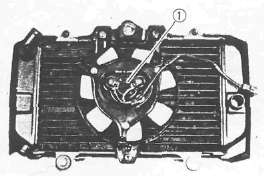
1. Install fan motor assembly 1
2. Tighten bolts.
Fan Motor: 7Nm(0.7m-kg, 5.1ft-lb)
3. Install radiator assembly
4. Tighten bolts
Radiator: 7Nm(0.7m-kg, 5.1 ft-lb)
5. Add coolant
6. Check cooling system.
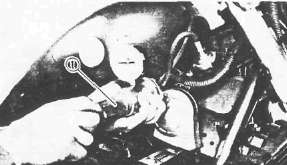
Inspection steps:
• Connect the Cooling System Tester (90890-01325)1.
• Apply 98 kPa (1.0 kg/cm2, 14 psi) pressure.
• Measure pressure with gauge.
Decrease of pressure indicates leaks in system. Locate and repair as required.
Coolant: Use High-Quality Ethylene Glycol Anti-Freeze Containing Anti-Corrosion Inhibitors for Aluminum Engines.
Coolant and Soft Water Mix Ratio: 50%/50%
Total Amount: 2.40 L (2.11 Imp qt, 2.54 US qt)
Reservoir Tank Capacity: 0.49 L (0.43 Imp qt, 0.52 US qt)
From LOW to FULL Level: 0.14 L (0.12 Imp qt, 0.15USqt)
CAUTION:
Hard water or salt water is harmful to the engine parts. You may use boiled water or distilled water if no soft water is available.
COOLANT FILLING
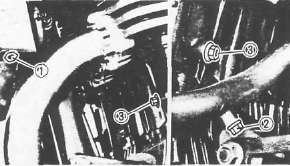
1. Tighten: • Coolant drain bolts 1, 2 ,3
Drain Bolt: 16 Nm (1.6m-kg, 11 ft-lb)
2. Fill radiator
Coolant filling steps:
• Remove the radiator cap.
• Pour coolant into the radiator to specified level.
• Start the engine (Coolant level decreases).
• Add coolant while the engine is running.
• Stop the engine when coolant level stabilizes.
• Add coolant again to specified level.
• Install the radiator cap.
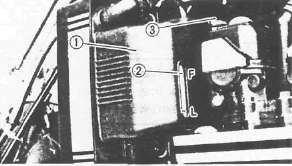
CAUTION:
Always check coolant level, and check for coolant leakage before starting the engine.
3. Fill the reservoir tank 1
Add coolant until liquid reaches "FULL" level mark 2 .
4. Install the reservoir tank cap 3
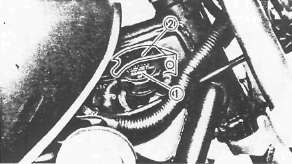
5. Install:
• Radiator cap 1
• Cap retainer 2
Chapter 5, CARBURETION
Chapter 5, CARBURETIONGeneral Information and Operation
General Information and OperationCARBURETION
CARBURETOR
1 Piston valve spring
2 Starter plunger assembly
3 Upper bracket4 O-ring5 Joint
6 Lower bracket
7 Throttle stop screw
8 Synchronizing screw
9 Washer
10 Main jet
11 Valve seat assembly
12 Float
13 Gasket
14 Drain screw
15 Float chamber
16 Pilot jet
17 Needle jet
18 Spring
19 Piston valve
20 Diaphragm
21 Jet needle assembly
|
SPECIFICATIONS |
|
|
Main jet |
= 105 |
|
Main air jet |
= 120 |
|
Jet needle |
5FZ83 |
|
Needle jet |
Y-2 |
|
Pilot jet |
#37.5 |
|
Pilot air jet |
= 140 |
|
Fuel level |
3.0 ± 1.0 mm |
|
Float height |
17.5+ 1.0 mm |
|
Pilot screw |
2-1/2 ± 1/2 |
|
Float valve seat |
0 2.3 |
|
Engine idle speed |
1,050 ± 50r/min |
SECTION VIEW
|
A |
|
AIR |
|
B |
|
MIXTURE |
|
C |
|
FUEL |
1 Piston valve
2 Spring
3 Jet needle
4 Main air jet
5 Pilot air jet
6 Main jet
7 Pilot jet
8 Needle jet
9 Throttle valve
10 Bypass hole
11 Pilot outlet
12 Pilot screw
13 Starter plunger
14 Starter jet
15 Starter bleed pipe
16 Starter air bleed
17 Mixture outlet
18 Air inlet
19 Starter half position
20 Starter full position
AIR CLEANER AND CRANKCASE VENTILATIONS SYSTEM
Refer to "CHAPTER 2" for air cleaner maintenance.
|
A |
|
FRESH AIR |
|
B |
|
BLOW BY GAS |
1 Air cleaner 2 Carburetor
Fuel Level Adjustment
Fuel Level Adjustment1. Measure fuel level. Adjust if out of specification.
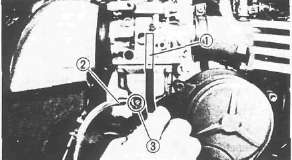
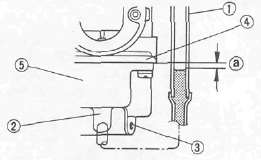
Measurement steps:
• Place the motorcycle on a level surface.
• Shim the center stand as required to level from side to side using a level across the carb bank
NOTE: The carburetor bank can be used as a level. Set petcock to "PRI" or use temporary fuel supply. Check that the fuel level of one carb against both left and right sides of bank is be equal.
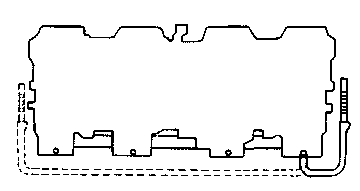
• Use a garage jack under the engine or block under the front wheel to ensure that the carburetor is positioned vertically by raising the front wheel until the rear is touching the ground.
• Take measurements at center of closest outboard Carburetor body
• Connect the Fuel Level Gauge 1 (90890-01312) to the drain opening 2 .
• Loosen the drain screw 3 and start the engine.
• Check the fuel level, one carburetor at a time.
Fuel Level a: bottom of meniscus to bottom edge of the carburetor body 3.0 ±1.0 mm (0.12 ± 0.04 in)
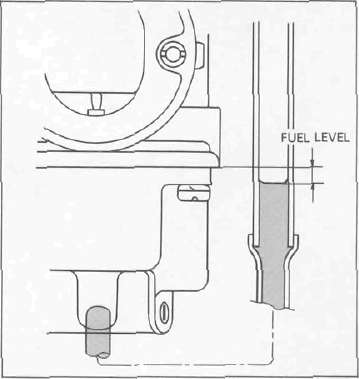
NOTE:
• Raise the hose as high as possible before opening the drain screw, and slowly lower the hose into position to ensure no air is trapped in the hose.
• Once the drain screw is open, lower it into position. Never raise the hose while taking the measurements. Raising the hose will make the measurement inaccurate.
• Set the petcock to "PRI" or use a temporary fuel supply
• Watch the level carefully for a few moments after taking the reading. If the level slowly rises, the float needle valve is leaking and must be polished or replaced.
2. Adjust:
• Fuel level (If necessary)
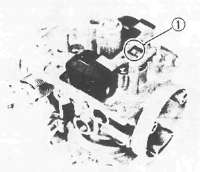
Adjustment steps:
• Remove the carburetors.
• Adjust float level by bending the float tang 1 slightly.
• Repeat the procedure for the other carburetors.
NOTE: It's easy to lose track of the carb #s once you flip them upside down to make that float tang adjustment. Marking the #1 carb with a piece of tape will help keep them identified.
Carburetor Overhaul
Carburetor Overhaul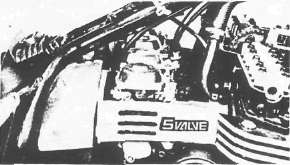
REMOVAL
1. Remove carburetor assembly. Refer to engine removal section.
NOTE: The following parts can be cleaned and inspected without disassembly.
• Piston valve
• Jet needle
2. Disconnect:
• Drain hoses
• Fuel hoses
• Throttle cable
3. Number each carburetor before removing it from carburetor brackets.
4. Loosen the starter lever screws
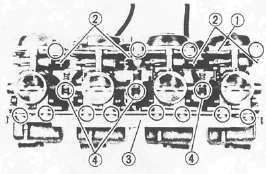
5. Remove:
• Starter lever shaft 1
• Starter levers 2
• Lower bracket 3
NOTE:
When separating the carburetors be sure not to lose the small spring 4 that may fall out. This spring connects the throttle levers.
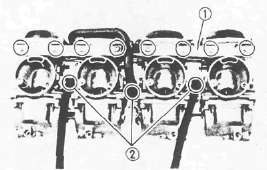
6. Remove:
• Upper bracket 1
• Carburetor joint 2
• Carburetors
DISASSEMBLY
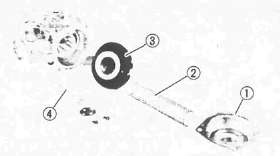
1. Remove:
• Vacuum chamber cover 1
• Spring 2
• Vacuum piston 3
• Jet needle 4
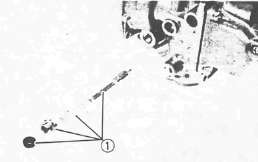
2. Remove the starter plungers 1
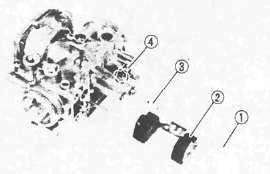
3. Remove:
• Float chamber cover
• Float pin 1
• Float 2
• Needle valve 3
• Valve seat 4
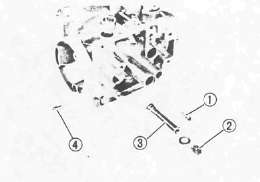
4. Remove:
• Pilot jet 1
• Main jet 2
• Needle jet 3
• Pilot air jet 4
NOTE:
Remove the needle jet toward the vacuum piston.
Inspection and Assembly
Inspection and AssemblyINSPECTION
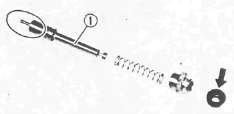
1. Inspect the starter plunger 1 for damage. Replace if damaged or worn.
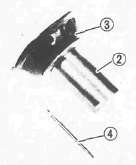
• Vacuum piston 2. Replace if scratched/worn.
•Throttle valve diaphragm 3. Replace if torn or damaged.
•Jet needle 4. Replace if bent or worn.
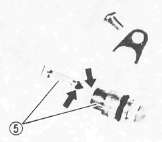
• Needle valve and valve seat 5. Replace if worn.
• Float. Replace if damaged or punctured.
• Carburetor body
• Fuel passage. Clean contaminated or plugged passages.
•Jets. Clean if contaminated or plugged.

• O-rings (Carburetor joint) 6
Wear/Damage -► Replace.
NOTE:
• Wash the carburetor in a petroleum-based solvent. Do not use any caustic carburetor cleaning solutions.
• Blow out all passages and jets with compressed air.
• Do not attempt to push wire through brass jets. If necessary, use a single bristle from a stiff nylon brush.
ASSEMBLY:
1. Assemble the carburetors
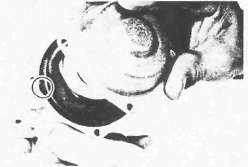
NOTE:
To assemble the carburetors, reverse the disassembly procedures. Pay close attention to the installation of the vacuum piston diaphragm and the location of each jet.
FLOAT HEIGHT ADJUSTMENT
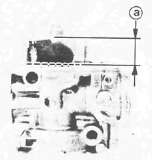
1. Measure float height a
Float height measurement steps:
• Hold the carburetor in an upside down position.
• Incline the carburetor at 60°--70° (so that the end of the float valve does not hang down as a result of float weight).
• Measure the distance from the mating surface of the float chamber (gasket removed) to the too of the float.
NOTE:
The float should be just resting on, but not depressing, the spring loaded inlet needle.
Float Height: 17.5 ± 1.0 mm (0.69 ± 0.04 in)
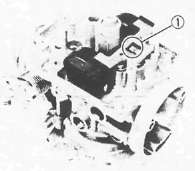
Float height adjustment steps:
• Remove the float.
• Adjust float height by bending the float tang 1 slightly.
• Repeat the procedure for other carburetors.
NOTE:
Float height is an approximation of fuel level. For best results, fine tune fuel level. See Carburetor Adjustments.
Installing Carbs into old, dry rubber manifolds
Installing Carbs into old, dry rubber manifoldsINSTALLATION
1. Install carburetors: Reverse the removal steps.
Yeah, right...
Maxim X Carburetor Installation
A Technique for reinstalling old hardened intake boots. (Note: This will probably not work on other models with long boots)
This is not a Yamaha procedure. It was developed by Joe D. HAP and dv
Step 1. After soaking the rubber in a bucket of hot water, secure each air box boot to the carburetor with it's clamp.
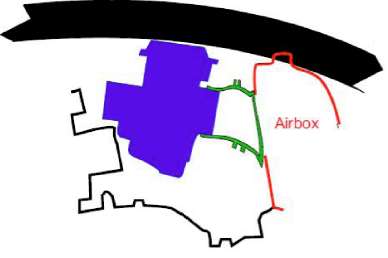
Step 2. Slide the carbs in from the right hand side above the rubber intake manifolds on the engine and below the frame. The free end of the boot is usually much more flexible than the end that has been attached to a hot carburetor for 20 years and will flex. Take care not to pull the boots off the carbs, especially when easing #4 around the clutch cable. This is far easier to accomplish with at least two people. The rubber manifolds will also require some 'massaging* as the float bowls pass by.
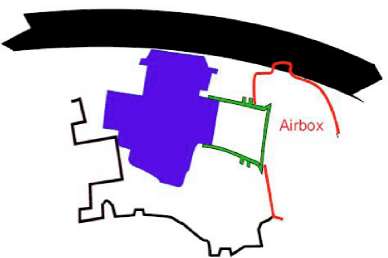
Step 3, Once the carburetors are aligned with their respective intake manifolds, ease the air box boots into their holes. There are two lips that normally sit on either side of the airbox wall. Ignore them for now.

Step 4. Pull back on the carbs enough to gain clearance between the front and the manifolds. Rotate the front of the carbs down into position. Carefully examine all around each one to ensure the rubber has not folded in front of the carb. Use a hooked too: to pull any folds out as required.
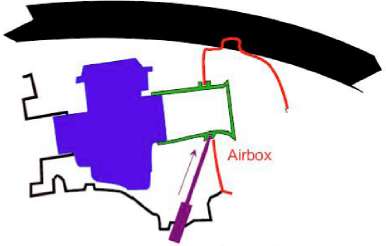
Step 5, Push the carburetors forward into the manifolds. They will snap into place as the lip engages the groove on the carburetor. Secure with clamps. Massage the airbox boots into place with a long straight screwdriver. Now is the time to ensure the sealing lips are properly positioned with one lip on either side of the airbox.
After installation, set the throttle free-play. See Carburetor Adjustments for details.
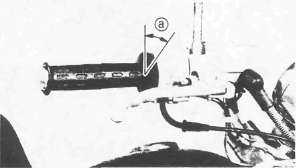
Throttle Cable Free Play a: 2- 5 mm (0.08-0.20 in)
Chapter 6, CHASSIS
Chapter 6, CHASSISFront Wheel
Front Wheel
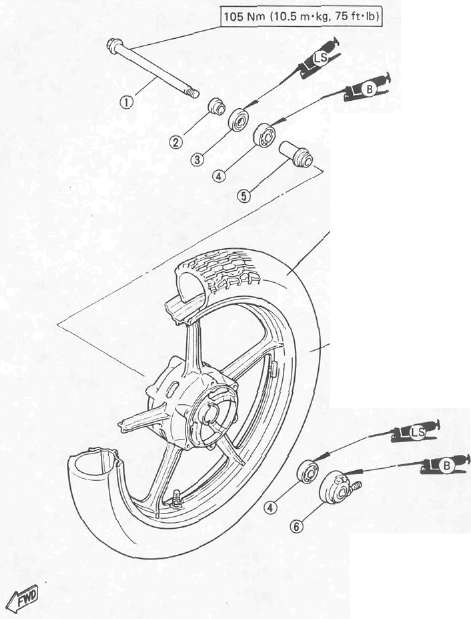
FRONT WHEEL
1 Wheel axle
2 Collar
3 Oil seal
4 Bearing
5 Spacer
6 Speedometer gear unit
7 Tire
|
Basic weight: With oil |
232 kg (511 lb) |
|
|
Maximum load*: |
238 kg (525 lb) |
|
|
Cold tire pressure: |
Front |
Rear |
|
Up to 90 kg |
177 kPa |
196 kPa |
|
90 kg (198 lb) load- |
196 kPa |
275 kPa |
|
High speed riding |
206 kPa |
226 kPa |
*Load is the total weight of cargo, rider, passenger, and accessories.
TIRE SIZE: 100/90-19 57H
WEAR LIMIT: 1.0 mm (0.04 in)
RIM SIZE: MT2.15x 19
RIM RUNOUT LIMIT:
Radial: 2.0 mm (0.08 in)
Lateral: 2.0 mm (0.08 in)
REMOVAL
CAUTION:
Make sure the motorcycle is properly supported.
1. Place the motorcycle on its centerstand and a garage jack under the engine.
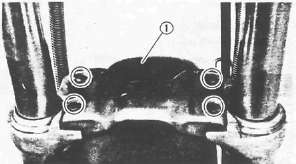
2. Remove:
• Speedometer cable
• Fork brace 1
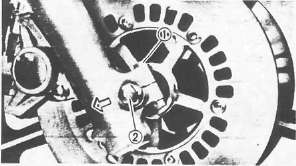
3. Loosen:
• Pinch bolt 1
4. Remove axle 2
NOTE:
Do not depress the brake lever when the wheel is off the motorcycle otherwise the brake pads will be forced shut.
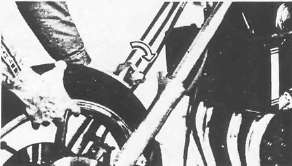
5. Remove front wheel
NOTE:
Lower the wheel until the discs come off the calipers. Turn the calipers outward so they do not obstruct the wheel.
INSPECTION
1. Inspect tire
Tire tread shows crosswise lines ("wear bars") or cracks.
Minimum Tire Tread Depth 1.0 mm (0.04 in)
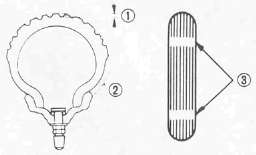
1 Tread depth
2 Sidewall
3 Wear indicator
2. Inspect:
• Front axle
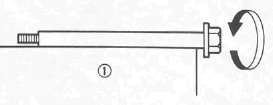
Roll the axle on a flat surface 1. Replace if it is bent.
WARNING:
Do not attempt to straighten a bent axle.
3. Inspect the front wheel. Replace if cracked, bent or warped.
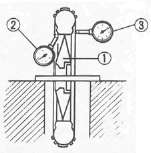
4. Measure the wheel 1 runout
Replace wheel or check bearings if runout exceeds specifications.
Rim Run-Out Limits:
Radial 2 : 2 mm (0.08 in) Lateral 3 : 2 mm (0.08 in)
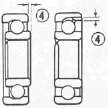
4 Bearing play
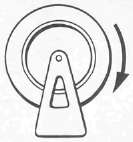
5. Check wheel balance.
Wheel is not statically balanced if it comes to rest at the same point after several light rotations.
Install appropriate balance weight at lightest point (on top).
NOTE:
Balance wheel with brake disc installed.
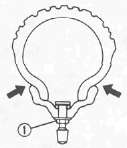
WARNING:
•After mounting a tire, ride conservatively to allow proper tire to rim seating. Failure to do so may cause an accident resulting in motorcycle damage and possible operator injury.
•After a tire repair or replacement, be sure to torque tighten the valve stem locknut 1 to specification.
Valve-Stem Locknut: 1.5 Nm (0.15 m-kg, 1.1 ft-lb)
WHEEL BEARING REPLACEMENT
1. Inspect wheel bearings
Wheel hub play/wheel turns roughly -> Replace.
Wheel bearing replacement steps:
• Clean wheel hub exterior.
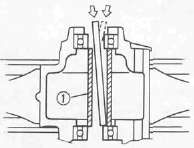
• Drive bearing out by pushing spacer aside and tapping around perimeter of bearing inner race. Use soft metal drift punch and hammer. The spacer 1 "floats" between bearings. Remove both bearings as described.
WARNING:
Eye protection is recommended when using striking tools.
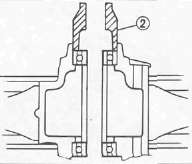
• To install the wheel bearing, reverse the above sequence. Use a socket or bearing press 2 that matches outside diameter of bearing outer race to drive in bearing.
CAUTION:
Do not strike the center race or balls of bearing. Contact should be made only with the outer race.
INSTALLATION
1. Install Front wheel. Reverse removal procedure.
Note the following installation points:
• Lightly grease the front wheel oil seal lips and the gear teeth of the speedometer drive and driven gears. (Use lightweight, lithium base grease.)
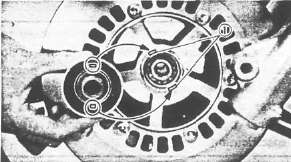
• Be sure that the two projections 1 inside the wheel hub mesh with the two slots in the speedometer clutch assembly.
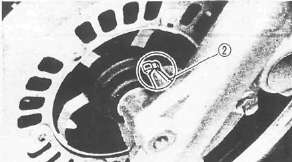
• Be sure that the projecing portion 2 (torque stopper) or the speedometer housing is positioned correctly.
• Compress the front forks serveral times to confirm proper fork operation before tightening the pinch bolt.
•Tighten the axle.
Axle: 105 Nm (10.5 m-kg, 75 ft-lb)
•Tighten the axle pinch bolt.
Axle Pinch Bolt: 20 Nm (2.0 m-kg, 14 ft-lb)
Rear Wheel and Brake
Rear Wheel and BrakeREAR WHEEL
1 Axle
2 Rear brake camshaft lever
3 Wear indicator
4 Brake plate
5 Tension bar
6 Rear brake camshaft
7 Bearing
8 Spacer flange
9 Spacer
10 Tire
11 Wheel
12 Clutch hub
13 O-ring
14 Bearing
15 Bearing
16 Damper
REMOVAL
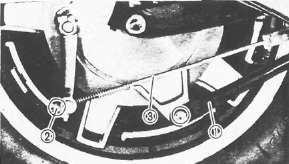
1. Place the motorcycle on its centerstand.
2. Remove:
• Cotter pin
• Axle nut
•Tension bar 1
• Brake rod adjuster 2
• Brake rod 3
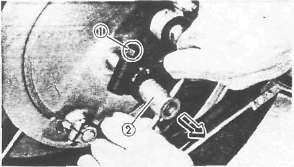
3. Loosen:
• Rear axle pinch bolt 1
4. Remove:
• Rear axle 2
• Rear wheel
Move the wheel towards the right side to separate it from final gear case.
INSPECTION
Brake Shoe
1. Measure the thickness of the brake shoes. Use slide calipers.
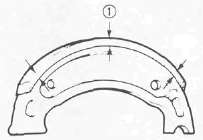
1 Measuring point
Brake Shoe Thickness: 4 mm (0.16 in)
Replacement Limit: 2 mm (0.08 in)
2. Inspect brake shoes. Sand glazed pads with coarse sandpaper.
Brake Drum
1. Inspect brake drum inner surface.
Wipe any oil off brake drum with rag soaked in lacquer thinner, brake parts cleaner or other solvent. Polish any scratches from brake drum lightly and evenly with emery cloth.
Brake Shoe Plate
1. Remove camshaft
2. Inspect cam face. Replace if worn. Grease camshaft before reassembly.
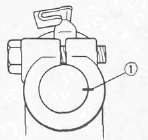
NOTE: .
Place alignment marks 1 on the cam lever and camshaft when assembly.
Rear Axle, Wheel and Wheel Bearing Replacement
Refer to "Front Wheel Inspection".
INSTALLATION
1. Install rear wheel -- Reverse removal steps.
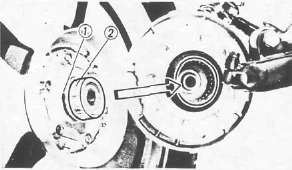
Rear wheel installation points:
• Lightly grease O-ring 1 and hub splines 2.
• Install wheel assembly and axle.
Axle Nut: 105 Nm (10.5 m-kg, 75 ft-lb)
Axle Pinch Bolt: 20 Nm (2.0 m-kg, 14 ft-lb)
Always use a new cotter pin on the axle nut.
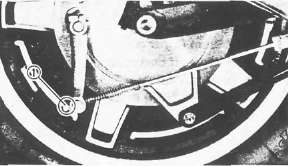
2. Adjust rear brake free play. Turn adjuster 1 as needed.
|
Adjuster |
Rear Brake Free Play |
|
Turn clockwise |
to reduce |
|
Turn counterclockwise |
to increase |
3. Adjust rear brake light switch
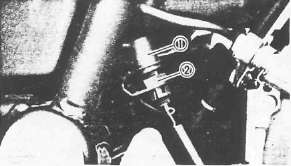
1 Switch body 2 Adjusting nut
Front Brake
Front BrakeFRONT BRAKE
1 Blead screw
2 Pad spring
3 Pad retaining pin
4 Caliper piston assembly (Replace as a set)
5 Caliper
6 Brake pads (Replace as a set)
7 Copper washer
8 Union bolt
9 Master cylinder kit {Replace as a set)
PAD SPRING
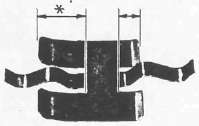
* Install the pad spring with its longer tangs facing upwards.
PAD THICKNES: Std.: 5.5 mm (0.22 in)
WEAR LIMIT: 0.5 mm (0.02 in)
BRAKE FLUID TYPE: DOT =3
CAUTION: Disc brake components rarely require disassembly. Do not:
• Disassemble components unless absolutely necessary.
• Use solvents on internal brake component.
• Use contaminated brake fluid for cleaning. Use only clean brake fluid.
• Allow brake fluid to come in contact with the eyes otherwise eye injury may occur.
• Allow brake fluid to contact painted surfaces or plastic parts otherwise damage may occur.
• Disconnect any hydraulic connection otherwise the entire system must be disassembled, drained, cleaned, and then properly filled and bled after reassembly.
BRAKE PAD REPLACEMENT
It is not necessary to disassemble brake caliper and brake hose to replace brake pads.
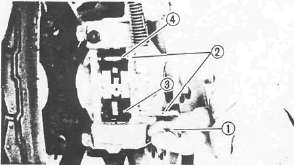
1. Remove:
• Cover
• Circlips 1
• Pad retaining pins 2
• Pad spring 3
• Pads 4
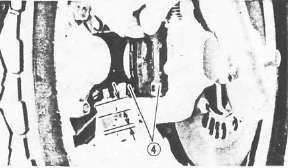
2. Install pads. Reverse removal steps.
NOTE:
• Install the pad spring with its longer tangs facing upwards.
• Replace pads as a set if either is found to be worn to the wear limit.
CALIPER DISASSEMBLY
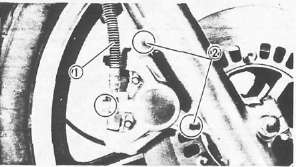
1. Remove:
• Brake hose 1
• Caliper securing bolts 2
• Brake pads
2. Remove caliper piston assembly. Use compressed air and proceed carefully.
Caliper piston removal steps:
• Using a rag, lock the right side piston.
• Blow compressed air into the hose joint opening to force out the left side piston from the caliper body.
• Remove the dust and piston seals and reinstall the piston.
• Repeat previous step to force out the right side piston from the caliper body.
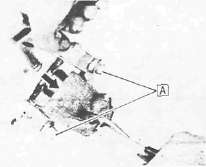
DO NOT LOOSEN "A"
• Cover piston with rag and use extreme caution when expelling piston from cylinder.
• Never attempt to pry out piston.
MASTER CYLINDER DISASSEMBLY
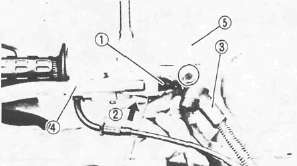
1. Remove:
• Brake light switch 1 Push 2 the brake light switch stopper.
• Brake hose 3
• Brake lever 4 and spring
• Master cylinder assembly 5
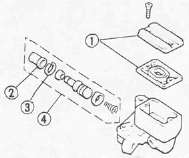
2. Remove:
• Cap 1 Drain remaining fluid.
• Master cylinder dust boot 2
• Circlip 3
• Master cylinder cup assembly
NOTE:
Be sure to reinstall the larger diameter lips of the cylinder cups first.
4 Master Cylinder Kit
INSPECTION AND REPAIR
|
Recommended Brake Component Replacement Schedule |
|
|
Brake pads |
As required |
|
Piston seal, dust seal |
Every 2 years |
|
Brake hoses |
Every 4 years |
|
Brake fluid |
Replace only when brakes disassembled |

1. Inspect the caliper piston assembly. Replace if there are scratches or other damage. Replace the brake pads as a set if worn below wear limits 1.
Brake Pad Wear Limit: 0.5 mm (0.02 in)
2 Wear indicator
2. Inspect master cylinder body and caliper body. Replace if scratched. Clean all passages with new brake fluid. Replace brake hoses if cracked, frayed, damaged or over 4 years old.
NOTE:
See Stainless Steel Brake Line Guide for dimensions.
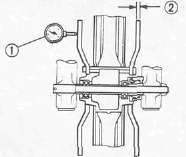
3. Measure:
• Deflection 1
• Thickness 2
Turn or replace rotors if out of specification.
Maximum Deflection: 0.15 mm (0.006 in)
Minimum Disc Thickness: 4.5 mm (0.177 in)
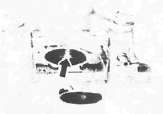
ASSEMBLY
Caliper
NOTE:
• All internal parts should be cleaned in new brake fluid only.
• Internal parts should be lubricated with brake fluid when installed.
• Replace the piston and dust seals whenever the caliper is disassembled.
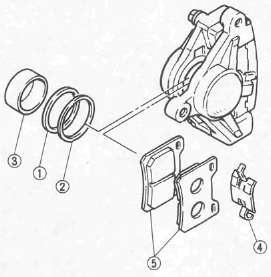
1. Install:
• Piston seal 1
• Dust seal 2
• Piston 3
• Pad spring 4
• Brake pads 5
• Caliper assembly
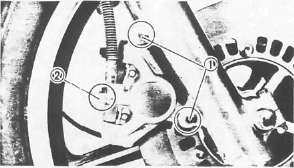
2. Tighten the caliper securing bolts 1 and brake hose union bolt 2
Caliper: 35 Nm (3.5 m-kg, 25ft-lb)
Brake Hose: 26 Nm (2.6 m-kg, 19 ft-lb)
3. Bleed the air completely.
Master Cylinder
1. Assemble the master cylinder
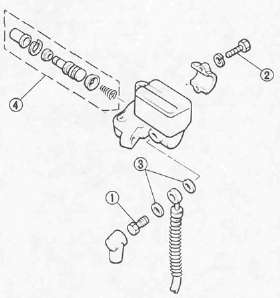
Union Bolt 1 : 26 Nm (2.6m-kg, 19 ft-lb)
Master Cylinder Holding Bolt 2 : 10Nm(1.0m-kg, 7.2ft-lb)
3 Copper washer 4 Master cylinder kit
2. Bleed the air completely.
AIR BLEEDING
Bleed the brake system if:
• The system has been disassembled.
• A brake hose has been loosened or removed.
• The brake fluid is very low.
• The brake operation is faulty.
WARNING:
A dangerous loss of braking performance may occur if the brake system is not properly bled.
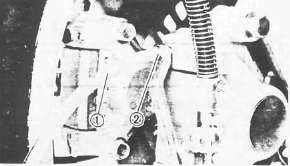
Air bleeding steps:
a. Add proper brake fluid to the reservoir.
b. Install diaphragm.
Be careful not to spill any fluid or allow the reservoir to overflow.
c. Connect the clear plastic tube 1 (4.5 mm, 3/16 in inside dia.) tightly to the caliper bleed screw 2.
d. Place the other end of the tube into a container.
e. Slowly apply the brake lever several times.
f. Pull the lever in. Hold the lever in position.
g. Loosen the bleed screw and allow the lever to travel towards its limit.
h. Tighten the bleed screw when the leverlimit has been reached; then release the lever.
i. Repeat steps e to h until all of the air bubbles have been removed from the system.
NOTE:
If bleeding is difficult, it may be necessary to let the brake fluid system stabilize for a few hours. Repeat the bleeding procedure when the tiny bubbles in system have disappeared.
HAP'S Stainless Steel BRAKE LINE GUIDE
HAP'S Stainless Steel BRAKE LINE GUIDEApplies to
1985/86 Yamaha XJ700X / XJ750X Maxim-X
1985/86 Yamaha XJ700 Maxim
----- 3-PART BRAKE LINE GUIDE ------
|
Upper Brake Line |
Quantity |
1 |
|
|
Length 1 |
43.0cm (16.9in) |
||
|
Upper Fitting 2 |
Type #3 - 10mm / 15° |
||
|
Lower Fitting 2 |
Type #1 - 10mm / straight |
||
|
Orientation 3 |
Type C - 90° Rotation |
||
|
Lower Brake Line |
Quantity |
2 |
|
|
Length 1 |
55.5cm (21.9in) |
||
|
Upper Fitting 2 |
Type #3 - 10mm / 15° |
||
|
Lower Fitting 2 |
Type #1 - 10mm / straight |
||
|
Orientation 3 |
Type C - 90° Rotation |
||
|
Additional Features |
Shielding 4 |
Chrome Coil Spring |
|
|
Mid-Line Mounts 5 |
Rubber Bushings (Lowers) |
||
|
Fitting Boot 6 |
At Master Cylinder Only |
1 Length is measured to the full limits of each brake line, including both fittings
2 Fitting types are according to Rennsport's Fitting Identification Guide
3 Brake line fitting relative orientations are according to Rennsport's Fitting Orientation Guide
4 Available on factory brake lines only
5 Bushings are removable for use on after-market brake lines
6 No longer available for replacement so don't lose or damage boot
Front Fork
Front ForkFRONT FORK
1 Cap bolt
2 O-ring
3 Spacer
4 Spring seat
5 Fork spring
6 Damper rod
7 Inner fork tube
8 Slide bushing
9 Taper spindle
10 Dust seal cover
11 Dust seal
12 Circlip
13 Fork seal
14 Washer
15 Guide bushing
16 Outer fork tube
17 Damper rod securing bolt
FORK OIL: Capacity (Each leg): 389 cm3 (13.7 Imp. oz, 13.2 US oz)
Type: YAMAHA FORK & SHOCK OIL 10Wt or equivalent fork oil
SPRING FREE LENGTH LIMIT: 505 mm (19.9 in)
AIR PRESSURE
Standard: 39.2 kPa (0.4 kq/cm\ 5.7 psi)
Maximum: 118 kPa (1.2 kg/cm2, 17 psi)
Minimum: Zero
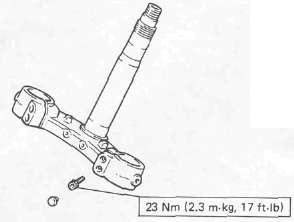
REMOVAL AND DISASSEMBLY
Support the motorcycle securely so there is no danger of it falling over.
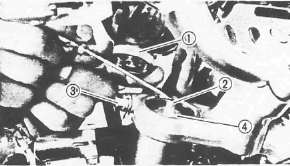
1. Remove the air valve cap 1
NOTE:
Keep the valve 2 open by pressing it for several seconds so that the air can be let out of the inner tube.
2. Loosen:
• Inner tube pinch bolt 3
• Cap bolt 4
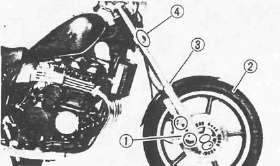
3. Remove:
• Brake caliper 1
• Front wheel 2
• Fork brace 3
4. Loosen:
• Lower front fork pinch bolts 4
CAUTION:
Support the fork before loosening the pinch bolts.
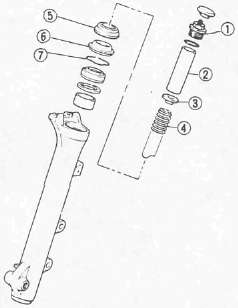
5. Remove:
• Front fork assembly (from the under bracket)
• Cap bolt 1
• Spacer 2
• Spring seat 3
• Fork spring 4
• Dust seal cover 5
• Dust seal 6
• Circlip 7
6. Fill the fork inner tube with fork oil. Stretch the inner tube before filling.
7. Install the Cap bolt 1
8. Remove oil seal from outer tube. Press the inner tube to facilitate removal.
CAUTION:
• If air enters the inner tube or it is compressed abruptly oil may spurt out or the coil seal may be ejected.
• Never touch the inner tube during a disassembly operation.
• Be sure to wrap the oil seal with a rag for safety.
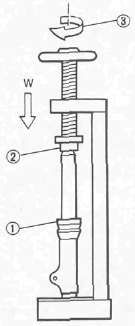
1 Wrap with rag
2 Socket wrench (suitable socket)
3 Turn slowly
9 Remove:
• Oil seal
• Washer
• Cap bolt
• Fork spring
10. Drain the oil from the fork.
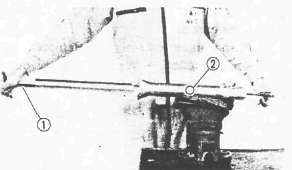
11. Remove the damper rod securing bolt. Use T-handle (90890-01326) 1 and Damper Rod Holder (90890-01365) 2 to remove the damper rod. The holder can be fabricated by securing double nuts requireing a 19mm socket to a bolt or length of threaded rod. These will fit into the 19mm hex in the base of the fork and can then be held with a socket and long extension.
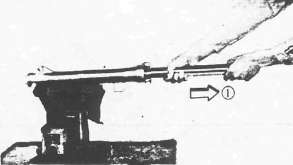
12. Remove:
• Damper rod
• Damper rod spring
• Inner fork tube
• Guide bushing (from outer tube)
• Slide bushing
• Taper spindle
1 Pull inner tube from outer tube.
INSPECTION
1. Inspect the inner fork tube. Replace if severe scratches, bends or a damaged oil lock valve are found.
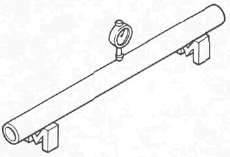
Do not attempt to straighten a bent fork tube as this may dangerously weaken the tube,
2. Inspect the outer fork tube. Replace if bent or if fork seal seat is damaged.
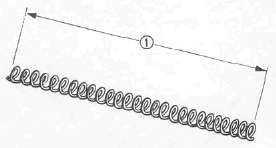
3. Measure the spring free length 1. Replace if less than limit.
Fork Spring Free Length Limit: 505 mm (19.9 in)
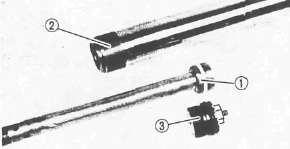
4. Inspect the damper rod. Replace seal and/or slide bushing if worn. Replace Cap bolt o-ring if damaged. Wash and blow out all passages.
ASSEMBLY
NOTE:
• Be sure all components are clean before assembly.
• Always install the new oil seal, bushings, and the dust seal. Do not reuse them.
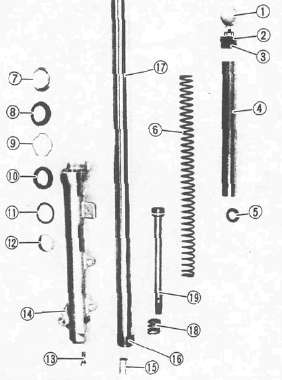
1 Cap
2 O-ring
3 Cap bolt
4 Spacer
5 Spring seat
6 Fork spring
7 Dust seal cover
8) Dust seal
9 Circlip
10 Fork oil seal
11 Washer
12 Guide bushing
13 Damper rod securing bolt
14 Outer fork tube
15 Taper spindle
16 Slide bushing
17 Inner fork tube
18 Damper rod spring
19 Damper rod
1. Install:
• Damper rod spring
• Damper rod. Allow rod to slide slowly down the inner fork tube until it protrudes from the bottom.
• Taper spindle
• Inner fork tube
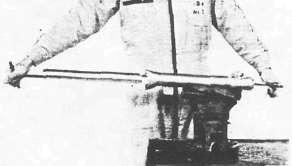
2. Install damper rod securing bolt. Hold damper rod with Damper Rod Holder (90890-01365) and T-handle (90890-01326).
Damper Rod Securing Bolt:
30 Nm (3.0 m-kg, 22 ft-lb) LOCTITE® Stud N'Bearing Mount (red)
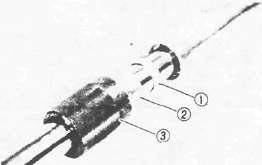
3. Install the guide bushing 1 Press guide bushing into the outer fork tube with Fork Seal Driver (90890-01367) 2 and Adapter (90890-01372)3. A substitute can be fabricated from 1 1/2" ABS drain pipe.
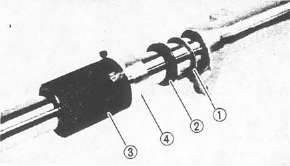
4. Install:
• Washer 1
• New fork oil seal 2. Press fork oil seal into the outer fork tube with Fork Seal Driver (90890-01367) 3 and Adapter (90890-01372) 4.
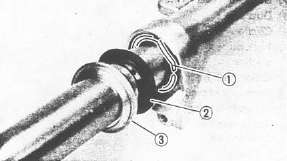
5. Install:
• Circlip1
• Dust seal 2
• Dust seal cover 3
6. Fill:
• Front fork with fork oil.
Capacity: 389 cm3 (13.7 Imp. oz, 13.2 US oz)
Type: Yamaha Fork & Shock Oil 10Wt or equivalent fork oil
WARNING:
Ensure each fork is filled with the same amount of oil or bike may develop a deadly wobble at speed.
7. Install:
• Fork spring
• Spring seat
• Spacer
• Cap bolt (into the inner fork)
8. Install the front fork assembly into the under bracket.
9. Tighten:
• Lower front fork pinch bolts.
• Cap bolt
Cap Bolt: 23Nm(2.3m-kg, 17ft-lb)
10. Loosen Lower front fork pinch bolts
11. Install front fork into the steering crown.
NOTE:
Be sure the inner fork tube end is flush with the top of the steering crown.
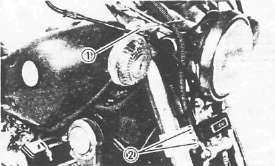
12. Tighten:
• Front fork pinch bolt (Upper) 1
• Front fork pinch bolts (Lower) 2
Upper Pinch Bolt: 20 Nm (2.0 m-kg, 14 ft-lb)
Lower Pinch Bolts: 23Nm(2.3m-kg, 17ft-lb)
13. Continue assembly by reversing of Removal and Disassembly sequence. Install and torque tighten each component as specified.
Disc Brake Caliper: 35 Nm (3.5 m-kg, 25 ft-lb)
Front Wheel Axle: 105 Nm (10.5 m-kg, 75 ft-lb)
Wheel Axle Pinch Bolt: 20Nm(2.0m-kg, 14 ft-lb)
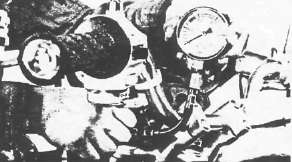
14. Fill front fork with air
Standard Air Pressure: 39.2 kPa (0.4 kg/cm2, 5.7 psi)
15. Install air valve cap
Steering Head
Steering HeadSTEERING HEAD
1 Handlebar bolt
2 Handlebar upper bracket
3 Steering crown
4 Special washer
5 Upper ring nut
6 Washer
7 Lower ring nut
8 Bear ing cover
9 Bearing
10 Fork brace
REMOVAL
1. Remove:
• Front wheel
• Front forks
2. Remove the headlight lens unit
3. Disconnect the wire connectors in the headlight shell.
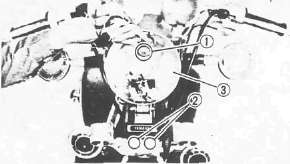
4. Remove:
• Headlight shell securing bolt 1
• Brake hose joint securing bolts 2
• Headlight shell 3
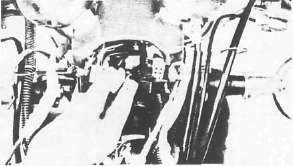
5. Disconnect the meter panel wiring connectors
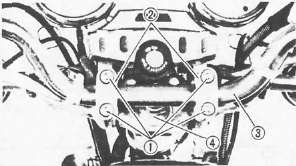
6. Remove:
• Covers
• Handlebar bolts 1
• Handlebar upper brackets 2
• Handlebar assembly 3
• Steering stem nut 4
• Steering crown and meter panel assembly
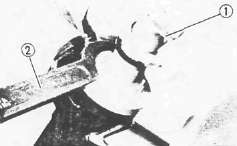
7. Remove the special washer 1
8. Loosen the upper and lower ring nuts. Use Steering Ring Nut Wrench (90890-01268) 2.
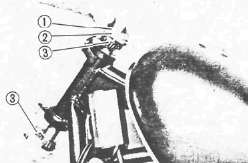
9. Remove:
• Upper ring nut
• Washer
• Lower ring nut 1
• Bearing cover 2
• Bearing 3
• Steering stem
INSPECTION
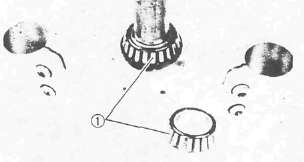
1. Check the bearings 1. Replace if pitted or otherwise damaged.
ASSEMBLY
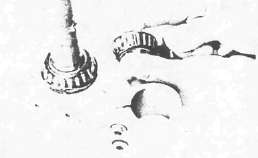
1. Lubricate the bearings with Wheel Bearing Grease.
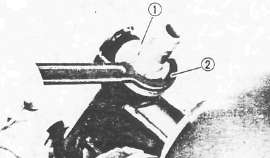
2. Install:
• Bearing (onto steering stem)
• Steering stem
• Bearing cover
• Lower ring nut 1
3. Tighten the lower ring nut 1. Use Steerinq Nut Wrench (90890-01268) 2.
Lower Ring Nut (Initial): 50 Nm (5.0 m-kg, 36 ft-lb)
4. Loosen the lower ring nut completely.
5. Retighten the ring nut to the final torque setting.
Lower Ring Nut (Final): 6Nm (0.6 m- kg, 4.3 ft- lb)
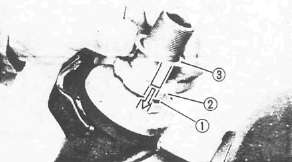
6. Install:
• Washer 1
• Upper ring nut 2
7. Finger tighten the upper ring nut 2
8. Install the special washer 3
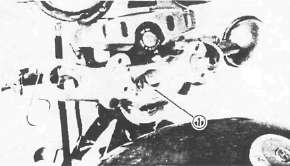
9. Install:
• Steering crown and meter panel assembly
• Steering stem nut 1
10. Check the steering head operation. Turn it from lock to lock. Grasp the fork lowers and push/pull. Readjust if there is any looseness or binding.
11. Position the front fork into steering crown. This will facilitate alignment of under-bracket holes with steering crown holes.
12. Tighten the steering stem nut
Steering Stem Nut: 110Nm (11 m- kg, 80 ft- lb)
13. Continue assembly by reversing removal sequence.
Fork Pinch Bolt (Upper): 20 Nm (2.0 m-kg, 14 ft-lb)
Fork Pinch Bolt (Lower):23 Nm (2.3 m-kg, 17 fft-lb)
Brake Hose Joint: 9 Nm (0.9 m-kg, 6.5 ft-lb)
Fork Brace: 9Nm (0.9 m-kg, 6.5 ft-lb)
Caliper: 35 Nm (3.5 m-kg, 25 ft-lb)
Axle: 105 Nm (10.5 m-kg, 75 ft-lb)
Axle Pinch 8olt: 20 Nm (2.0 m-kg, 14 ft-lb)
14. Check the steering head operation. Turn it from lock to lock. Readjust tightness of steering stem if it is loose or binding.
Swingarm and Rear Shock Absorber
Swingarm and Rear Shock AbsorberSWINGARM AND REAR SHOCK ABSORBER
1 Rear shock absorber
2 Swingarm
3 Bearing
4 Oil seal
5 Collar
6 Lock washer
7 Left pivot shaft
8 Pivot cover
9 Right pivot shaft
10 Nut
11 Rubber boot
12 Spring band
SWINGARM FREE PLAY INSPECTION

1. Remove:
• Rear wheel
• Rear shock absorbers 1

2. Check the swingarm side play 1. Grasp and move from side to side. Check and adjust bearing if there is any play. Rotate swingarm verticaly 2. Check and adjust bearings if there it is loose or binding. Replace if there are rough spots or other damage.
REMOVAL
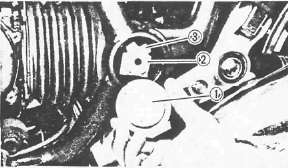
1. Remove:
• Rear wheel
• Rear shock absorbers
• Pivot covers 1
2. Flatten the lock washer tab on the left pivot shaft.
3. Remove:
• Left pivot shaft 2
• Lock washer 3

4. Remove:
• Right pivot shaft 1
• Locknut 2
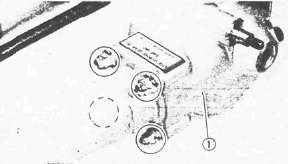
5. Remove:
• Swingarm assembly
• Final gear case assembly 1
INSPECTION AND LUBRICATION
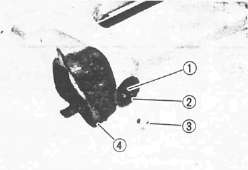
1. Inspect:
• Bearings 1
• Oil seals 2
• Collars 3
• Rubber boot 4
Replace any damaged components.
2. Lubricate the bearings and oil seal with Waterproof Wheel Bearing Grease
ASSEMBLY
1. Install:
• Swingarm assembly
• Lock washer
• Left pivot shaft
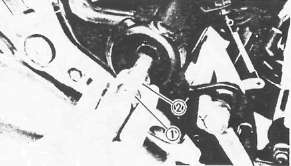
• Right pivot shaft 1
• Locknut 2
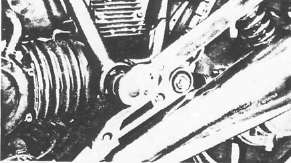
2. Tighten the left pivot shaft
Left Pivot Shaft: 100 Nm (10m-kg, 72ft-lb)
3. Bend lock washer tab.
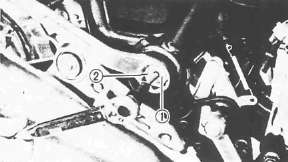
4. Tighten the right pivot shaft 1
Right Pivot Shaft: 5.5 Nm (0.55 m-kg, 4.0 ft-lb)
5. Tighten the right pivot shaft locknut 2
Right Pivot Shaft Nut: 100 Nm (10 m-kg, 72 ft-lb)
6. Install the pivot cover
7. Continue assembly by reversing of removal sequence.
Final Gear Case Securing Nut: 42 Nm (4.2 m-kg, 30 ft-lb)
Shaft and Rear Drive
Shaft and Rear DriveSHAFT DRIVE
Refer to "CHAPTER 3". for the middle gear.
The following special tools are not available but can be constructed for the final gear disassembly and assembly:
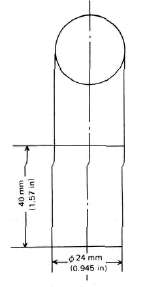
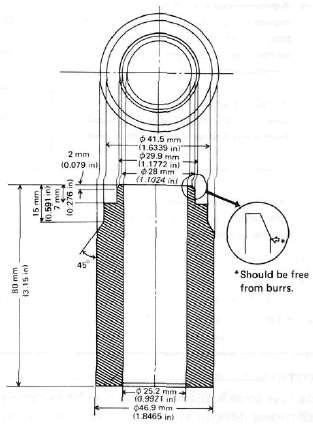
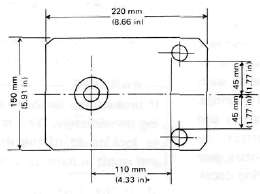
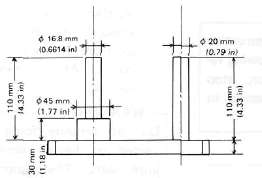
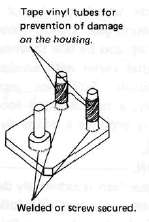
A. Troubleshooting
1. The following conditions may indicate damaged shaft drive components:
|
Symptoms |
Possible damaged areas |
|
1. A pronounced hesitation or "jerky" movement during acceleration, deceleration, or sustained speed. (This must not be confused with engine surging or transmission characteristics). 2. A "rolling rumble" noticeable at low speed; a high-pitched whine; a "clunk" from a shaft drive component or area. |
A. Damage to bearings. B. Improper gear lash. C. Gear tooth damage. D. Drive flange/universal joint bolts loose. |
|
3. A locked-up condition of the shaft drive mechanism; no power transmitted from engine to rear wheel. |
E. Broken drive-shaft. F. Disconnected flange/universal joint connection. G. Broken gear teeth. H. Seizure due to lack of lubrication. I. Small foreign object lodged between moving parts. |
Note:
Damage areas A, B, and C above may be extremely difficult to diagnose. The symptoms are quite subtle and difficult to distinguish from normal motorcycle operating noise. If there is reason to believe component(s) are damaged, remove component(s) for specific inspection.
2. Inspection Notes:
a. During coasting, accelerating or decelerating, the "rolling rumble" will increase with rear wheel speed, not engine or transmission gear speeds. However, such noise may also be due to wheel bearings.
b. Noise that varies with acceleration and deceleration: Following incorrect reassembly, a condition of too-little gear lash may produce a whine during deceleration.
CAUTION:
Too-little gear lash is extremely destructive to gear teeth. If a test ride following reassembly indicates this condition, stop riding immediately to minimize damage to gears.
c. A slight "thunk" must be distinguished from normal motorcycle operation. It will be most noticeable at low speed and could indicate broken gear teeth.
WARNING:
If broken gear teeth are suspected, stop riding immediately. This condition could lead to locking-up of the shaft drive assembly and result in harm to a rider.
d. If the drive flange/universal joint bolts are slightly loose, a "clunk" may be felt when slowly taking off, or when changing from slow acceleration to slow deceleration. At high speed this will result in vibration.
WARNING:
Do not continue riding a motorcycle suspected of having loose flange/universal joint bolts. The components may break, causing injury to a rider.
3. Troubleshooting Chart
Where Basic Conditions "a" and "b" above exist, consider the following Chart:
|
Elevate and spin front wheel. Feel for wheel bearing damage. |
Yes ► |
Replace wheel bearing. (See CHAPTER 5 "Front wheel") |
|
|
||
|
Check rear wheel. Feel for bearing damage. |
No ►
|
Rear wheel bearings and shaft drive bearings probably not damaged. Repeat test or remove individual components. |
|
|
||
|
Remove rear wheel. Check for wheel bearing damage. |
Yes ► |
Replace rear wheel bearing. (See "Rear Wheel" section in this chapter.) |
|
|
||
|
Remove drive shaft components. |
4. Oil Leak Inspection
If a shaft drive component is suspected of leaking oil, first thoroughly clean the entire motorcycle. The apparent location of an oil leak on a dusty motorcycle may be misleading. Dry the motorcycle and apply a leak-localizing compound or a dry-powder spray that will limit the flow of any leaking oil. Operate the motorcycle prepared in this way for the distance necessary to precisely locate the leak. There are the possibilities that a component housing may have been damaged by road debris or an accident, or a gasket or seal may be cracked or broken. However, on new or nearly new motorcycle an apparent oil leak may be the result of a rust-preventive coating or excess assembly lubrication of seals. Always clean the motorcycle and recheck the suspected location of any apparent leakage.
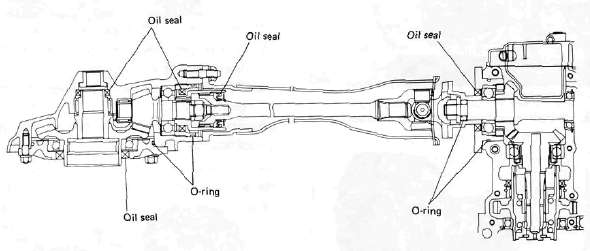
5. Checking Drained Oil
Whenever a problem is suspected in either the middle or final gear assemblies, drain and inspect the oil. Metal particles on the drain plug or in the oil could indicate a bearing seizure or other problem in the component. However, a small amount of metal particles in the oil is normal.
B. Final Gear Removal
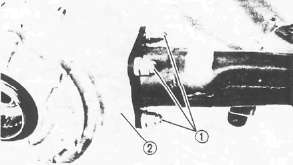
1. Remove:
• Rear axle
• Rear wheel (see "Rear Wheel" section in this chapter).
• Left shock absorber
• Nut 1
• Final gear assembly 2
2. Remove the 4 nuts holding the Final Drive unit to the swing arm.
3. Remove the final gear assembly.
C. Gear Lash Check and Adjustment
1. Secure the gear case in a vice or other support.
2. Remove one nut from the final gear case stud bolt. Install the gear holder (special tool) over the ring gear surface and stud bolt. Tighten the holder to stud bolt with a nut.
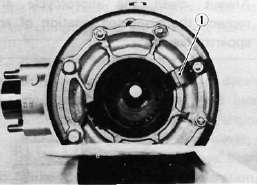
1. Final gear holding tool
3. Install the final gear lash measurement tool on the gear coupling.
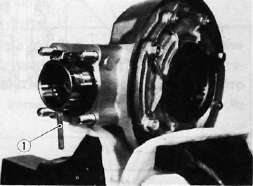
1. Gear lash measurement tool (Final gear)
4. Mount a dial gauge against the lash measurement tool at the scribed mark (60 mm, 2.36 in from the center of the shaft).
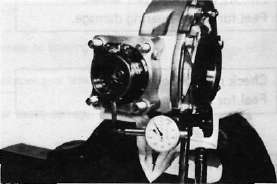
5. Use the special wrench to gently rotate the gear coupling back and forth. Note the lash measurement on the dial gauge.
Final gear lash:
When using the measurement tool: 0.25 - 0.50 mm (0.010-0.020 in) .
Actual gear lash on the final gear teeth: 0.1 ~ 0.2 mm (0.004 ~ 0.008 in).
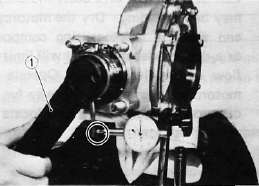
1. Middle and final gear holding tool
6. If the gear lash exceeds the specified limits, adjust as follows:
a. To reduce gear lash, increase the ring gear shim.
b. To increase gear lash, reduce ring gear shim.
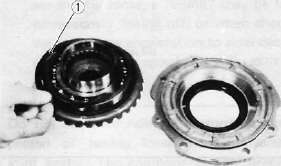
1. Ring gear shim
c. If it is necessary to increase the ring gear shim by more than 0.1 mm reduce the thrust washer thickness by 0.1 mm for each 0.1 mm of ring gear shim increase and if it is necessary to reduce shim by more than 0.1 mm, reverse above procedure.
D. Final Gear Disassembly
1. Remove the nuts and bolts holding the bearing housing.
2. Remove the ring gear assembly and thrust washer from the final gear case.
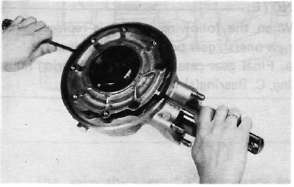
3. Remove the self-locking nut from drive pinion by using the holding tool (special tool) and remove the coupling.
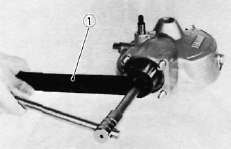
1. Middle and final gear holding tool
4. Remove the drive pinion bearing retainer with the retainer remover (special tool).
CAUTION:
The drive pinion bearing retainer nut is left hand threads. Turn the retainer nut clockwise to loosen.
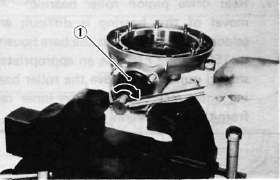
1. Drive pinion bearing retainer remover
5. Remove the drive pinion and bearing with the slide hammer and adapter (special tool).
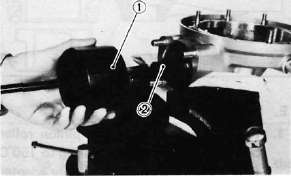
1. Slide hammer 2. Adapter
CAUTION:
This drive pinion removal should be performed only if gearing replacement is necessary. Do not re-use bearings or races after removal.
6. Remove the guide collar, oil seal, and roller bearing from the main housing by using the press tool No. 1 (special tool) and a press. Use an appropriate supports for the main housing during this operation. The roller bearing may be re-used if undamaged. Do not re-use oil seal.
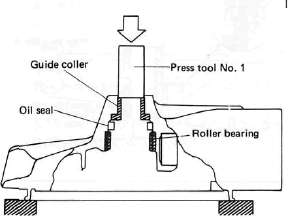
Rear drive pinion roller bearing; removal of this bearing is difficult and seldom necessary. Heat the bare housing to 150°C (302°F). Use an appropriately shaped punch to remove the roller bearing outer race. Remove the inner race from the drive pinion.
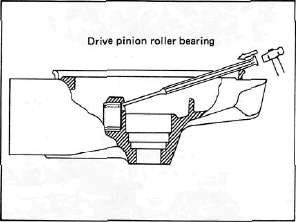
E. Final Gear Reassembly
1. Install the new rear drive pinion roller bearing. Heat the bare bearing to 150°C (302°F) and use an appropriately adapter to install the roller bearing outer race. Install the inner race onto the drive pinion.
2. Using the press tool No. 2 (special tool) and a press, install the guide collet, new oil seal, and roller bearing into the main housing in that order.
NOTE:
The removed roller bearing can be used if undamaged; however, we recommend replacement with a new one.
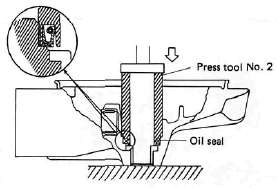
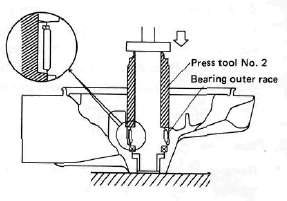
3. Final drive/ring gear positioning
NOTE:
When the following part(s) is replaced with new one(s), gear positioning is necessary: a. Final gear case, b. Ring gear bearing housing, C. Bearing(s)
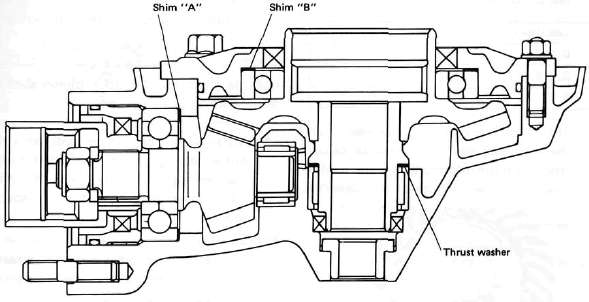
a. The shim thickness "A" necessary for the drive pinion gear positioning can be calculated from the information found on the final gear case and on the drive gear end.
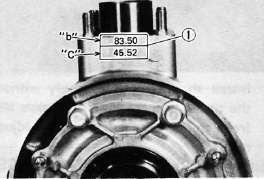
1. Size number
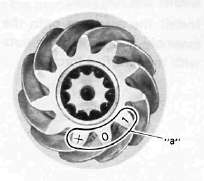
To fined shim thickness "A" use the
formula:
A = a -b
Where:
a = a numeral (usually a decimal number) on the gear near the tooth and either added to or detracted from the nominal size "84".
b = a numeral on the gear case appearing as a whole figure (ie. 83.50).
Example:
1) If the pinion gear is marked "+01"....."a" is 84.01.
2) If the gear case is marked "83.50".
A = 84.01 - 83.50 A = 0.51
Then the necessary shim thickness is 0.51mm.
Shim sizes are supplied in the following thicknesses:
0.15 mm, 0.30 mm, 0.40 mm, 0.50 mm, 0.60 mm.
Because the shims can only be selected in 0.05 mm increments the following chart should be used when encountering last digits that are not 5 or zero (0):
|
Last digits |
Rounding |
|
0,1,2 |
0 |
|
3, 4, 5, 6, 7 |
5 |
|
8,9 |
10 |
b. The shim thickness "B" necessary for the ring gear positioning can be calculated from the information found on the final gear case, ring gear, and bearing.
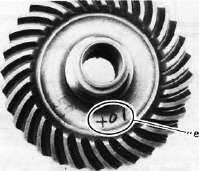
To find shim, thickness "B" use the
formula:
B = c + d-(e + f)
Where:
c= a numeral on the gear case appearing as a whole figure (ie. 45.52)
d = a numeral (usually a decimal number) on the outside of the ring gear bearing housing and added to the nominal size "3".
e= a numeral (usually a decimal number) on the inside of the ring gear and; either added to or detracted from the nominal size "35.40".
f = a bearing thickness (considered constant)
Distance "f" = 13.00 mm
Example:
1) If the gear case is marked "45.52".
2) If the ring gear bearing housing is marked "35"....."d" is 3.35.
3) If the ring gear is marked "+01" ..... "e" is 35.40 + 0.01 = 35.41.
4) "f" is 13.00.
B = c + d-(e + f)
B = 45.52 + 3.35 - (35.41 + 13.00)
B = 48.87- (48.41)
B = 0.46
Then the necessary shim thickness is
0.41 mm.
NOTE:
Use the chart for the drive pinion shim to select the ring gear shim size.
4. Install the drive pinion gear with the proper size of shim(s) and secure it with the bearing retainer nut with the drive pinion bearing retainer remover (special tool).
NOTE:
The bearing retainer nut is left hand threads; turn the nut to counterclockwise to tighten.
Tightening torque: 11 m-kg (80 ft-lb)
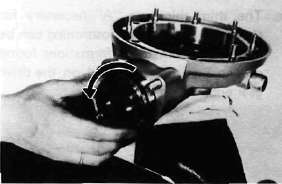
Install the ring gear assembly without the thrust washer. Adjust the gear lash (refer to "C. Gear lash check and adjustment).
Place four pieces of "PLASTIGAGE" between the originally fitted thrust washer and ring gear. Install the gear case onto the ring gear assembly and tighten the nuts and bolts with the specified torque.
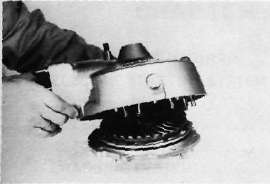
Tightening torque;
Bolt/Nut......... 2.3 m-kg
(16.6 ft-lb)
NOTE:
Do not turn the drive pinion/ring gear when measuring clearance with "PLASTIGAGE".
8. Remove the ring gear assembly and determine the clearance by measuring the width of the flattened "PLASTIGAGE".
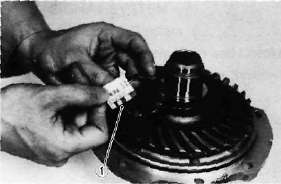
1. PLASTIGAGE
Ring gear thrust clearance. 0.1 ~ 0.2 mm
9. If the clearance exceeds the specification above, replace the thrust washer to obtain the proper clearance.
DRIVE SHAFT/JOINT
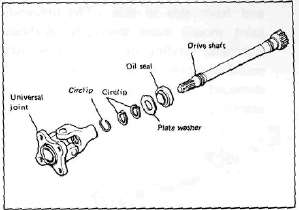
A. Removal
1. Remove the rear wheel. See "REAR WHEEL A. Removal" in this chapter.
2. Remove the final gear case assembly.
3. Remove the drive shaft. See "SWING ARM removal" in this chapter.
4. To remove the universal joint, it is necessary to remove the swing arm. Remove the universal joint assembly.
B, Inspection
1. Drive shaft
Inspect the shaft splines for wear and/or damage. If excessive, replace the drive shaft.
NOTE:
When installing the drive shaft, lubricate splines with molybdenum di-sulfide grease.

2. Universal joint
a. There should be no noticeable play in the universal joint bearings. If there is any play in the bearing, replace the universal joint assembly.
b. Move the universal joint up and down and from side to side. The universal joint should move smoothly. Without tightness, binding or rough spots that could indicate damaged bearings. If damaged, replace the universal joint assembly.
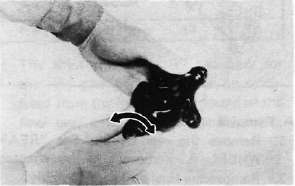
C. Reinstallation
When installing the drive shaft and the universal joint, reverse the removal procedure. Note the following points:
1. Lubricate the shaft splines with molybdenum di-sulfide grease.
2. Tighten the universal joint securing bolts and final gear case securing nuts with the specified torque:
Final gear case: 4.2 m-kg (30.4 ft-lb) Universal joint: 4.4 m-kg (31.8 ft-lb)
Cables and Maintenance
Cables and MaintenanceCABLE MAINTENANCE
NOTE:
See "Maintanance and Lubrication" intervals charts. Cable maintenance is primarily concerned with preventing deterioration and providing proper lubrication to allow the cable to move freely within its housing. Cable removal is straightforward and uncomplicated. Removal is not discussed within this section.
WARNING:
Cable routing is very important. For details of cable routing, see cable routing diagrams at end of this manual. Improperly routed or adjusted cables may make motorcycle operation unsafe.
1. Remove the cable
2. Inspect the cable for obstructed movement, kinking and/or frayed strands.Replace if damaged.
Cable Lubrication Steps:
• Hold the cable in a vertical position.
• Apply lubricant to the uppermost end of the cable.
• Leave in a vertical position until the lubricant appears at the bottom.
• Allow excess to drain, then reinstall the cable.
NOTE:
Choice of lubricant depends upon conditions and preferences; however, a semi-drying chain and cable lubricant will perform adequately under most conditions.
THROTTLE MAINTENANCE
1. Remove: the Phillips head screws from throttle housing assembly. Separate the housing halves.
2. Disconnect the cable from throttle grip assembly.
3. Remove the throttle grip assembly
4. Clean all parts with mild solvent.
5. Inspect:
• Contact surfaces
• Right-hand end of handlebar
Deburr or replace.
6. Lubricate all contact surfaces with a light coat of lithium-soap base grease and reassembly.
NOTE:
Tighten the housing screws evenly to maintain an even gap between housing halves.
Chapter 7, ELECTRICAL
Chapter 7, ELECTRICALXJ750XN CIRCUIT DIAGRAM
1 A.C. Generator
2 Rectifier/Regulator
3 Main switch
4 Fuse "FAN" (10A)
5 Thermo switch
6 Fan motor
7 Fuse "IGNITION" (10A)
8 "ENGINE STOP" switch
9 Pickup coil
10 T.C.I, unit
11 Ignition coil (#2, #3)
12 Ignition coil (#1, #4)
13 Sidestand relay
14 Sidestand switch
15 Tachometer
16 "FUEL" warning light
17 Fuel sender
18 Temperature meter
19 Thermo unit
20 Horn
21 "HORN" switch
22 Flasher relay (Relay assembly)
23 Flasher switch
24 Reed switch
25 Flasher light (Front, Right)
26 Flasher light (Rear, Right)
27 "TURN" indicator light (Right)
28 "TURN" indicator light (Left)
29 Flasher light (Rear, Left)
30 Flasher light (Front, Left)
31 "OIL LEVEL" indicator light
32 Oil level switch
33 "NEUTRAL" indicator light
34 Neutral switch
35 Fuse "SIGNAL" (15A)
36 Brake switch
37 Tail/Brake light
38 Clutch switch
39 Fuse "HEAD" (15A)
40 Meter light
41 Head light
42 "HIGH BEAM" indicator light
43 "LIGHTS" (Dimmer) switch
44 "START" switch
45 Starting circuit cut-off relay (Relay assembly)
46 Starter motor
47 Starter relay
48 Battery
49 Fuse "MAIN" (30A)
50 Diode assembly
COLOR CODE
|
0 |
Orange |
Lg |
Light green |
B/Y |
Black/Yellow |
|
R |
Red |
Y/G |
Yellow/Green |
L/W |
Blue/White |
|
L |
Blue |
Y/R |
Yellow/Red |
L/G |
Blue/Green |
|
Br |
Brown |
Y/B |
Yellow/Black |
L/R |
Blue/Red |
|
B |
Black |
Y/L |
Yellow/Blue |
L/B |
Blue/Black |
|
Y |
Yellow |
Br/W |
Brown/White |
G/L |
Green/Blue |
|
W |
White |
R/B |
Red/Black |
G/R |
Green/Red |
|
G |
Green |
R/L |
Red/Blue |
G/Y |
Green/Yellow |
|
P |
Pink |
R/W |
Red/White |
G/W |
Green/White |
|
Dg |
Dark green |
R/Y |
Red/Yellow |
W/R |
White/Red |
|
Ch |
Chocolate |
B/R |
Black/Red |
W/B |
White/Black |
|
Gy |
Gray |
B/W |
Black/White |
W/G |
White/Green |
|
Sb |
Sky blue |
|
|
|
|
Electrical Components
Electrical ComponentsELECTRICAL COMPONENTS 1
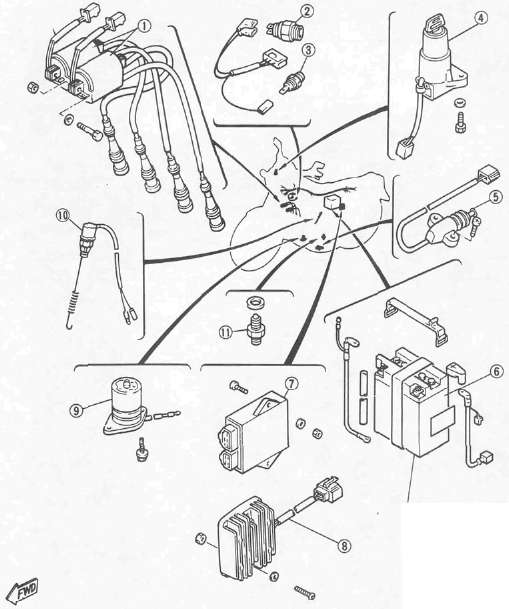
1 Ignition coil
2 Thermo switch
3 Thermo unit
4 Main switch
5 Sidestand switch
6 Battery
7 T.C.I, unit
8 Rectifier/Regulator
9 Oil level switch
10 Rear brake switch
11 Neutral switch
IGNITION COIL:
PRIMARY WINDING RESISTANCE: 2.7Ω ± 10%
SECONDARY WINDING RESISTANCE: 12kΩ±20%
BATTERY:
CAPACITY: 12V 14AH
SPECIFIC GRAVITY: 1.280
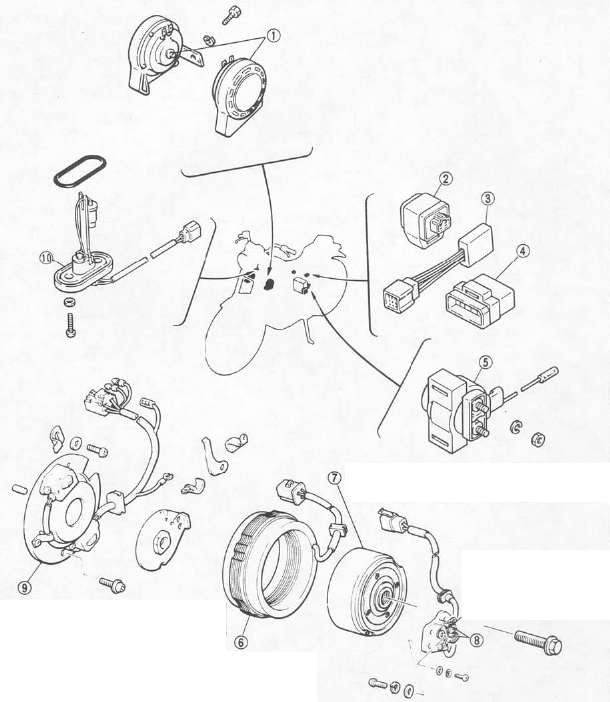
ELECTRICAL COMPONENTS 2
1 Horn
2 Sidestand relay
3 Diode assembly
4 Relay assembly {Flasher relay, Starting circuitcut-off relay)
5 Starter switch
6 Stator coil
7 Field coil (Rotor)
8 Brush
9 Pickup coil assembly
10 Fuel sender
PICKUP COIL RESISTANCE: 120Ω ± 10%(B-Gy, G-O)
STATOR COIL RESISTANCE: 0.46Ω ± 10% (W-W)
FIELD COIL RESISTANCE: 4.0Ω ± 10% (Direct)
MINIMUM BRUSH LENGTH: 10 mm (0.39 in)
Electric Starting System
Electric Starting SystemELECTRIC STARTING SYSTEM
3 Main switch
7 Fuse "IGNITION" (10A)
8 "ENGINE STOP" switch
14 Sidestand switch
39 Fuse "HEAD" (15A)
44 "START" switch
45 Starting circuit cut-off relay (Relay assembly)
46 Starter motor
47 Starter relay
48 Battery
49 Fuse "MAIN" (30A)
50 Diode assembly
STARTING CIRCUIT OPERATION
The starting circuit on this model consists of the starter motor, starter relay, starting circuit cutoff relay, and sidestand relay. If the engine stop switch and the main switch are both on, the starter motor can operate only if:
• The transmission is in neutral (the neutral switch is on.)
• The sidestand is up (the sidestand switch is on) and the clutch lever is pulled in (clutch switch is on.)
![]() When the transmission is in neutral.
When the transmission is in neutral.
 When the sidestand is up and the clutch lever is pulled in.
When the sidestand is up and the clutch lever is pulled in.
 When the engine is running.
When the engine is running.
1 Battery
2 Starter motor
3 Starter relay
4 Starting circuit cut-off relay
5 Starter switch
6 Neutral switch
7 Sidestand switch
8 Clutch switch
9 Sidestand relay
10 Tachometer
11 Main switch
12 Engine stop switch
13 To ignitor unit
|
Turn main switch to "ON" and engine stop switch to "RUN" |
|
|
Transmission is |
|
|
▼ |
▼ |
|
In neutral |
In gear |
|
▼ |
▼ |
|
Push starter switch Engine will start |
Raise Sidestand and Pull in clutch lever |
|
▼ |
▼ |
|
Ensure Sidestand is up |
Push starter switch: Engine will start |
|
▼ |
▼ |
|
Motorcycle can be ridden |
|
TROUBLESHOOTING CHART
THE STARTER MOTOR DOES NOT OPERATE. |
|
|
▼ |
| |
| ||
Connect "L/W" lead from the starter relay 1 to the battery negative (-) terminal 2 ; use a jumper lead. | ► | The engine does not rev smoothly. |
▼ | ||
Recharge or replace the battery. | ||
| ||
► | The engine does not operate. | |
▼ | ||
▼ |
| |
Check the battery voltage (12V) on the "L/W" lead from the starter relay. | ||
The engine operates. | ||
▼ | ||
▼ | ||
Main and engine stop switches are turned to "ON". | ||
If the starter relay does not click, check the starter relay and starter motor. | ||
| ▼ | ||
| ||
| ||
Connect "B/Y" lead to "ground" on the frame; use a jumper lead 1. | ||
► |
| |
If the relay unit does not click, check the battery voltage (12V) on the "R/W" lead. | ||
| ▼ | |
Check for an open or poor connection between the main switch and relay unit. | ||
▼ | ||
If the relay unit clicks, check the starter, sidestand, clutch and neutral switches. Replace switch(es) if necessary. |
|
|
STARTING CIRCUIT CUTOFF RELAY (Relay Assembly)
1. Remove:
• Seat
• Fuel tank
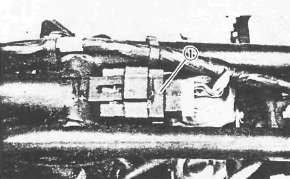
• Relay assembly 1
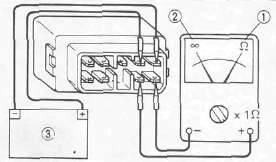
2. Check the relay contacts Use 12V battery 3 and Pocket Tester (90890-03112). Replace relayif out of specification.
Battery Connected: 0Ω 1 Battery Disconnected: ∞ 2
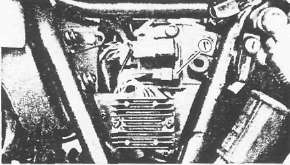
DIODE
1. Remove:
• Left side cover
• Diode 1
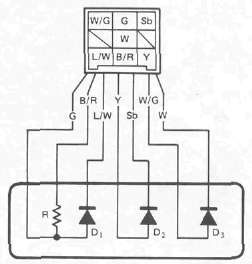
2. Check:
• Diode continuity/discontinuity
Defective element(s) -> Replace the unit.
|
Checking element |
Pocket tester connecting point |
Good |
|
|
(+) (red) |
(-) (black) |
||
|
D1 |
G |
L/W |
O |
|
L/W |
G |
X |
|
|
D2 |
Y |
Sb |
O |
|
Sb |
Y |
X |
|
|
D3 |
W/G |
W |
O |
|
W |
W/G |
X |
|
|
R |
G |
B/R |
8.2Ω |
O: Continuity (0Ω) (Scale Ω x 1k)
x : Discontinuity (∞) (Scale Ω x 1)
NOTE:
The results "o" or "x" should be reversed according to the pocket tester polarity.
NEUTRAL SWITCH
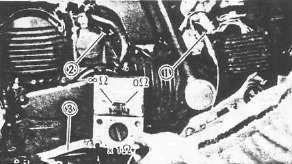
1. Remove:
• Left side cover
• Panel
2. Check the neutral switch contact. Replace if out of specification.
|
Shift pedal 3 |
In neutral |
In gear |
|
Tester |
0Ω |
∞Ω |
1 Blue lead
2 Ground
SIDESTAND SWITCH
1. Refer to neutral switch removal steps.
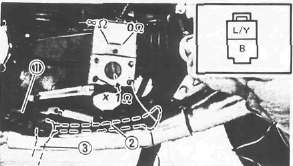
2. Check the sidestand switch 1 contact. Replace switch if out of specification.
|
Sidestand |
Up 2 |
Down 3 |
|
Tester |
0Ω |
∞Ω |
CLUTCH SWITCH
1. Remove headlight unit
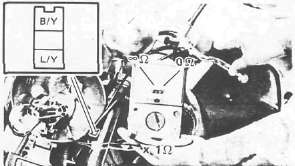
2. Check clutch switch contact. replace if out of specification.
|
Clutch lever |
Pull in |
Not pull in |
|
Tester |
0Ω |
∞Ω |
STARTER SWITCH
1. Remove the headlight unit.
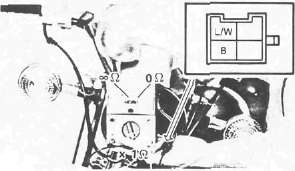
2. Check starter switch contact. Replace if out of specification.
|
Starter switch |
ON |
OFF |
|
Tester |
0Ω |
∞Ω |
STARTER RELAY Inspection
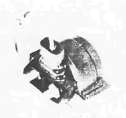
Preparation steps:
• Disconnect starter motor red lead.
• Connect Pocket Tester leads to relay terminals.
•Turn main switch to "ON".
• Turn engine stop switch to "RUN".
• Move shift pedal to "NEUTRAL"
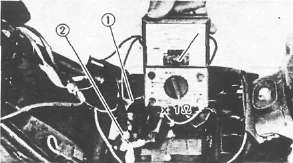
|
Push starter switch to "ON" |
||
|
▼ |
▼ |
|
|
Relay clicks and tester reads 0Ω |
Relay does not click and tester does not read 0 Ω |
|
|
▼ |
▼ |
|
|
OK |
Measure resistance: |
|
|
|
||
|
▼ |
▼ | |
|
Resistance less than 1 Ω |
Resistance more than 1 Ω | |
|
▼ |
▼ | |
|
Check connections |
Replace relay | |
Starter Motor
Starter MotorSTARTER MOTOR
1 O-ring
2 Brush
3 Armature
4 Washer
5 Circlip
Removal
Refer Chapter 3. "ENGINE DISASSEMBLY".
Inspection
1. Inspect commutator outer surface. Clean with 600 grit sandpaper if dirty. Check mica insulation between commutator segments and scrape mica to proper limits. Use a hacksaw blade that is ground to fit.
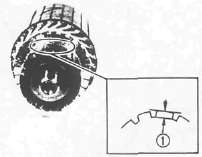
Mica Undercut 1 : 0.4 - 0.8 mm (0.02 - 0.03 in)
NOTE:
The mica insulation of commutator must be under-cut to ensure proper operation of commutator.
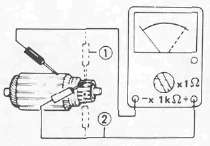
2. Measure the armature coil continuity 1. Replace or rewind starter motorif necessary.
Armature Coil: 0.014Ω ± 6% at 20°C (68° F)
Measure the armature coil insulation 2. Replace the starter motor if shorted.
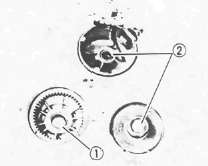
3. Inspect:
• Front cover bearing 1
• Center and rear covers bushings 2
Replace if damaged.
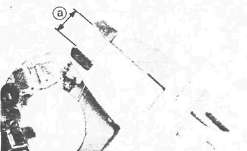
4. Measure the length of each brush length a and replace if less than minimum length.
Minimum Brush Length: 8.5 mm (0.34 in)
5. Check the brush spring pressure and compare with new spring. Replace spring if weak.
Charging System
Charging SystemCHARGING SYSTEM
1 A.C. Generator
2 Rectifier/Regulator
3 Main switch
48 Battery
49 Fuse "MAIN" (30A)
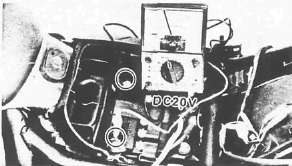
CHARGING VOLTAGE INSPECTION
1. Remove seat
2. Connect Pocket Tester leads (to each battery terminal)
3. Start the engine.
4. Measure the charging voltage. Rev engine to approximately 3,000 r/min or more.
Charging Voltage: 14.2 ~ 14.8 V
TROUBLESHOOTING
| Check voltage. | ◄ ◄ ◄ ◄ | ◄ | |
| Not within specification ▼ | ▲ | ||
|
Inspect all connections |
Defective ► | Correct.► | ▲ |
| OK ▼ | |||
| Measure the battery for voltage and specific gravity. Battery voltage: More than 12V Specific gravity: 1.280 |
Less than specification: ► | Recharge the battery. | |
|
OK ▼ |
|||
|
Remove the generator assembly and check the brush length, rectifier, and coil resistance. Minimum brush length: 10 mm (0.39 in) |
Less than specification: ► | Replace the defective part(s). | |
|
OK ▼ |
|||
| Replace rectifier/regulator. | |||
BATTERY
NOTE:
Replace the battery if:
•Battery voltage will not rise to a specific value or bubbles fail to rise even after many hours of charging.
•Sulfation of one or more cells occurs, as indicated by the plates turning white, or an accumulation of material exists in the bottom of the cell.
•Specific gravity readings after a long, slow charge indicate one cell to be lower than the rest.
•Warpage or buckling of plates or insulators is evident.
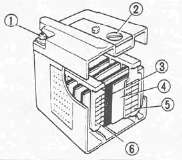
1 Terminal
2 Cap
3 Insulator
4 Separation plate
5 Negative electrode
6 Positive electrode
1. Inspect the battery terminals and battery couplers. Clean off any corrosion. Tighten as required.
2. Measure the specific gravity of battery fluid. Remove and recharge battery if less than 1.280
CAUTION:
To insure maximum battery performance be sure to:
• Charge a new battery before use.
• Maintain proper electrolyte level.
• Charge at proper current; 1.4 amps/10 hrs. or until the specific gravity reaches 1.280 at 20°C(68°F).
Failure to observe these points will result in a shortened battery life.
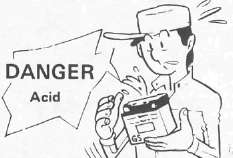
WARNING:
Battery electrolyte is dangerous; it contains sulfuric acid and therefore is poisonous and highly caustic.
Always follow these preventive measures:
•Avoid bodily contact with electrolyte as it can cause severe burns or permanent eye injury.
•Wear protective eye gear when handling or working near batteries. Antidote (EXTERNAL):
•SKIN - Flush with water.
•EYES — Flush with water for 15 minutes and get immediate medical attention. • Drink large quantities of water or milk and follow with milk of magnesia, beaten egg, or vegetable oil. Get immediate medical attention.
Batteries also generate explosive hydrogen gas, therefore you should always follow these preventive measures:
• Charge batteries in a well-ventilated area.
• Keep batteries away from fire, sparks, or open flames (e.g., welding equipment, lighted cigarettes, etc.)
• DO NOT SMOKE when charging or handling batteries. KEEP BATTERIES AND ELECTROLYTE OUT OF REACH OF CHILDREN.
Battery Service Life
The service life of a battery is usually two to three years. Battery life may be shortened by poor maintenance.
Preparation steps:
• Keep battery topped off with distilled water.
• Keep battery charged.
• Do not overcharge battery.
• Do not allow battery to freeze.
• Do not fill with tap water or sulfuric acid containing impurities.
• Do not charge new battery using improper voltage or current.
Battery Storage
The battery should be stored if the motorcycles is not to be used for a long period.
1. Remove the battery.
Battery storage and maintenance tips:
• Recharge the battery periodically.
• Store the battery in a cool, dry place.
• Recharge the battery before reinstalling.
|
Battery |
YB14L |
|
Electrolyte |
Specific gravity: 1.280 |
|
Initial charging rate |
1.4 amp for 10 hours (new battery) |
|
Recharging rate |
10 hours (or until specific gravity reaches 1.280) |
|
Refill fluid |
Distilled water (to maximum level line) |
|
Refill period |
Check once per month (or more often as required) |
1 Field coil
2 Stator
3 Brush
GENERATOR ASSEMBLY
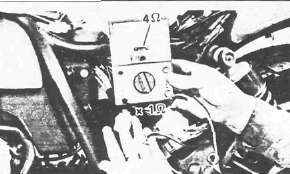
1. Remove:
• Left side cover
• Panel
2. Measure the stator coil resistance
Stator Coil Resistance: 0.46Ω ± 10% at 20°C (68°F) (W-W)

3. Remove the A.C.G. cover
4. Measure the field coil resistance
Field Coil Resistance: 4.0Ω ±10% at 20°C (68°F)
5. Inspect the brush contact areas. Clean with 600 grit sandpaper if dirty.
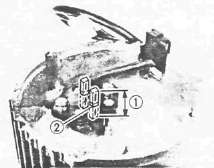
6. Measure each brush length 1. Replace if shorter than minimum.
Minimum Brush Length: 10 mm (0.39 in)
2 Wear indicator
7. Inspect the brush springs Compare with new spring.
RECTIFIER/REGULATOR
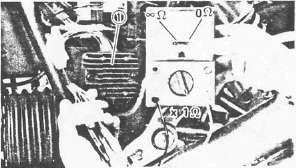
1. Remove:
• Left side cover
• Panel
2. Check Rectifier/Regulator 1 diodes (Refer to the following table.)
Defective element — Replace rectifier.
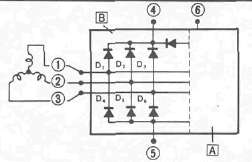
1 White
2 White
3 White
4 Red
5 Ground
6 Brown
A Regulator
B Rectifier
|
Checking |
Pocket tester |
Good |
|
|
(+) |
(-) |
||
|
D1 |
4 |
1 |
O |
|
1 |
4 |
X |
|
|
D2 |
4 |
2 |
O |
|
2 |
4 |
X |
|
|
D3 |
4 |
3 |
O |
|
3 |
4 |
X |
|
|
D4 |
1 |
5 |
O |
|
5 |
1 |
X |
|
|
D5 |
2 |
5 |
O |
|
5 |
2 |
x |
|
|
D6 |
3 |
5 |
O |
|
5 |
3 |
x |
|
O: Continuity X: Discontinuity (∞ )
CAUTION:
Do not overcharge rectifier or damage may result.
Avoid:
• A short circuit
• Inverting + and - battery leads
• Direct connection of rectifier to battery
NOTE:
The results "O" or "x" should be reversed according to the pocket tester polarity.
Ignition System
Ignition SystemIGNITION SYSTEM
3 Main switch
7 Fuse "IGNITION" (10A)
8 "ENGINE STOP" switch
9 Pickup coil
10 T.C.I, unit
11 Ignition coil (#2, #3)
12 Ignition coil (#1, #4)
13 Sidestand relay
48 Battery
49 Fuse "MAIN" (30A)
DESCRIPTION
This model is equipped with a battery operated, fully transistorized, breakerless ignition system. By using magnetic pickup coils, the need for contact breaker points is eliminated. This adds to the dependability of the system by eliminating frequent cleaning and adjustment of points and ignition timing. The TCI (Transistor Control Ignition) unit incorporates an automatic advance circuit controlled by signals generated by the pickup coil. This adds to the dependability of the system by eliminating the mechanical advancer. This TCI system consists of two units; a pickup unit and an ignitor unit.
OPERATION
The TCI functions on the same principle as a conventional DC ignition system with the exception of using magnetic pickup coils and a transistor control box (TCI) in place of contact breaker points.
Pickup Unit
The pickup unit consists of two pickup coils and a flywheel mounted onto the crankshaft. When the projection on the flywheel passes a pickup coil, a signal is generated and transmitted to the ignitor unit. The width of the projection on the flywheel determines the ignition advance.
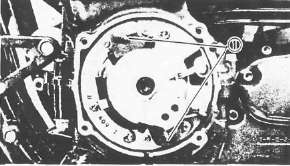
1 Pickup coils
Ignitor Unit
This unit controls wave form, duty control, switching, electronic ignition advance, etc. The duty control circuit reduces electrical consumption by controlling the duration of the primary ignition current.
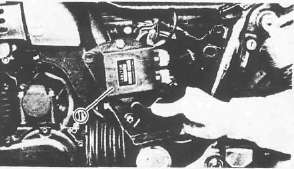
The ignitor unit 1 also has a protective circuit for the ignition coil. If the ignition switch is on and the crankshaft is not turning, the protective circuit interrupts the current flow to the primary coil after a few seconds. When the crankshaft is turning, however, the ignitor unit sends current to the primary coil.
1. Remove:
• Seat
• Left side cover
• Panel
• Ignitor unit 1
TROUBLESHOOTING
1. Start engine and warm-up a while, then turn it off.
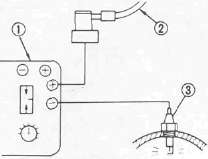
2. Connect Electro Tester (90890-03021) 1
2 Spark plug wire
3 Spark plug
3. Start engine and increase spark gap until misfire occurs (Test at various rpm between idle and red line.)
CAUTION:
Do not run the engine in neutral above 6,000 rpm for more than 1 or 2 seconds.
Minimum Spark Gap: 6 mm (0.24 in)
4. If ignition system becomes inoperative or engine misfires see the troubleshooting chart below:
Troubleshooting Chart
|
Check entire ignition connections. |
Poor connection ► |
Correct.
|
|
▼ OK |
||
|
Check battery voltage and specific gravity. |
Low voltage/specific gravity ► |
Recharge battery.
|
|
▼ OK |
||
|
Check fuse and fuse connections. |
Weak connection or open circuit ► |
Correct connection or replace fuse.
|
|
▼ OK |
||
Check ignition coil resistance (primary and secondary).Primary: 2.7Ω ± 10%at20°C (68°F) Secondary: 12 kΩ ± 20% at 20°C (68° F) |
If other than specified ► |
Replace ignition coil.
|
|
▼ OK |
If other than specified ► |
Replace pickup coil assembly.
|
|
Check pickup coil resistance. Pickup coil: 120Ω ± 10% at 20°C (68°F) |
||
|
▼ OK |
||
|
Check operation of sidestand switch and relay. |
Faulty ► |
Check sidestand relay sidestand switch, diode and neutral switch.
|
|
▼ OK |
||
|
TCI unit is faulty, replace unit. |
IGNITION COIL
1. Remove the fuel tank
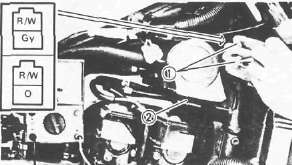
2. Disconnect the ignition coil leads 1
2 No. 2 and No. 3 cylinder ignition coil
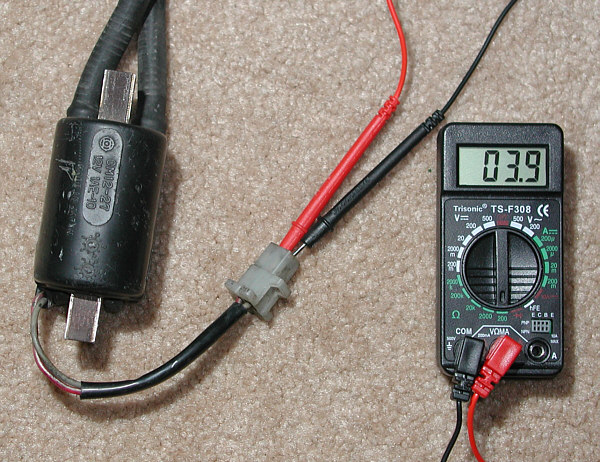
3. Measure the primary coil resistance
Primary Coil Resistance:
O to R/W lead connector
Gy to R/W lead connector
2.7Ω ± 10% at 20°C (68°F)
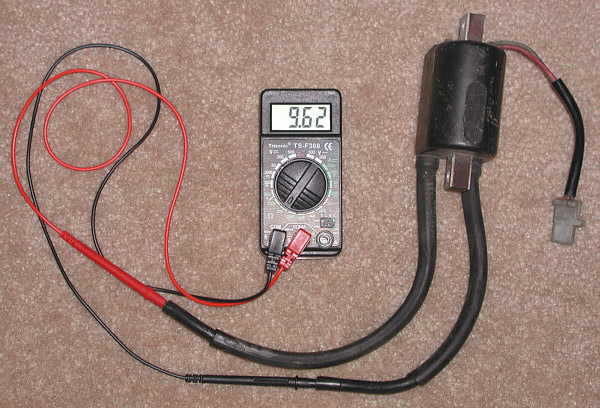
4. Measure secondary coil resistance
Secondary Coil Resistance:
12kΩ ±20% at 20°C (68°F)
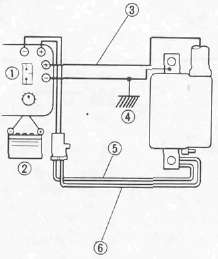
5. Connect:
Electro tester 1
Fully charged battery 2 (to ignition oil leads)
3 No. 1 (Rear) cylinder high tension cord
4 Ground
5 R/W lead
6 O lead
6. Measure the ignition coil minimum spark gap Turn the spark gap adjuster and increase the gap to the maximum limit unless misfire occurs first.
Minimum Spark Gap: 6 mm (0.24 in)
PICKUP COIL
1. Remove:
• Left side cover
• Panel
2. Disconnect pickup coil wires from TCI unit wires.
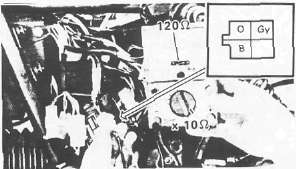
3. Measure the pickup coil resistance. Use pocket tester.
Pickup Coil Resistance:
No. 1 and No. 4 cylinder (O — B)
No, 2 and No. 3 cylinder (Gy - B)
120Ω ± 10% at 20°C (68°F)
SIDESTAND RELAY
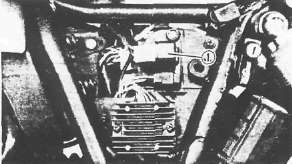
1. Remove:
• Left side cover
•Sidestand relay 1
2. Check the relay contacts
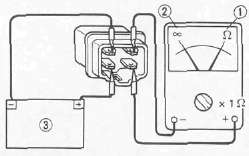
Use 12V battery 3 and Pocket Tester (90890-03112).
Battery Connected: ∞ 2
Battery Disconnected: 0Ω 1
SPARK PLUG
1. Check condition and replace if burned or fouled. Clean and regap as necessary.
CAUTION:
Be sure to use plugs of proper type
D8EA (NGK) X24ES-U (NIPPONDENSO)

Electrode Gap 1 :
0.6 ~ 0.7 mm (0.024 - 0.028 in)
2. Install spark plug
Spark Plug: 17.5 Nm (1.75m*kg, 12.5ft-lb)
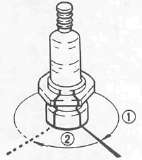
1 Finger tighten
2 Plug wrench tighten
Lighting System
Lighting SystemLIGHTING SYSTEM
3 Main switch
25 Flasher light (Front, Right)
26 Flasher light (Rear, Right)
27 "TURN" indicator light (Right)
28 "TURN" indicator light (Left)
29 Flasher light (Rear, Left)
30 Flasher light (Front, Left)
37 Tail/Brake light
39 Fuse "HEAD" (15A)
40 Meter light
41 Head light
42 "HIGH BEAM" indicator light
43 "LIGHTS" (Dimmer) switch
44 "START" switch
48 Battery
49 Fuse "MAIN" (30A)
TESTS AND CHECKS Headlight Troubleshooting
|
HEADLIGHT DOES NOT COME ON WHEN ENGINE IS RUNNING/HIGH BEAM DOES NOT OPERATION. |
|
▼ |
|
Check headlight. |
Faulty ►
|
Replace.
|
▼ |
Check head fuse. |
Faulty ►
|
Replace.
|
▼ |
Measure voltage on brown wire from main switch ("ON" position). |
Faulty
|
Check dimmer switch, replace if necessary.
|
▼ |
Measure voltage on blue/black wire from starter switch ("ON" position). |
No voltage
|
Check main switch, replace if necessary.
|
▼ |
No voltage
|
Check starter switch, if necessary.
|
Measure voltage at dimmer switch terminal. |
▼ |
An open or poor connection between headlight and dimmer switch terminal. |
Measure voltage at headlight high beam or low beam terminal. |
No voltage |
▼ |
|
|
Poor ground or poor connection of headlight wiring. |
Taillight Troubleshooting
|
TAILLIGHT DOES NOT COME ON WHEN ENGINE IS RUNNING. |
|
|
▼ |
|
Check taillight bulb. |
Faulty |
Replace. |
▼ OK |
|
|
Measure voltage on blue wire from main switch ("ON" position). |
No voltage |
Check main switch, replace if necessary. |
▼ 12v |
|
|
Measure voltage at taillight terminal. |
No voltage. |
An open or poor connection between taillight and main switch terminal. |
▼ 12v |
Poor ground or poor connection or taillight wiring. |
|
|
Signal System
Signal SystemSIGNAL SYSTEM
3 Main switch
15 Tachometer
16 "FUEL" warning light
17 Fuel sender
20 Horn
21 "HORN" switch
22 Flasher relay (Relay assembly)
23 Flasher switch
24 Reed switch
25 Flasher light (Front, Right)
26 Flasher light (Rear, Right)
27 "TURN" indicator light (Right)
28 "TURN" indicator light (Left)
29 Flasher light (Rear, Left)
30 Flasher light (Front, Left)
31 "OIL LEVEL" indicator light
32 Oil level switch
33 "NEUTRAL" indicator light
34 Neutral switch
35 Fuse "SIGNAL" (15A)
36 Brake switch
37 Tail/Brake light
44 "START" switch
48 Battery
49 Fuse "MAIN" (30A)
50 Diode assembly
FLASHER LIGHT Troubleshooting
|
Flasher light and indicator light inoperative. |
||
| ▼ | ||
|
Check bulb. |
Faulty ► |
Replace.
|
|
▼OK |
||
|
Measure voltage at flasher switch (Br/W wire and Y/R wire). |
12V |
Check flasher switch, replace if necessary.
|
|
▼ No voltage |
||
|
Check flasher relay, main fuse, signal fuse and battery. |
Faulty and/or battery discharged . ► |
Replace faulty parts and/or charge battery.
|
|
▼ OK |
||
|
Check reed switch. |
Defect ► |
Replace.
|
|
▼ OK |
||
|
Replace flasher relay (Relay assembly). |
||
FLASHER RELAY (Relay Assembly)
NOTE
Flasher relay and self cancelling unit are included with relay assembly.
The flasher relay turns off the flashers. Generally the signal will cancel after either 10 seconds of operation or after the motorcycle has traveled 150 meters (490 feet), whichever is greater. At low speed, the cancelling is a function of distance; at high speeds, it's a function of both time and distance.
The flasher switch has three positions: L (left), OFF, and R (right). The switch lever will return to the "OFF" position after being pushed to L or R, but the signal will function. By pushing the lever in, the signal may be cancelled manually.
REED SWITCH
1. Remove:
• Headlight unit
• Headlight body
2. Disconnect the coupler
3. Connect pocket tester
4. Lift the front wheel and rotate the wheel by hand.
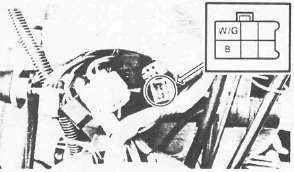
5. Measure reed switch resistance
Reed Switch Resistance: About 7 Then return back OΩ or ∞Ω when wheel is stopped
OIL LEVEL INDICATOR LIGHT
1. Troubleshooting
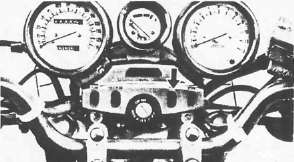
|
Oil level indicator light inoperative |
|||
|
Check bulb |
Faulty |
Replace |
|
|
▼ OK |
|
|
|
|
Measure voltage at oil level switch (Red/Black) |
No voltage |
Check diode, signal fuse, main switch, main fuse, and battery. Replace faulty parts. |
|
|
▼ 12V |
|
|
|
|
Check oil level switch, replace if necessary. |
|
||
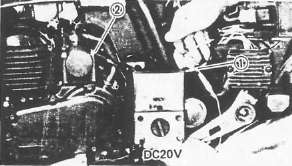
1 Red/Black lead
2 Ground
FUEL WARNING INDICATOR LIGHT
1. Troubleshooting
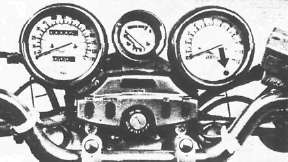
|
Fuel warning indicator light inoperative |
|||
|
▼ |
|
||
|
Check bulb |
Faulty |
Replace |
|
|
▼ OK |
|
|
|
|
Measure voltage at fuel sender unit (Green). |
No voltage |
Check signal fuse, main switch, main fuse, and battery. Replace faulty parts. |
|
|
▼ 12V |
|
||
|
|
|||
|
Check fuel sender, replace if necessary. |
|
||
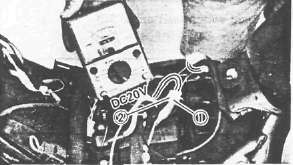
1 Green
2 Black
FUEL SENDER UNIT
1. Remove seat
2. Fill the fuel tank (with gasoline)
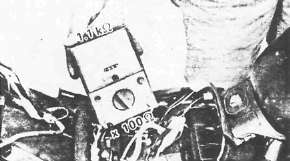
3. Measure the fuel sender unit resistance.
Fuel Sender Unit Resistance: 1.1 ±0.2kΩ @ 20°C (68°F)
NEUTRAL INDICATOR LIGHT
1. Troubleshooting
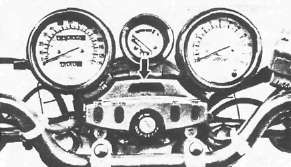
|
Neutral indicator light inoperative |
||
|
|
||
|
Check bulb |
Faulty |
Replace
|
|
▼ OK |
||
|
Measure voltage at neutral switch (Sb wire) |
No voltage |
Check signal fuse, main switch, main fuse, and battery, Replace faulty parts. |
|
▼ 12V |
|
|
|
|
||
|
Check neutral switch. Replace if necessary. |
|
|
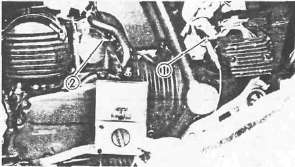
1 Blue lead
2 Ground
HORN
1. Check:
|
Check for: |
Horn inoperative |
|
12V on brown lead to horn |
|
|
Good ground (horn/pink wire) when horn button is pressed |
|
|
Faulty |
Defective components — Replace.
NOTE:
There are individual fuses for various circuits (See Complete Circuit Diagram)
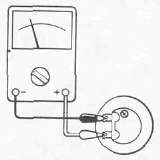
2. Measure the horn resistance
Horn Resistance: 1.05Ω ± 10%
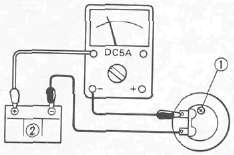
3. Adjust the volume. Turn the adjuster 1 in and out so that the volume is maximum at the maximum amperage.
2 Battery (12V)
|
Tester's lead wire |
Maximum Amperage |
Tester's range |
|
|
Red lead |
Black lead |
||
|
Battery (+) lead |
Horn lead and Battery (-) lead |
2.0A |
DC5A |
BRAKE LIGHT
|
Check for: |
Brake light inoperative |
|
Defective bulb |
|
|
12V on yellow lead to brake light |
|
|
12V on brown lead to each brake light switch (Front and rear brake switch) |
Switches
SwitchesSWITCHES
Use Pocket Tester (90890-03112) on "Ohm x 1" scale to check the switches. Replace any "shorted" or opened element.
Main Switch
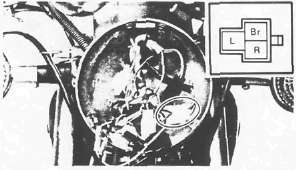
|
Switch position |
Lead color |
R |
Br |
L |
ON |
|
|
|
OFF |
|
|
|
P |
|
|
|
"ENGINE STOP" Switch
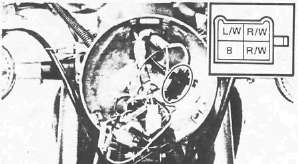
|
Switch position |
Lead color |
R/W |
R/W |
RUN |
|
|
OFF |
|
|
"START" Switch
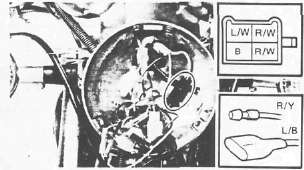
|
Switch position |
Lead color |
L/W |
B |
R/Y |
L/B |
OFF |
|
|
|
|
ON |
|
|
|
|
"LIGHTS" (Dimmer) Switch
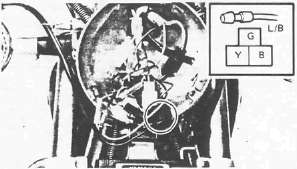
|
Switch position |
Lead color |
Y |
L/B |
G |
HI |
|
|
|
LO |
|
|
|
"HORN" Switch
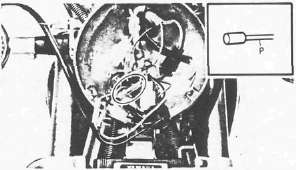
|
Switch position |
Lead color |
P |
Ground or B |
PUSH |
|
|
OFF |
|
|
'TURN" Switch
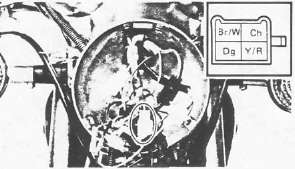
|
Switch position |
Lead color |
Dg |
Br/W |
Ch |
Y/R |
B |
R |
|
|
|
|
|
N |
R |
|
|
|
|
|
N |
|
|
|
|
|
L |
|
|
|
|
|
L |
|
|
|
|
|
Oil Level Switch
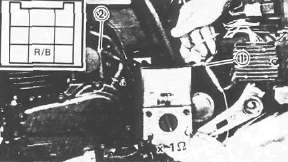
|
Switch position |
Lead color |
R/B |
Ground |
ON |
|
|
OFF |
|
|
Front Brake Switch
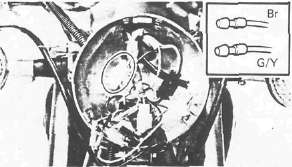
|
Switch position |
Lead color |
Br |
G/Y |
ON |
|
|
OFF |
|
|
Rear Brake Switch
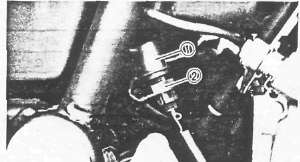
1 Switch body
2 Adjusting nut
|
Switch position |
Lead color |
Y |
Y |
ON |
|
|
OFF |
|
|
Cooling System
Cooling SystemCOOLING SYSTEM
3 Main switch
4 Fuse "FAN" (10A)
5 Thermo switch
6 Fan motor
18 Temperature meter
19 Thermo unit
35 Fuse "SIGNAL" (15A)
48 Battery
49 Fuse "MAIN" (30A)
TROUBLESHOOTING CHART (1)
|
TEMPERATURE GAUGE DOES NOT OPERATE. |
||
|
▼ |
||
|
Remove the fuel tank. |
||
|
▼ |
||
|
Turn the main switch "ON". |
||
|
▼ |
||
|
Disconnect the thermo unit connector. Check the battery voltage (12V) on Green/Red lead from the wire harness, |
No |
Check for an open or poor connection between the fuse "SIGNAL" and thermo unit connector. |
|
▼ Yes |
||
|
Disconnect the thermo unit connector. Connect the Green/Red lead from the wire harness to "ground" on the frame; use a jumper lead 1 . |
No ► |
Replace the temperature gauge. |
|
▼ |
|
|
|
The temperature gauge needle will swing from "C" to "H". |
||
|
▼ Yes |
||
|
Replace the thermo unit. |
TROUBLESHOOTING CHART (2)
|
ELECTRIC FAN MOTOR DOES NOT OPERATE. |
||
|
▼ |
||
|
Disconnect the thermo switch 1 lead.
|
||
|
▼ |
||
| Check for the battery voltage (12V) on Brown lead from the wire harness. | No ► |
Check for an open or poor connection between the fuse "FAN" and thermo switch connector. |
| ▼ Yes | ||
|
Connect the Brown lead and Blue lead; use a jump lead 1 .
|
||
| ▼ | ||
| The fan motor operates. | No ► |
Replace the fan motor. |
| ▼ Yes | ||
| Replace the thermo switch. | ||
THERMO UNIT AND THERMOMETER
Operation
The thermo unit has less resistance at higher temperatures and thus allows more current to pass through. When more current flows to the coil in the temperature gauge; the armature to which the needle is attracted by the increased magnetic field. In this way, the needle indicates the temperature.
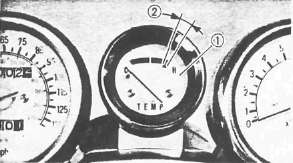
1 Temperature gauge
2 Red zone
Thermo Unit Inspection
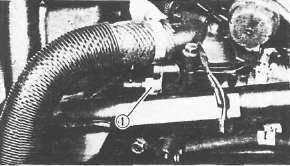
1. Remove:
• Thermo unit 1
CAUTION:
Handle the thermo unit with special care. Never subject it to strong shock or allow it to be dropped. Should it be dropped, it must be replaced.
2. Check the thermo unit operation
Thermo unit inspection steps:
• Immerse thermo-unit in water.
• Check continuity at indicated temperatures. Note temperatures while heating the water.
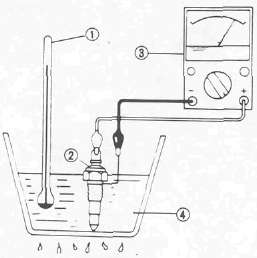
1 Temperature gauge
2 Thermo unit
3 Pocket tester
4 Water
|
Water Temperature |
50°C (122°F) |
100°C (212°F) |
120°C (248°F) |
|
Resistance |
156Ω |
28.4Ω |
17Ω |

3. Install the thermo unit 2
4. Tighten the thermo unit
Thermo Unit 2 : 15 Nm (1.5m-kg, 11 ft lb)
CAUTION:
After replacing the thermo unit, check the coolant level in the radiator and also check for any leakage.
ELECTRIC FAN AND THERMO SWITCH
Operation
The electric fan will be switched ON or OFF according to the coolant temperature in the radiator.
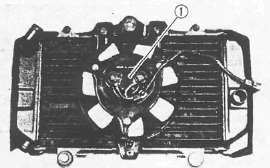
1 Electric fan motor
NOTE:
The electric fan is controlled by the thermo switch when the main switch is "ON". Thus, under certain operating conditions, this fan may continue to run until the engine temperature has cooled down to about 98°C (208.4°F).
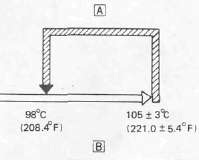
A THERMO SWITCH "ON"
B COOLANT TEMPERATURE
|
The following problems may require repair or replacement of components |
|
|
Component |
Condition |
|
Fan motor |
Unsmooth operation |
|
Fan motor bracket |
Cracks |
|
Securing bolts |
Looseness |
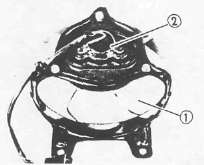
1 Fan
2 Electric fan motor
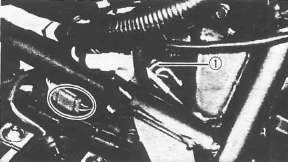
Thermo Switch Inspection
1. Remove the thermo switch 1
CAUTION:
Handle the thermo switch very carefully. Never subject it to strong shock or allow it to be dropped. Should it be dropped, it must be replaced.
2. Inspect the thermo switch operation
Thermo switch inspection steps:
• Immerse thermo switch in oil.
• Check continuity as indicated temperatures. Note temperatures while heating the oil.
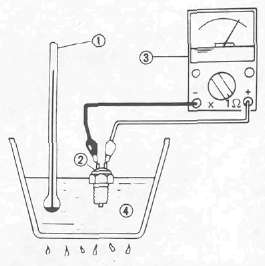
1 Temperature gauge
2 Thermo switch
3 Pocket Tester
4 Oil
|
Test step |
Oil temperature |
Pocket Tester (Ω x 1) |
|
1 |
0- 98°C (32~208.4°F) |
Discontinuity |
|
2 |
More than 105°±3°C (more than 221.0 ±5.4°F) |
Continuity |
|
3* |
105 to 98°C (221.0- 208.4°F) |
Continuity |
|
4* |
less than 98°C (less than 208.4°F) |
Discontinuity |
Test 1 & 2: Heat-up tests
Test 3* & 4*: Cool-down tests
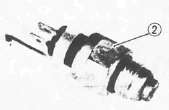
3. Install the thermo switch 2
Thermo Switch 2 : 23 Nm (2.3 m-kg, 27 ft-lb)
CAUTION:
After replacing ther thermo switch, check the coolant level in the radiator and also check for any leakage.
Chapter 8, APPENDICES
Chapter 8, APPENDICESGeneral Specifications
General SpecificationsGENERAL SPECIFICATIONS
|
Item |
Model |
XJ750XN |
Model Code Number Federal V.I.N. Number Engine Starting Number |
1FL JYA1FL00 * FA000101 1FL-000101 |
Dimensions: Overall Length Overall Width Overall Height Seat Height Wheelbase Minimum Ground Clearance |
2,235 mm (88.0 in) 775 mm (30.5 in) 1,160 mm (45.7 in) 760 mm (29.9 in) 1,520 mm (59.8 in) 145 mm ( 5.7 in) |
Basic Weight: With Oil and Full Fuel Tank |
232 kg (511 lb) |
Minimum Turning Radius: |
2,800 mm (110.2 in) |
Engine: Engine Type Cylinder Arrangement Displacement Bore x Stroke Compression Ratio Compression Pressure Starting System |
Liquid cooled 4-stroke, gasoline, DOHC 4-cylinder parallel 749 cm3 (45.69 cu.in) 68.0 x 51.6 mm J2.677 x 2.032 in) 11.2:1 1,098 kPa (11.2 kg/cm2, 159 psi) at 300 r/min Electric starter |
Lubrication System: |
Pressure lubricated, wet sump |
Oil Type of Grade: Final Gear Oil |
Yamalube 4-cycle oil or SAE 20W40 type SE motor oil (If temperature does not go below 5°C (40°F).) SAE 10W30 type SE motor oil (If temperature does not go above 15°C (60°F).)
SAE 80API "GL-4" Hypoid gear oil |
Oil Capacity: Engine Oil: Periodic Oil Change With Oil Filter Replacement Total Amount Final Gear Case Oil Amount |
2.5 L(2.2 lmpqt,2.6USqt) 2.8 L (2.5 Imp qt, 3.0 US qt) 3.5 L(3.1 Impqt, 3.7USqt) 0.2 L(0.18 Impqt, 0.21 US qt) |
Radiator Capacity: (Includingall routes) |
2.4 L (2.1 Impqt, 2.5 US qt) |
Air Filter: |
Dry type element |
Fuel: Type Tank Capacity Reserve Amount |
Regular gasoline 13 L(2.9 Imp gal, 3.4 US gal) 3 L (0.7 Imp gal, 0.8 US gal) |
Carburetor: Type Manufacturer |
BS33 x 4, Constant velocity MIKUNI |
|
XJ750XN |
Spark Plug: Type/Manufacturer Gap |
D8ES /NGK or X24ES-U /NIPPONDENSO 0.6 - 0.7 mm (0.024 - 0.028 in) |
Clutch Type: |
Wet, multiple-disc |
Transmission: Primary Reduction System Primary Reduction Ratio Secondary Reduction System Secondary Reduction Ratio Transmission Type Operation Gear Ratio 1st 2nd 3rd 4th 5th |
Spur gear 97/58(1.672) Shaft drive 49/36 x 19/18x32/11 (4.179) Constant-mesh, 5-speed Left foot operation
35/16(2.187) 30/20(1.500) 30/26(1.153) 28/30 (0.933) 26/32(0.812) |
Chassis: Frame Type Caster Angle Trail |
Tubular steel, double cradle 31.5° 120 mm (4.72 in) |
Tire: Type Size(F) Size(R) |
Tubeless 100/90-19 57 H 130/90-16 67H |
Tire Pressure (Cold Tire): Up to 90 kg (198 lb) load* 90 kg (1981b) load- 238 kg (525 lb) load* High Speed Riding *Load is the total weight of cargo, rider, passenger, and accessories. |
FRONT |
REAR |
177 kPa (1.8 kg/cm2, 26 psi) |
196 kPa (2,0 kg/cm2, 28 psi) |
196 kPa (2.0 kg/cm2, 28psi) |
275 kPa (2.8 kg/cm2, 40 psi) |
206 kPa (2.1 kg/cm2, 30psi)
|
226 kPa (2.3 kg/cm2, 32psi) |
Brake: Front Brake Type Operation Rear Brake Type Operation |
Dual disc brake Right hand operation Drum brake Right foot operation |
Suspension: Front Suspension Rear Suspension |
Telescopic fork Swingarm |
Shock Absorber: Front Shock Absorber Rear Shock Absorber |
Coil-Air spring, oil damper Coil spring, oil damper |
Wheel Travel: Front Wheel Travel Rear Wheel Travel |
150 mm (5.9 in) 99 mm (3.9 in) |
Electrical: Ignition System Generator System Battery Type or Model Battery Capacity |
T.C.I. A.C. Generator YB14L 12V 14AH |
Headlight Type: | Semi-sealed beam (Quartz bulb) | Bulb Wattage x Quantity: Headlight Tail/Brake Light Flasher Light | 12V,60W/55W 12V,8W/27Wx2 12V, 27Wx4 |
Indicator Light: Wattage x Quantity:
|
Meter Light "NEUTRAL" "HIGH BEAM" "TURN" "OIL LEVEL" "FUEL" |
12V, 3Wx4 12V, 3Wx 1 12V,3Wx1 12V,3Wx2 12V,3Wx1 12V, 3Wx1 |
Maintenance Specifications -- Engine 750X
Maintenance Specifications -- Engine 750X
|
Model |
XJ750XN |
Cylinder Head: Warp Limit |
0.03 mm (0.0012 in) |
|
*Lines indicate straightedge measurement. |
Cylinder: Bore Size Taper Limit Out-of Round Limit |
68.000 ~ 68.005 mm (2.6772 ~~ 2.6774 in) 0.05 mm (0.002 in) 0.05 mm (0.002 in) |
Camshaft: Drive Method Cam Cap Inside Diameter Camshaft Outside Diameter Shaft to Cap Clearance |
Chain drive (Center) 24.5+0.021-0 mm (0.9646+0.008-0 in) 24.5-0.050-63 mm (0.9646-0.0020-0.0025 in) 0.050 - 0.084 mm (0.0020 - 0.0033 in) |
Cam Dimensions: |
|
Intake "A" <Limit> "B" <Limit> "C" |
32.55-32.65 mm (1.2815- 1.2854 in) 32.45 mm (1.2776 in) 24.95 ~ 25.05 mm (0.9823 - 0.9862 in) 24.85 mm (0.9783 in) 7.5 - 7.7 mm (0.2953 ~ 0.3031 in) |
Exhaust "A" <Limit> "B" <Limit> "C" |
32.40 ~ 32.50 mm (1.2756 - 1.2795 in) 32.30 mm (1.2717 in) 24.95 - 25.05 mm (0.9823 - 0.9862 in) 24.85 mm (0.9783 in) 7.35 - 7.55 mm (0.2894 - 0.2972 in) |
|
Model |
XJ750XN |
Camshaft Runout Limit Cam Chain Type/Number of Links Cam Chain Adjustment Method |
0.03 mm (0.0012 in) Bush chain/112 Automatic |
Valve Clearance (Cold) IN. EX. |
0.11 - 0.20 mm (0.004 - 0.008 in) 0.21 - 0.30 mm (0.008 - 0.012 in) |
Valve Dimensions |
|
"A" Head Dia. "B" Face Width "C" Seat Width "D" Margin Thickness |
|
Stem Outside Diameter <Limit> |
5-0.010-25 mm (0.1969-0.0004-0.0010 in) 4.945 mm (0.1947 in) |
Guide Inside Diameter <Limit> |
5.05 mm (0.199 in) |
Stem-to Guide Clearance <Limit> |
0.010-0.037 mm (0.0004 - 0.0015 in) 0.08 mm (0.003 in) |
Stem-Runout Limit |
0.01 mm (0.0004 in) |
Valve Spring: Free Length Installed Length (Valve Closes) |
|
|
Model |
XJ750N |
Tilt Limit
Inner Spring IN. & EX. Outer Spring IN. & EX.
|
2.5° or 1.7 mm (0.067 in) 2.5° or 1.7 mm (0.067 in)
|
Direction of Winding |
|
Piston: |
Piston Size "D"/ |
68.00-0.012-0.075 mm (2.672-0.0024-0.0030 in) 5 mm (0.20 in) (From bottom line of piston skirt) |
Clearance Between Piston & Cylinder <Limit> Oversize: |
0.06 - 0.08 mm (0.0024 - 0.0031 in) 0.1 mm (0.004 in) 68.50 mm (2.697 in) |
Piston Ring: |
|
Sectional Sketch |
Top Ring
2nd Ring
Oil Ring
|
Barrel Taper Expander
|
|
End Gap (Installed): Top Ring 2nd Ring Oil Ring |
0.30 ~ 0.45 mm (0.012 ~ 0.018 in) 0.20 - 0.35 mm (0.008 - 0.014 in) 0.20 - 0.7 mm (0.008 - 0.028 in) |
Side Clearance: Top Ring 2nd Ring |
0.03 - 0.07 mm (0.0012 - 0.0028 in) 0.03 ~~ 0.07 mm (0.0012 - 0.0028 in) |
|
Model |
XJ750XN |
Connecting Rod: Oil Clearance |
0.032 - 0.056 mm (0.0013 - 0.0022 in) |
Crankshaft: |
|
|
Crank Width "A" Runout Limit "B" Big End Side Clearance "C" Journal Clearance |
341.4 ± 0.6 mm (13.441 ± 0.024 in) 0.03 mm (0.0012 in) 0.160 ~ 0.262 mm (0.0063 - 0.0103 in) 0.020 ~ 0.044 mm (0.0008- 0.0017 in) |
Bearing: Color Code (Corresponding Size) |
1. Blue 1.5 +0.006+0.002 mm (0.0591+0.00024+0.00007 in) 2. Black 1.5 +0.002-0.002 mm (0.0591+0.00007-0.00007 in) 3. Brown 1.5 -0.002-0.006 mm (0.0591-0.00007-0.00024 in) 4. Green 1.5 -0.006-0.010 mm (0.0591-0.00024-0.00039 in) 5. Yellow 1.5 -0.010-0.014 mm (0.0591-0.00039-0.00056 in) |
Clutch: Friction Plate Thickness x Quantity Clutch Plate Thickness x Quantity Warp Limit Clutch Spring Free Length x Quantity Clutch Release Method |
3.0 mm (0.12 in) x 8 2.0 mm (0.079 in) x 7 50.5 mm (2.031 in) x6 Outer Pull |
Transmission: Main Axle Deflection Limit Drive Axle Deflection Limit |
0.08 mm (0.0031 in) 0.08 mm (0.0031 in) |
Shifter: Shifter Type Guide Bar Bending Limit |
Guide bar 0.1 mm (0.004 in) |
Carburetor: Type/Manufacturer/Quantity I.D. Mark Main Jet (MJ.) Main Air Jet (M.AJ.) Jet Needle-clip Position (J.N.) Needle Jet (N.J.) Throttle Valve (Th.V) Pilot Jet (P.J.) Pilot Outlet Size (P.O.) Pilot Air Jet (P.A.J.) Pilot Screw (P.S.) Valve Seat Size (V.S.) Starter Jet (G.S.) Bypath Size (B.P.) Fuel Level (F.L) Float Height (F.H.) Engine Idling Speed Vacuum Pressure at Idling Speed Vacuum Synchronous Difference
|
BS33/MIKUNI/4 1FL00 #105 #120 5FZ83 Y-2 #130 #37.5 00.8 #140 2-1/2 ± 1/2 02.3 *35 00.9 3.0 ± 1.0 mm (0.12 ± 0.04 in) 17.5 ± 1.0 mm (0.69 ± 0.04 in) 1,050± 50r/min 24 ± 1.3 kPa (180± 5 mmHg, 7.1 ± 0.2 inHg) Below 0.7 kPa (5 mmHg, 0.2 inHg)
|
|
|
XJ750XN |
Lubrication System: Oil Filter Type Oil Pump Type Tip Clearance Side Clearance Bypass Valve Setting Pressure Relief Valve Operating Pressure |
Paper Trochoid pump 0.03 ~ 0.09 mm (0.0012 - 0.0035 in) 0.03 ~ 0.08 mm (0.0012 ~ 0.0031 in) 98.0 ± 20kPa (1.0+ 0.2 kg/cm2, 14.2 ± 2.8 psi) 490±49kPa(5.0± 0.5 kg/cm2, 71 ± 7.1 psi) |
Lubrication Chart |
|
|
Cooling System: Radiator Core Size Radiator Cap Opening Pressure |
300 mm (11.8 in) 78 - 98 kPa (0.8 - 1.0 kg/cm2, 11.4- 14.2 psi) |
Coolant: Total Amount Reservoir Tank Capacity <From Low to FULL Level> |
24.0L (2.11 lmp. qt, 2.54US qt) 0.49 L (0.43 Imp qt, 0.52 US qt) 0.14 L (0.12 Imp. qt, 0.15 US qt) |
Water Pump: Type |
Single Suction Centrifugal Pump |
Thermostat: Opening Temperature Full Open Temperature/Lift |
82°C(180°F) 95°C (203°F)/8mm (0.31 in) |
Shaft Drive: Middle Gear Backlash: Final Gear Backlash: |
0.1 ~ 0.2 mm (0.004 - 0.008 in) 0.1 ~ 0.2 mm (0.004 - 0.008 in) |
|
|
XJ750XN |
Headlight Type: |
Semi-sealed beam (Quartz bulb) |
Bulb Wattage x Quantity: Headlight |
12V, 60W/55W |
Indicator Light: Wattage x Quantity: |
|
Specifications -- Engine fasteners torque settings
Specifications -- Engine fasteners torque settings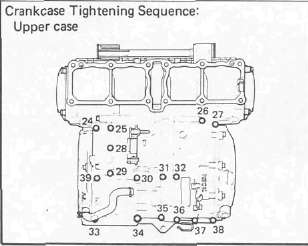
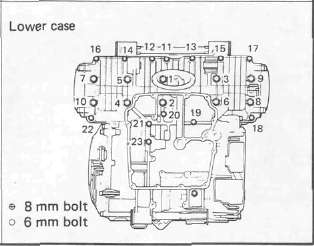
|
Part to be tightened |
Part name |
Thread size |
Q'ty |
Tightening torque |
Remarks |
Nm |
m kg |
ftlb |
Spark plug Cylinder head Cylinder head cover Can cap Can sprocket Can case-Cylinder head Oil check bolt Cover (cylinder head) Drain bolt (cylinder) Cam chain tensioner end plug Cam chain tensioner Cam chain guide Connecting rod Carburetor cover Carburetor joint Air cleaner case cap Air cleaner case Exhaust pipe-Engine Exhaust pipe-Chamber Chamber Chamber-Muffler Muffler stay Muffler |
N/A Nut Bolt Bolt Bolt Bolt Bolt Bolt Bolt Bolt Bolt Bolt Nut Screw Bolt Screw Bolt Nut Bolt Bolt Bolt Bolt Bolt |
M12 P1.25 M9 P1.25 M6 P1.0 M6 P1.0 M7 P1.0 M6 P1.0 M6 P1.0 M6 P1.0 M6 P1.0 M8 P1.25 M6 P1.0 M6 P1.0 M8 P0.75 M5 P0.8 M6 P1.0 M5 P1.0 M6 P1.0 M6 P1.0 M8 P1.25 M8 P1.25 M8 P1.25 M8 P1.25 M8 PI.25 |
4 8 8 40 4 11 1 4 2 1 2 1 8 4 8 3 2 8 4 1 2 2 2 |
17.5 37 10 10 20 10 10 10 10 9 10 10 36 5 12 5 7 10 20 25 25 20 20 |
1.75 3.7 1.0 1.0 2.0 1.0 1.0 1.0 1.0 0.9 1.0 1.0 3.6 0.5 1.2 0.5 0.7 1.0 2.0 2.5 2.5 2.0 2.0 |
12.5 27 7.2 7.2 14 7.2 7.2 7.2 7.2 6.5 7.2 7.2 25 3.6 8.7 3.6 5.1 7.2 14 18 18 14 14 |
Oil
Oil
|
|
Part to be tightened |
Part name |
Thread size |
Q'ty |
Tightening torque |
Remarks |
Nm |
m-kg |
ft-lb |
Oil filter Drain bolt Oil pan Oil pump sprocket Oil pump Oil pump cover Oil delivery pipe Conduit Thermostatic valve Air bleed screw Thermostatic valve cover Radiator Drain bolt (radiator pipe) Drain bolt (radiator) Water pump drive gear cover Water pump drive gear Water pump joint Joint (cylinder) Crankcase Crankcase Main gallery A.C.G. cover Brush A.C. Generator A C.G. bearing housing Starter motor Timing plate Stationaly pointer Pickup coil Clutch cover Clutch cable holder Pressure plate Clutch boss Shift pedal Shift cover Drive axle bearing housing Starter clutch outer Stopper plate (starter idle gear shaft) Drive chain guide (starter) Middle gear: Bearing housing Bearing stopper plate Drive shaft bearing Driven shaft bearing Middle gear flange |
Bolt Bolt Bolt Bolt Bolt Screw Bolt Bolt Bolt Bolt Bolt Bolt Bolt Bolt Screw Bolt Bolt Bolt Bolt Bolt Plug Bolt Screw Bolt TORX screw Bolt Bolt Screw Screw Bolt Bolt Bolt Nut Bolt Bolt Bolt Bolt Bolt Bolt Bolt TORX screw Nut Nut Nut |
M20 P1.5 M14P1.5 M6 P1.0 M6 P1.0 M6 P1.0 M6 P1.0 M10 P1.25 M6 P1.0 M6 P1.0 M6 P1.0 M6 P1.0 M6 P1.0 M6 P1.0 M8 PI.25 M6 P1.0 M6 P1.0 M6 P1.0 M6 P1.0 M8 P1.25 M6 P1.0 M20 P1.5 M6 P1.0 M6 P1.0 M10 P1.25 M6 P1.0 M6 P1.0 M8 PI.25 M6 P1.0 M6 P1.0 M6 P1.0 M6 P1.0 M6 P1.0 M20 P1.0 M6 P1.0 M6 P1.0 M6 P1.0 M8 P1.25 M6 P1.0 M6 P1.0 M8 PI .25 M8 P1.25 M34P1.0 M65P1.5 M14P1.5 |
1 1 13 1 3 4 3 2 1 1 2 3 1 1 2 1 1 4 19 20 2 3 2 1 3 2 1 1 2 10 2 6 1 1 10 3 3 1 2 4 4 1 1 1 |
15 43 12 12 12 7 21 7 10 10 10 7 7 2.9 8 12 10 10 24 12 12 12 8 55 10 7 24 8 8 12 12 8 70 8 12 12 25 8 8 25 25 110 110 90 |
1.5 4.3 1.2 1.2 1.2 0.7 2.1 0.7 1.0 1.0 1.0 0.7 0.7 0.3 0.8 1.2 1.0 1.0 2.4 1.2 1.2 1.2 0.8 5.6 1.0 0.7 2.4 0.8 0.8 1.2 1.2 0.8 7.0 0.8 1.2 1.2 2.5 0.8 0.8 2.5 2.5 11 11 9.0 |
11 31 8.7 8.7 8.7 5.1 15 5.1 7.2 7.2 7.2 5.1 5.1 2.2 5.8 8.7 7.2 7.2 17 8.7 8.7 8.7 5.8 40 7.2 5.1 17 5.8 5.8 8.7 8.7 5.8 50 5.8 8.7 8.7 18 5.8 5.8 18 18 80 80 65 |
-- -- -- -- -- -- -- -- -- -- -- -- -- -- -- oil -- -- oil oil oil -- -- -- oil -- -- -- -- -- -- -- -- -- -- -- Stake / oil -- -- oil -- Stake -- Stake / oil |
Maintenance Specifications -- Chassis
Maintenance Specifications -- ChassisChassis
|
Steering System: Steering Bearing Type |
Taper Roller Bearing |
Front Suspension: (Each) Front Fork Travel Fork Spring Free Length Spring Rate/Stroke Optional Spring Oil Capacity Oil Grade Enclosed Air Pressure: Standard Minimum- Maximum |
150 mm (5.9 in) 511 mm (20.1 in) K, = 3.92 N/mm (0.40 kg/mm, 22.4 lb/in) 0- 100 mm (0- 3.94 in) K2 = 4.90 N/mm (0.50 kg/mm, 28 lb/in) 100- 150 mm (3.94- 5.90 in) No. 389 cm3 (13.7 Imp oz, 13.2 US oz) YAMAHA Fork & Shock Oil 10wt or equivalent fork oil 39.2 kPa (0.4 kg/cm2, 5.7 psi) Zero- 118 kPa (Zero - 1.2 kg/cm2, Zero - 17.1 psi) |
Rear Suspension: (Each) Shock Absorber Travel Spring Free Length Spring Fitting Length Spring Rate/Stroke |
70 mm (2.76 in) 243.5 mm (9.59 in) 217.5 mm (8.56 in) K, = 21.6 N/mm (2.2 kg/mm, 123.2 lb/in) |
Rear Arm: Swingarm Free Play Limit: |
|
Wheel: Front Wheel Type Rear Wheel Type Front Rim Size/Material Rear Rim Size/Material Rim Runout Limit: |
Cast Wheel Cast Wheel MT2.15x 19/Aluminum MT3.00x 16/Aluminum
|
Disc Brake: Outside Dia. x Thickness |
267 x 5 mm (10.5 x 0.2 in) |
Pad Thickness:
|
Inner Outer |
5.5 mm (0.22 in) 5.5 mm (0.22 in) |
Master Cylinder Inside Dia. Caliper Cylinder Inside Dia. Brake Fluid Type |
15.87 mm (0.62 in) 38.18 mm (1.50 in) DOT #3 |
Drum Brake: Type Rear Drum Inside Dia. <Limit> Lining Thickness <l_imit> Shoe Spring Free Length
|
Leading trailing 200 mm (7.87 in) 201 mm (7.91 in) 4 mm (0.16 in) 2 mm (0.08 in) 68 mm (2.7 in)
|
Brake Lever & Brake Pedal:
Brake Lever Free Play Brake Pedal Position Brake Pedal Free Play |
2-5mm (0.08 - 0.20 in)/at lever end 10 mm (0.4 in) below the top of the footrest 20-30mm (0.8- 0.12 in) |
Clutch Lever Free Play: | 2 - 3 mm (0.08 - 0.12 in)/at lever pivot |
Tightening torque
|
Part to be tightened |
Part name |
Thread size |
Q'ty |
Tightening torque |
Remarks |
Nm |
m-kg |
fflb |
Engine mounting bolt: |
|
|
|
42 |
4.2 |
30 |
|
Rear |
Nut |
M12 P1.25 |
2 |
90 |
9.0 |
65 |
|
Engine mounting stay |
Nut |
M8 P1.25 |
4 |
33 |
3.3 |
24 |
|
Downtube |
Bolt |
M8 P1.25 |
4 |
33 |
3.3 |
24 |
|
Downtube & Cross pipe |
Nut |
M8 P1.25 |
2 |
33 |
3.3 |
24 |
|
Handle crown & Steering shaft |
Nut |
M20 P1.0 |
1 |
110 |
11 |
80 |
Ring nut (Lower) |
Nut |
M22 P1.0 |
1 |
6 |
0.6 |
4.3 |
See page 6-25 |
Handle crown & Inner tube |
Nut |
M8 P1.25 |
2 |
20 |
2.0 |
14 |
|
Handle crown & Handlebar holder |
Bolt |
M8 PI.25 |
4 |
20 |
2.0 |
14 |
|
Under bracket & Inner tube |
Bolt |
M8 PI.25 |
4 |
23 |
2.3 |
17 |
Front wheel axle |
Nut castle |
M14 P1.5 |
1 |
105 |
10.5 |
75 |
|
Front wheel axle pinch bolt |
Nut self locking |
M8 P1.25 |
1 |
20 |
2.0 |
14 |
|
Pivot shaft (Right) |
Bolt |
M22P1.5 |
1 |
5.5 |
0.55 |
4.0 |
Taper roller bearing |
Pivot shaft (Left and Right) |
Bolt/Nut |
M22P1.5 |
1 |
100 |
10.0 |
72 |
|
Rear wheel axle |
Nut castle |
M14P1.5 |
1 |
105 |
10.5 |
75 |
|
Rear wheel axle pinch bolt |
Bolt |
M8 P1.25 |
1 |
20 |
2.0 |
14 |
Rear shock absorber (Upper). |
Nut cap |
M8 P1.25 |
2 |
20 |
2.0 |
14 |
Rear shock absorber (Lower) |
L Nut cap R Bolt |
M10P1.25 |
2 |
30 |
3.0 |
22 |
|
Footrest |
Bolt |
M8 P1.25 |
4 |
29 |
2.9 |
21 |
|
Tension bar & Brake plate |
Bolt |
M8 P1.25 |
1 |
20 |
2.0 |
14 |
|
Tension bar & Rear arm |
Bolt |
M8 P1.25 |
1 |
20 |
2.0 |
14 |
|
Camshaft lever & Camshaft |
Bolt |
M6 P1.0 |
1 |
9 |
0.9 |
6.5 |
|
Disc brake section: Brake disc & Hub (Front) |
Bolt |
M8 P1.25 |
12 |
20 |
2.0 |
14 |
|
Master cylinder & Brake hose (Front) |
Bolt union |
M10 P1.25 |
1 |
26 |
2.6 |
19 |
|
Brake hose & Joint |
Bolt union |
M10 P1.25 |
1 |
26 |
2.6 |
19 |
|
Caliper & Brake hose |
Bolt union |
M10 P1.25 |
2 |
26 |
2.6 |
19 |
|
Caliper & Front fork (Front) |
| |
M10 P1.25 |
4 |
35 |
3.5 |
25 |
|
Caliper bleed screw (Ftont) |
I |
M8 P1.25 |
2 |
6 |
0.6 |
4.3 |
|
Front fender |
Bolt |
M6 P1.0 |
4 |
9 |
0.9 |
6.5 |
|
Final gear & Rear arm |
Nut |
M10P1.25 |
4 |
42 |
4.2 |
30 |
Final gear: |
Drive shaft |
Nut |
M14P1.5 |
1 |
110 |
11 |
80 |
Oil |
Bearing housing |
Flange bolt |
M8 PI.25 |
4 |
25 |
25 |
18 |
Bearing housing |
Nut |
M8 P1.25 |
6 |
23 |
2.3 |
17 |
Oil filler cap |
Plug |
M14P1.5 |
1 |
23 |
2.3 |
17 |
Oil drain screw |
Plug |
M14P1.5 |
1 |
23 |
2.3 |
17 |
Bearing retainer |
- |
M65P1.5 |
1 |
110 |
11 |
80 |
Left-hand thread |
Cross joint |
Hexagon bolt with washer |
M8 PI .25 |
4 |
44 |
4.4 |
32 |
Muffler bracket & Frame |
Bolt |
M8 PI.25 |
3 |
23 |
2.3 |
17 |
Rear fender |
Bolt |
M10P1.25 |
2 |
32 |
3.2 |
23 |
Muffler bracket & Muffler |
Bolt |
M10P1.25 |
2 |
25 |
2.5 |
18 |
General Torque Specifications
General Torque SpecificationsGENERAL TORQUE SPECIFICATIONS
This chart specifies torque for standard fasteners with standard l.S.O. pitch threads. Torque specifications for special components or assemblies are included in the applicable sections of this book. To avoid warpage, tighten multi-fastener assemblies in a criss-cross fashion, in progressive stages, until full torque is reached. Unless otherwise specified, torque specifications call for clean, dry threads. Components should be at room temperature.
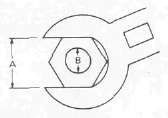
|
A (Nut) |
B (Bolt) |
General torque specifications |
Nm |
m-kg |
ft-lb |
10 mm |
6 mm |
6 |
0.6 |
4.3 |
12 mm |
8 mm |
15 |
1.5 |
11 |
14 mm |
10 mm |
30 |
3.0 |
22 |
17 mm |
12 mm |
55 |
5.5 |
40 |
19 mm |
14 mm |
85 |
8.5 |
61 |
22 mm |
16 mm |
130 |
13.0 |
94 |
DEFINITION OF UNITS
|
Unit |
Read |
Definition |
Measure |
mm cm |
millimeter centimeter |
10"3 meter 10-2 meter |
Length Length |
kg |
kilogram |
103 gram |
Weight |
N |
Newton |
1 kg x m/sec2 |
Force |
Nm |
Newton meter |
N x m |
Torque |
Pa N/mm |
Pascal Newton per millimeter |
N/m2 N/mm |
Pressure Spring rate |
L cm3 |
Liter Cubic centimeter |
|
Volume or Capacity |
r/min |
Rotation per minute |
|
Engine Speed |
Maintenance Specifications -- Electrical
Maintenance Specifications -- Electrical
Electrical
|
Voltage: 12V |
Ignition System: Ignition Timing (B.T.D.C.) 5° at 1,100 r/min |
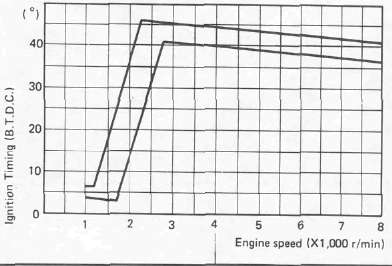 |
|
T.C.I.: Pickup Coil Resistance T.C.I. Unit — Model/Manufacturer |
120Ω ± 10% at 20°C (68°F) TID14-35/HITACHI |
Ignition Coil: Model/Manufacturer Minimum Spark Gap Primary Winding Resistance Secondary Winding Resistance |
CM12-25/HITACHI 6 mm (0.24 in) or more at 500 r/min 2.7Ω ± 10% at 20°C (68°F) 12 kΩ ± 20% at 20°C (68°F) |
Charging System: Type |
A.C. Generator |
A.C. Generator: Model/Manufacturer Nominal Output |
LD119-19/HITACHI 14V, 26A at 5,000 r/min |
|
Field Coil Resistance Stator Coil Resistance Brush Overall Length Brush Spring Pressure |
4.0Ω ± 10% at 20°C (68°F) (Direct) 0.46Ω ± 10% at 20°C (68°F) (White - White) 17 mm (0.67 in) 190-360 g (6.7- 12.7 oz) |
Voltage Regulator: Type Model/Manufacturer No Load Regulated Voltage |
Semi conductor. Field control SH233-12/SHINDENGEN 14.5 ± 0.3V |
Rectifier: Model/Manufacturer Capacity |
SH233-12/SHINDENGEN 35A |
Battery: Capacity Specific Gravity |
12V 14AH 1.280 |
|
Electric Starter System: Type Starter Motor: Model/Manufacturer Output Armature Coil Resistance Brush: Spring Pressure Commutator Diameter: Wear Limit Mica Undercut Starter Relay: Amperage Rating |
Constant-mesh type ADB4D2/NIPPONDENSO 0.6 kW 0.014Ω ±6% at 20°C(68°F)
12 mm (0.47 in) 800 ± 150 g (28.22 ± 5.29 oz) 28 mm (1.10 in) 27 mm (1.06 in) 0.4 - 0.8 mm (0.02 ~ 0.03 in)
150A |
Horn: Type x Quantity Model/Manufacturer Maximum Amperage |
Plain type x 2 CF12/NIKKO |
Relay Assembly: Model/Manufacturer Flasher Relay: Type Self Cancelling Device Flasher Frequency Wattage Starting-Circuit Cut-off Relay: Color Code |
FX257N2/NIPPONDENSO Semi Transistor Type Yes 60- 120cycle/min 27W x 2 pcs + 3W No. |
Sidestand Relay: Model/Manufacturer Color Code |
G2MW-D-3636/TATEISHI Blue |
Oil Level Switch: Model/Manufacutrer |
4H7/NIPPONDENSO |
Fuel Level Sender: Winding Coil Resistance |
1.1 ±0.2kΩ at20°C(68°F) |
Circuit Breaker: Type Amperage for Individual Circuit x Quantity: MAIN HEADLIGHT SIGNAL IGNITION FAN RESERVE |
Fuse
30Ax 1 15Ax 1 15Ax 1 10Ax 1 10Ax 1 30Ax 1 |
|
|
XJ750XN |
Headlight Type: |
Semi-sealed beam (Quartz bulb) |
Bulb Wattage x Quantity: Headlight |
12V, 60W/55W |
Indicator Light: Wattage x Quantity: |
|
Lubrication Diagrams
Lubrication DiagramsLUBRICATION DIAGRAM
Cable Routing
Cable RoutingCABLE ROUTING (1)
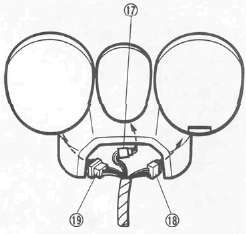
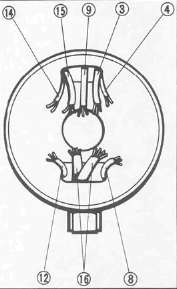
1 Cover
2 Meter
3 Handlebar switch (Left) lead
4 Clutch switch lead
5 Cable guide
6 Clutch cable
7 Starter cable
8 Front flasher light (Left) lead
9 Main switch lead
10 Front brake hose
11 Throttle cable
12 Front flasher light (Right) lead
13 Cable guide
14 Front brake switch lead
15 Handlebar switch (Right) lead
16 Wire harness
17 Black coupler
18 Red coupler
19 Brown coupler
A Pass the speedometer cable between under bracket and outer cover.
CABLE ROUTING (2)
1 Front brake hose
2 Radiator fan motor lead
3 Clutch cable holder
4 Battery negative (-) lead
5 Rear brake switch
6 Clamp
7 Clamp
8 Clutch cable
9 Starter cable
10 Wireharness
11 Throttle cable
12 Band
13 Clamp
14 Cover
15 Reservoir tank breather pipe
16 Reservoir tank
17 Radiator fan
18 Ignition coil
19 Radiator cap
20 Band
21Crankcase
22 Starter lead
A Pass the wireharness and throttle cable outside the cover 1.
B Pass the clutch cable between the air cleaner joint #3 and #4.
C Pass the hose between the radiator hose and cover 1.
D Pass the hose between the ignition coil and down tube
E Pass the hoses between the down tube and radiator
F Clamp the pick up coil lead and A.C. generator lead
CABLE ROUTING (3)
1 Horn lead (Left)
2 Ground lead
3 Clamp
4 Reservoir tank breather hose
5 Cable holder
6 Speedometer cable
7 Clamp
8 Front brake hose
9 Starter cable
10 Clutch cable
11 Throttle cable
CABLE ROUTING (4)
1 A.C. generator lead
2 Sidestand switch lead
3 lgniter lead
4 Diode assembly
5 Sidestand relay lead
6 Rectifier-regulator assembly
7 Neutral switch lead
8 Oil level switch lead
9 Pickup coil lead
10 Clamp
11 Sidestand switch assembly
12 Starter motor lead
13 Locating damper
14 Fuel sender
15 Battery negative (-) lead
16 Clamp
17 Sidestand switch lead
18 Pickup coil lead
19 Air cleaner drain hose
20 Battery breather hose
21 A.G. generator lead
22 Starter motor lead
23 Rear arm
24 Rear brake switch
A Insert the lead inside the bridge plate
B Push the fuel sender lead into the locating damper
CABLE ROUTING (5)
1 Ignition coil leads
2 Radiator fan motor lead
3 Thermostat lead
4 Horn lead (Right)
5 Earth lead
6 Wireharness
7 Band
8 Rear brake switch lead
9 Battery negative (-) lead
10 Starter switch lead
11 Fuse holder assembly
12 Rear flasher light lead (Right)
13 Clamp
14 Taillightlead
15 Rear flasher light lead (Left)
16 Ignition coil lead (Left)
17 Starter lead (Starter motor - Starter relay)
18 Battery positive (+) lead
19 Starter lead (Battery (+) - Starter relay)
20 To fuel sender
21 Relay assembly
22 Horn lead
23 Thermostat unit
24 Ignition coil (Right)
25 Ignition coil (Left)
26 "1"mark ->#1 cylinder
27 "2" mark -> #2 cylinder
28 "3" mark -> #3 cylinder
29 "4" mark -> #4 cylinder
A Align the white tape on wireharness with the cross tube.
B When installing the seat, be careful not to pinch the leads.
